Physical Address
304 North Cardinal St.
Dorchester Center, MA 02124
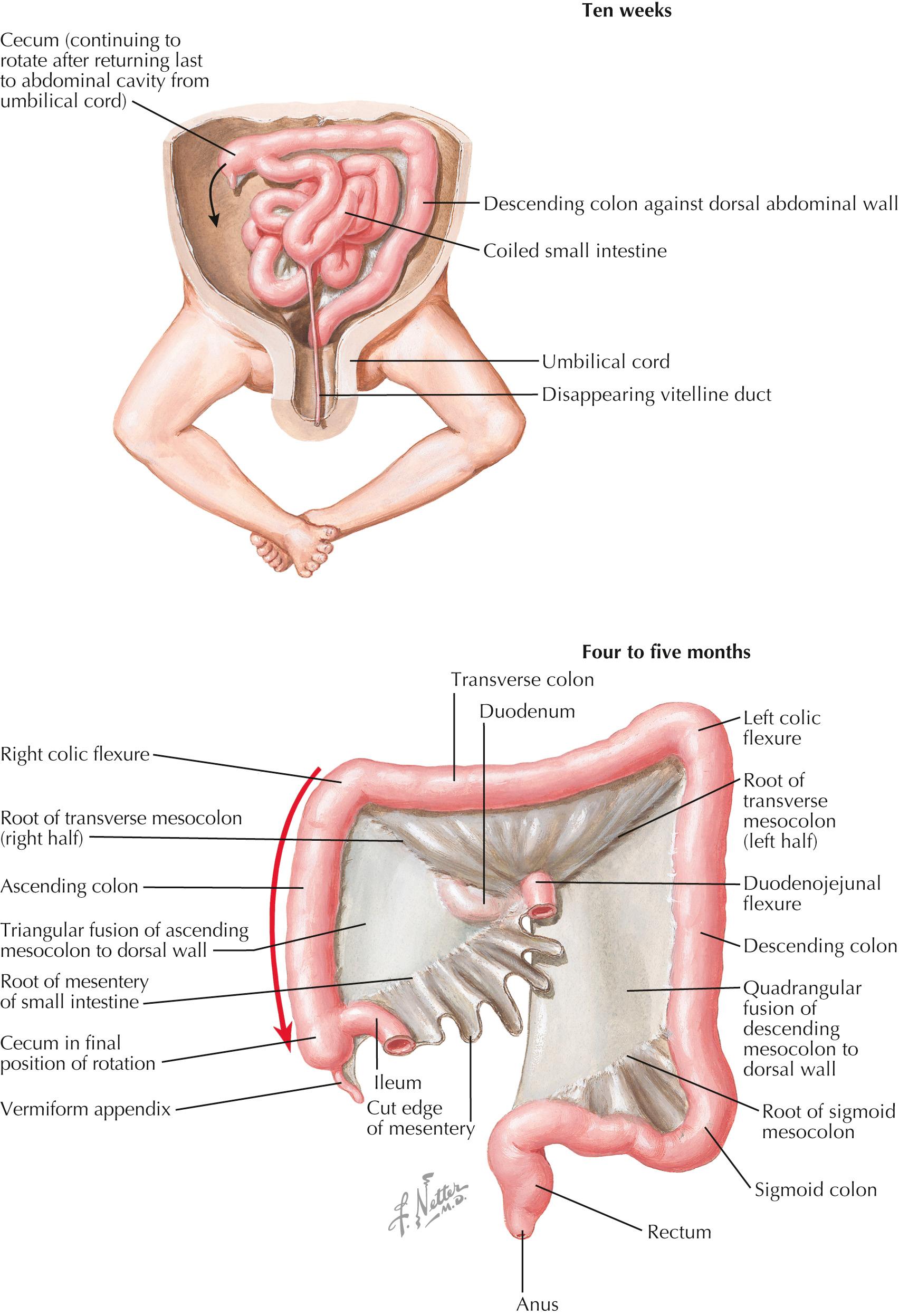
The development of the large intestine is intimately tied to the development of other organs. The cecum, appendix, ascending colon, and transverse colon are part of the midgut and develop alongside the jejunum and ileum. The descending colon, sigmoid colon, and rectum are hindgut structures and develop in conjunction with the urogenital system. During normal development, the midgut elongates tremendously and herniates into the umbilical cord during the fifth week. The proximal limb of the midgut loop produces the jejunum and ileum, and the distal limb differentiates into the distal ileum, cecum, appendix, ascending colon, and transverse colon. The distal limb of the midgut loop rotates from the inferior side of the umbilical cord to the left, then superiorly, and finally to the right as the midgut returns to the abdominal cavity during the 11th week. This explains why these structures are typically on the right side of the abdomen.
The cecum appears as a dilated area on the distal limb of the midgut during the sixth week, while it is still in the umbilical cord. By the eighth week, the appendix has begun to form as a small diverticulum in the cecum wall. It elongates as the cecum continues migrating to the right inferior region of the abdomen during the fetal period between 4 and 5 months. The dorsal mesentery of the cecum and ascending colon fuse to the parietal peritoneum of the posterior abdominal wall after the appendix has developed, and because of this the appendix may be found in many different locations relative to the cecum. In contrast with the retroperitoneal cecum and ascending colon, the transverse colon retains its mesentery and is a peritoneal structure. As the terminal end of the midgut, it travels from the right side of the abdomen across to the left, connecting with hindgut organs. In the process it passes anterior to the duodenum; this is one reason the dorsal mesentery of the duodenum is mostly fused with the parietal peritoneum. The descending colon, the first part of the hindgut, also loses its dorsal mesentery, fusing with the parietal peritoneum on the left side of the abdomen.
The hindgut is supplied by the inferior mesenteric artery and consists of the descending colon, sigmoid colon, and rectum. Although it does not take part in the physiologic herniation of the midgut, the hindgut must partition itself from the cloaca, separating the digestive system from the urogenital system. As described in the overview of development, the cloaca is divided into a urogenital sinus and rectum by a sheet of mesoderm, the urorectal septum. This also separates the cloacal membrane into a urogenital membrane and an anal membrane. The surface feature that marks the location of the urorectal septum is the perineal body, located anterior to the rectum, which serves as an important attachment site for the perineal and anal musculature.
The anal membrane separates the hindgut structures superior to it that are supplied by the inferior mesenteric vessels and inferior mesenteric plexus, from the anal pit, a structure formed by involution of ectoderm and somatic mesoderm, which is somatic and is supplied by branches of the internal iliac vessels and pudendal nerve. Once the anal membrane disappears, the rectum and anus form a continuous lumen, but the differences in their embryonic origin are evident from the differences in blood supply, innervation, and epithelial lining of the canal. The simple columnar epithelium lining the rectum contains many mucus-producing goblet cells and is derived from endoderm. At the anocutaneous line, there is a sudden transition from this epithelial lining to the stratified squamous epithelium of the anal region, which is made up of epidermis that is derived from ectoderm. If the anal membrane fails to disappear or ruptures incompletely, the result is an imperforate anus or anal stenosis.
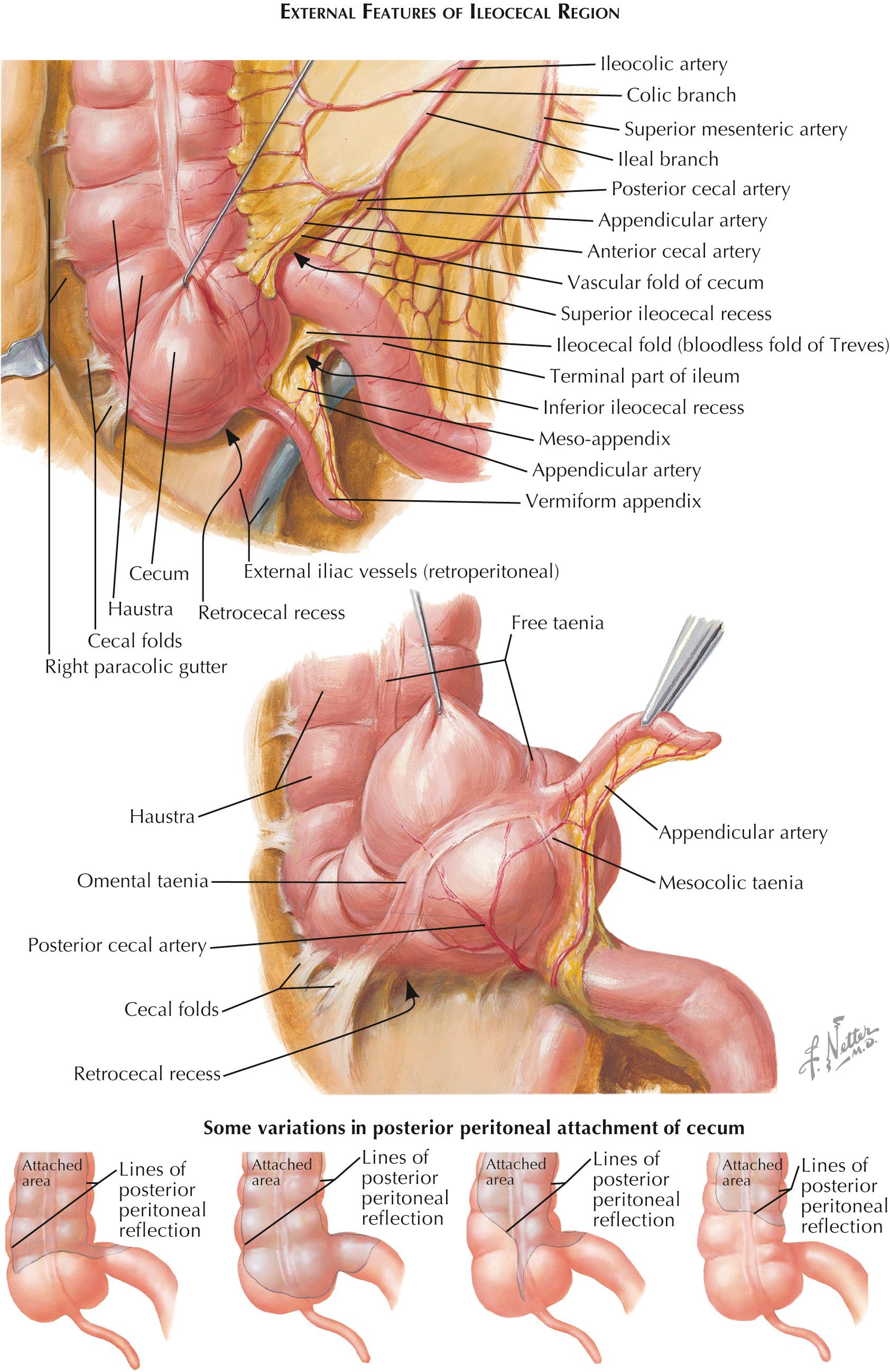
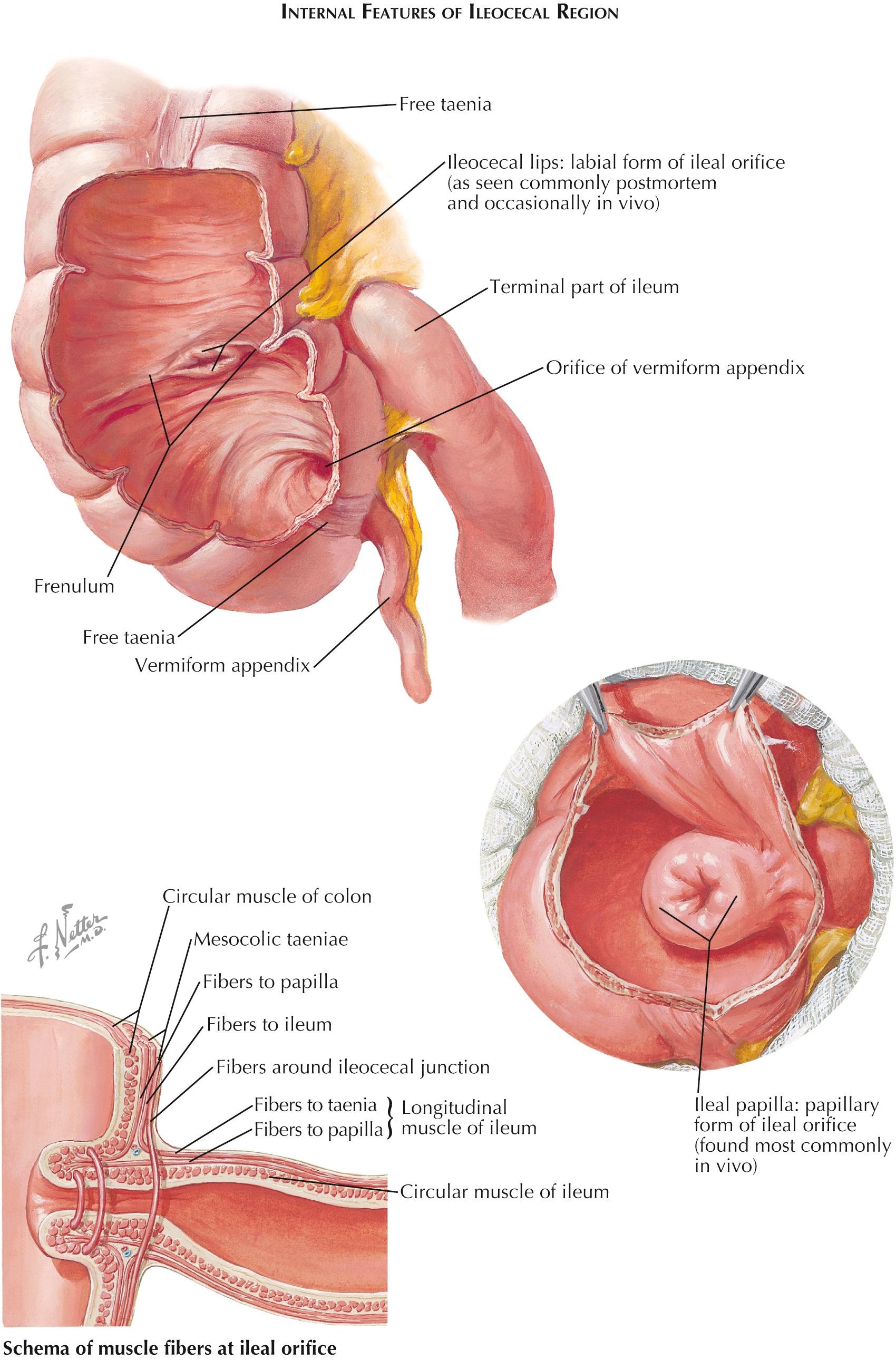
The most caudal portion of the small intestine, the terminal ileum, lies in the pelvis anterior to the right iliac fossa. Typically the ileal orifice opens into the medial wall of the colon from the left. This opening has previously been called the ileal valve, ileocolic valve, or ileocecal valve; this nomenclature is no longer preferred, however, because the opening's method of closure is not strictly valvelike. From the ileal orifice, the cecum, a blind sac, extends inferiorly within the lower right quadrant and the large intestine extends superiorly as the ascending colon. Although its exact location can vary considerably between individuals, the ileal orifice usually resides deep to the surface feature called the McBurney point. This point can be found in the right lower abdominal quadrant by drawing a line connecting the anterior superior iliac spine with the umbilicus (line of Monro) and looking for the line's intersection with the lateral edge of the rectus abdominis muscle.
The cecum, which is the widest portion of the large intestine, extends inferiorly from the ileal orifice in the right ileac fossa. Medially, the cecum is typically in contact with loops of the ileum. Laterally and posteriorly it is in contact with the iliacus muscle. Anteriorly it is typically covered by coils of the small intestine and/or greater omentum, but when full or distended by intestinal gasses, it may bulge and contact the anterior abdominal wall. In this case, it is possible to elicit a distinct tympanic note by percussing the overlying abdominal wall. An enlarged cecum can extend inferiorly over the psoas major muscle and even into the true pelvis. It typically does not extend so far as the posterior aspect of the inguinal ligament, leaving room for loops of small intestine in this region.
The ileum is connected to the posterior body wall by a mesentery containing its blood and lymphatic vessels and nerve supply. The mesentery of the ileum also contains the blood vessels that supply the cecum. In the area where the ileum joins the large intestine, a peritoneal fold extends in almost all individuals from the terminal part of the ileal mesentery across the front of the ileum to the cecum and the lowermost part of the ascending colon. This fold is properly called the vascular fold of the cecum but may also be known as the ileocolic fold or superior ileocecal fold. It contains the anterior cecal artery, and it forms the anterior wall of a fossa, correspondingly termed the superior ileocecal recess. The posterior wall of this fossa is made up of the terminal ileum and its mesentery. Its mouth opens inferiorly and somewhat to the left.
Another fold known as the ileocecal fold is commonly encountered anterior to the mesoappendix, extending from the lower or right side of the terminal ileum to the cecum. It is also referred to as the inferior ileocecal fold. The ileocecal fold contains no important vessels, and its corresponding eponymic designation is the bloodless fold of Treves.
The third peritoneal extension, the mesoappendix, serves as the mesentery of the vermiform appendix. It stretches from the posterior leaf of the mesentery of the terminal ileum and actually travels posterior to the cecum to the left side of the cecum and then along the entire length of the appendix. It thus typically assumes a triangular shape, and it transmits between its two layers the vessels of the appendix, particularly the appendicular artery or one of its numerous variations. The inferior ileocecal recess is formed by the ileocecal fold anteriorly and the mesoappendix as the posterior wall.
In some individuals, one or more thin peritoneal folds spread from the parietal peritoneum of the posterolateral abdominal wall to the lateral (right) side of the cecum (retrocecal folds) and/or ascending colon (retrocolic folds). These folds create small shallow recesses that in very rare instances are large enough to admit loops of the small intestine. Their apertures are normally too wide to permit an internal hernia to form.
The degree of mobility of the cecum depends upon the level at which the posterior part of its visceral peritoneum is reflected to the parietal peritoneum of the posterior abdominal wall. The level and contour of the reflection vary considerably. Occasionally, the peritoneal reflection may be so inferior that the cecum and terminal ileum are both firmly fused to the posterior abdominal wall. Conversely, the reflection may also occur so far superiorly that the entire cecum, distal ileum, and parts of the ascending colon may be surrounded by visceral peritoneum and connected to the body wall by the mesentery of the ileum. In the majority of cases, the reflection lies between these two extremes. The line of reflection may be straight, convex, or concave, or it may incline downward to the right or left or may be characterized by a narrow downward prolongation forming a sort of mesocecum.
As the terminal ileum enters the cecum, it is thrust through the wall of the cecum along with all of its layers except for the serosal layer. This creates an opening in the lumen that appears like a pair of lips, called the ileal orifice or ileocolic valve. When this opening is exposed in the cadaveric donor, it most frequently (60% of the time) appears to have transverse folds, the frenula of the ileal orifice, stretching away from either side of the ileal orifice. These folds resemble the crescent-shaped, semilunar folds of the colon, but they mark the place where contents of the ileum empty into the colon. The superior frenulum and inferior frenulum of the ileal orifice also mark the separation between the ascending colon above and the cecum below. For this reason, the superior frenulum is sometimes referred to as the ileocolic lip and the inferior frenulum as the ileocecal lip. Although the ileal orifice often has the two frenula, it can also protrude into the large intestine in the form of a round ileal papilla, the lumen of which looks like a star, or an asterisk (*), when closed. There is circular muscle within the papilla, and it may tonically contract to prevent retrograde motion of the colon contents but typically does not act as a true sphincter, selectively allowing contents from the ileum into the cecum. Some of the longitudinal smooth muscle fibers of the ileum are continuous with the mesocolic taeniae of the taeniae coli, and other longitudinal muscle fibers contribute to the ileal papilla. The muscle fibers of the ileum and large intestine meet at the papilla, with the circular muscle of the large intestine enveloping the circular muscle of the ileum. The two circular layers enclose the longitudinal fibers arising from the taeniae, except in the region close to the ostium, where the two circular layers meet.
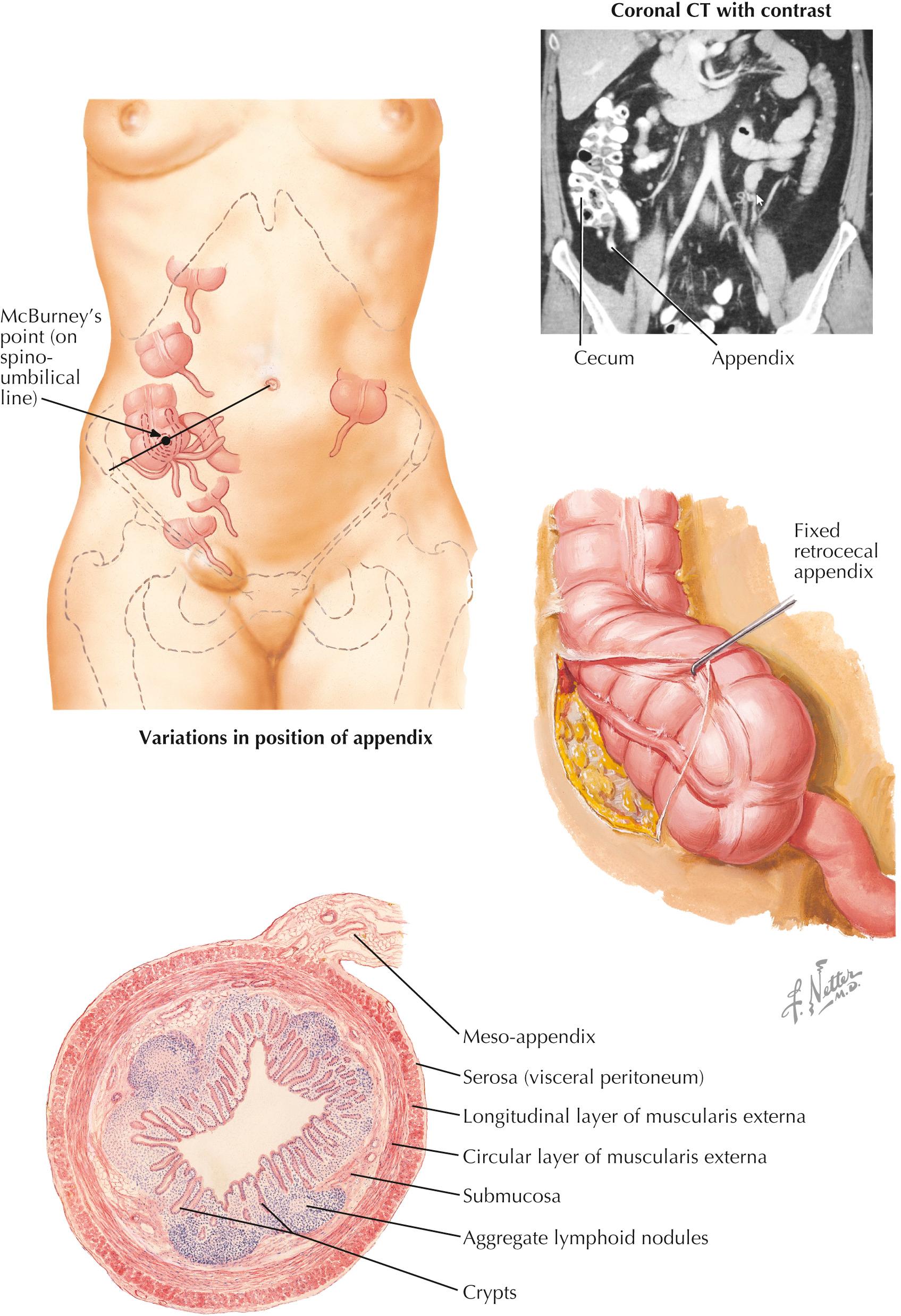
One structure of the proximal colon with considerable clinical significance is the vermiform appendix. Its surface projection lies at the lateral third of an imaginary line drawn from the anterior superior iliac spine to the umbilicus (McBurney point). In early fetal life the cecum extends caudally in the form of a cone, the tip of which grows more in length than in diameter, creating a vermiform (wormlike) process. Later, as a result of difference in the speed of growth of the cecal walls, the point where the appendix arises shifts from the distal end of the blind sac to a site on the posterior medial wall, where the three taeniae coli of the large intestine converge into one uniform coat of longitudinal muscle. In humans and apes, the appendix is a rather rudimentary, narrow, and thin (from 2.5 to 25 cm long; average, 6 to 9 cm) offshoot of the large intestine, which has no intestinal function (in contrast to the processus vermiformis of some birds and mammals, in which it may attain considerable length). However, it may serve as a reservoir for normal flora of the gut during diarrheal diseases or other dysfunction related to the colon. The course and position of the appendix differ considerably between individuals and can also change over time in an individual. Variations in position of the vermiform appendix are largely the result of differences of the length and width of the mesoappendix, the peritoneal fold that represents the mesentery of the appendix. The mesoappendix and nearby ileocecal fold form the bookends of a space, the inferior ileocecal recess.
The mesoappendix allows the vermiform appendix a wide range of mobility. Typically it is suspended from above by its mesentery and hangs for a varying distance into the true pelvis and may actually come into contact with pelvic organs (e.g., the uterus and its adnexa, or the bladder). Sometimes the appendix is mobile enough to be found within the sac of an indirect inguinal hernia or involved in a direct inguinal hernia. The vermiform appendix may also turn superiorly and extend either anterior or posterior to the cecum or ileum. The appendix can sometimes be found in a retrocecal position, posterior to the cecum. It may be “fixed” and relatively immobile. This fixation may have taken place as a result of inflammatory adhesions, or the appendix may have been trapped in the retrocecal position during fetal life at a time when the ascending colon fused to the posterior abdominal wall. Such a posteriorly fixed appendix may extend superiorly enough as to be more properly called “retrocolic” rather than retrocecal. In contrast to a fixed retrocecal appendix, in some instances the appendix may be capable of wandering into the retrocecal fossa and emerging thereafter.
The layers that make up the wall of the appendix are the same as those in other parts of the intestinal tract: mucosa, submucosa, muscularis externa, and serosa. The exterior of the appendix is enwrapped by the serous layer, or visceral peritoneum, except for a narrow line where the two layers of the mesoappendix attach to the appendix. Just deep to the serous layer, the longitudinal layer of the muscularis externa invests the entire circumference. The circular layer of the muscularis externa is well developed along the entire length of the appendix, though it may occasionally be deficient in one or two small regions, where the submucosal tissue becomes confluent with the serous coat. The appendix can be visualized in x-ray studies about 24 hours after the ingestion of barium. It usually fills uniformly, but the appearance of segments within the lumen is not to be interpreted as an expression of a pathologic process. The submucosa is endowed with lymphatic nodules as well as diffuse lymphatic tissue, the abundance of which is a characteristic of the appendix and explains one of its nicknames, “the intestinal tonsil.” The structure of the mucosa is essentially the same as in the large intestine, with intestinal glands but no villi or plicae circulares. Occasional Paneth cells can be found within the epithelium of the pits.
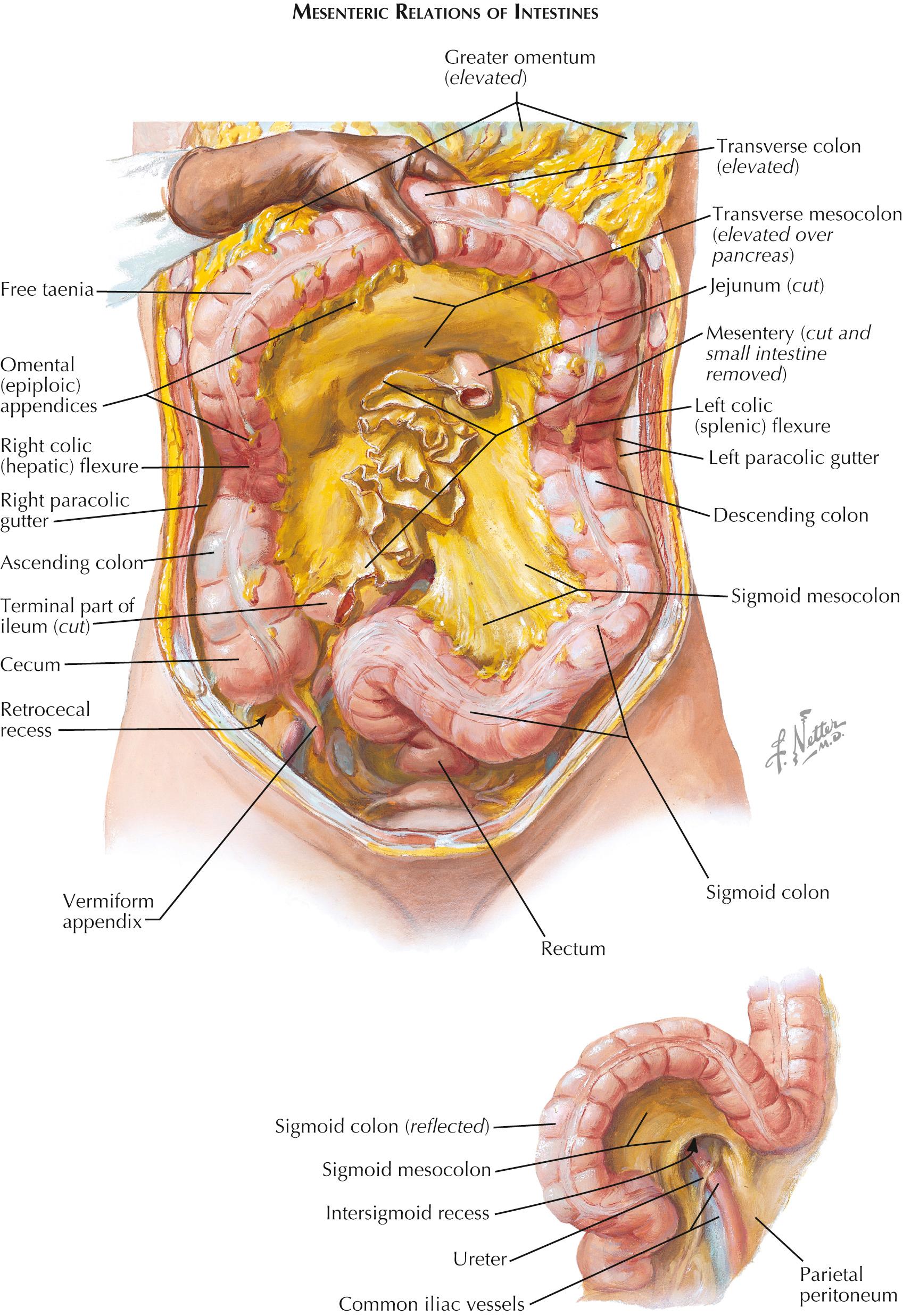
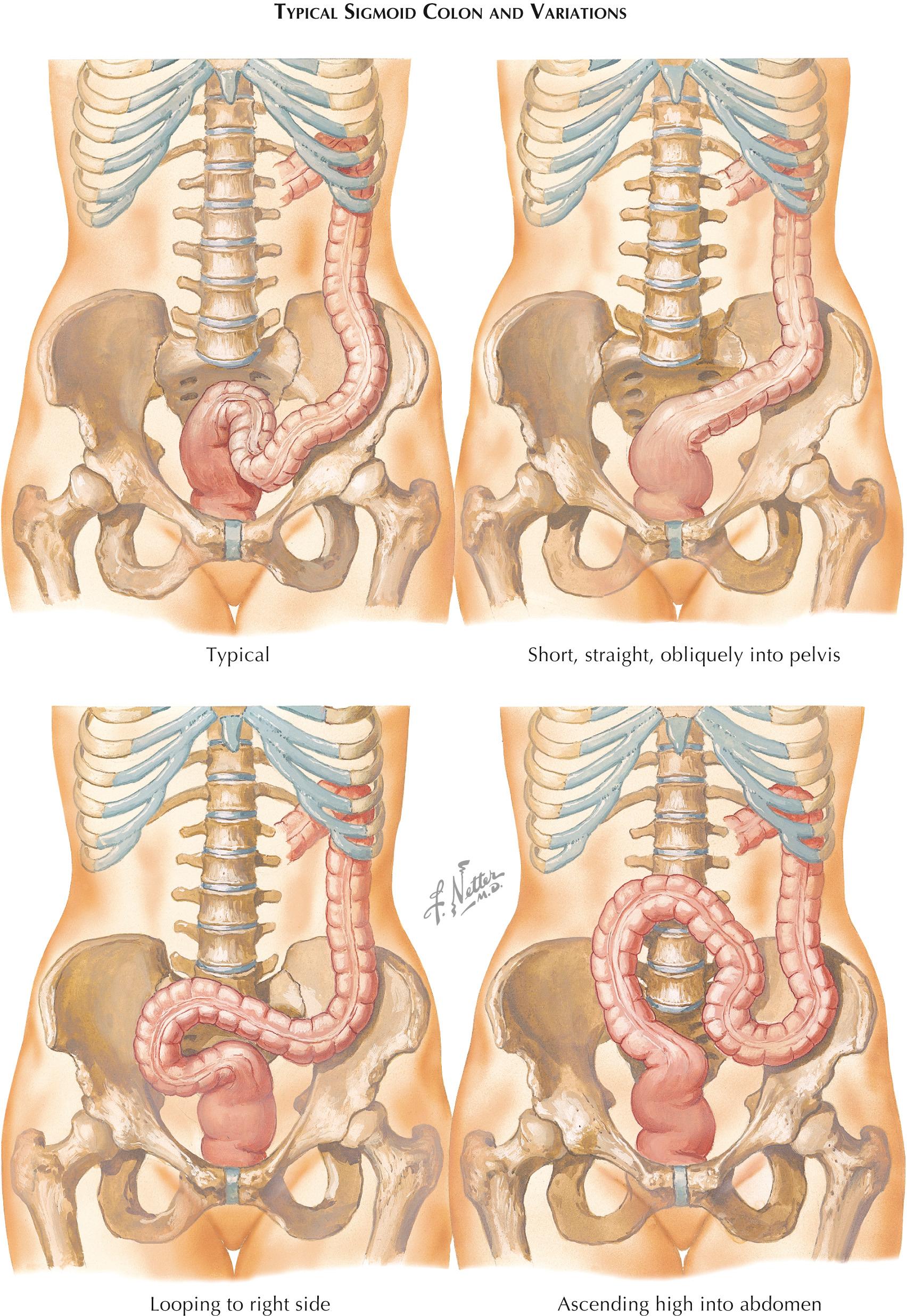
The lumen of the large intestine is generally greatest at the commencement of the large intestine (cecum) and narrows toward the rectum. However, the lumen of the large intestine varies considerably in caliber depending on its functional state. The haustra form sacculations separated by constricting furrows, so that the lumen bulges and contracts alternately during peristalsis. The total length of the large intestine is approximately 120 to 150 cm. From the cecum, the colon is subdivided into four segments, the ascending, transverse, descending, and sigmoid colon. The ascending colon and descending colon are retroperitoneal structures, fixed to the posterior body wall, and the transverse colon and sigmoid colon are intraperitoneal structures, attached to the posterior body wall by a mesentery. Viewed as a whole, the various parts of the large intestine describe an arch roughly in the shape of a horseshoe with the convex side directed superiorly. However, there is considerable variation in this appearance between individuals, largely due to differences in the length of the mesentery connecting the transverse colon and sigmoid colon to the posterior body wall.
The ascending colon averages about 15 to 20 cm in length and runs superiorly in a mostly straight course from the superior lip of the ileocolic valve to the right colic (or hepatic) flexure, where it passes into the transverse colon. Inferiorly, it starts in the right iliac fossa in contact with the iliacus muscles, and after crossing the iliac crest, it is positioned in the angle between the psoas major muscle and the quadratus lumborum and transversus abdominis muscles. The right colic flexure, responsible for the so-called colic impression on the undersurface of the right lobe of the liver, lies anterior to the right kidney, the two organs being linked together by loose connective tissue. The ascending colon is sometimes in contact with the anterior abdominal wall, depending upon how distended its lumen may be, as well as the degree to which it is overlapped by the loops of the small intestine. As the ascending colon turns leftward, becoming the transverse colon, it is related to the descending part of the duodenum and the medial surface of the right kidney.
The transverse colon, varying from 30 to 60 cm in length, continues from the right colic ( hepatic) flexure to the slightly more superiorly situated left colic (or splenic) flexure. It is an intraperitoneal structure, being attached to the posterior abdominal wall by a mesentery, specifically called the transverse mesocolon, which is very short in the region of the flexures and longest in the middle of the transverse colon. Because the transverse mesocolon is most pendulous in the middle, affording the colon a considerable range of movement in this area, a long transverse colon, especially when relaxed, may sag down some distance toward the pelvis. Viewed from left to right, the line of attachment of the transverse mesocolon crosses first the descending part of the duodenum, then the pancreas, and, finally, the left kidney. At the lateral edge of the kidney near the lower pole of the spleen is situated the left (or splenic) flexure of the colon. The posterior surface of the greater omentum adheres to the superior surface of the transverse mesocolon and to the serosal coating on the anterior side of the transverse colon. The middle section of the transverse colon would lie directly adjacent to the anterior abdominal wall if the greater omentum were not draped anterior to it. Depending upon the position and fullness of various organs, the transverse colon can be covered by the liver and gallbladder on the right and the stomach and spleen on the left.
The retroperitoneal descending colon, some 20 to 25 cm in length, extends inferiorly from the left colic flexure to the iliac crest or beyond it into the left iliac fossa. Depending upon the distention of its lumen, it will be in contact with loops of small intestine medially and anteriorly. After running first in the angle between the lateral edge of the kidney and the quadratus lumborum muscle and then over the iliacus muscle, it finally passes anterior to the psoas major. As it does so, it crosses the femoral and genitofemoral nerves, and continues to become the sigmoid colon.
The exact point of transition between the descending colon and sigmoid colon is indefinite. The sigmoid is the segment of large bowel between the descending colon and the rectum, which is somewhat mobile as a result of its attachment to a mesentery, the sigmoid mesocolon. Because this mesentery is subject to great variations, the exact length of the sigmoid colon itself becomes variable. It has been described as beginning anywhere between the left iliac crest and the brim of the true pelvis. As a rule, the sigmoid colon assumes an omega-shaped flexure arching over the pelvic inlet toward the right side of the pelvis at the level of the first or second sacral vertebra. It finally joins the rectum at an acute angle at approximately the level of the third sacral vertebra. However, this typical shape of the sigmoid is not constant. The sigmoid colon may be short, in which case it will run straight and obliquely into the pelvis, or it may be so long that the loop extends far to the right or, in an extreme case, high into the abdomen. The sigmoid colon's average length is about 40 cm in adults and 18 cm in children, but with the variations already mentioned, it may reach a length of 84 cm or more. The root of its sigmoid mesocolon is variable but characteristically starts in the upper left iliac fossa, proceeds inferiorly a few inches, medially, and again superiorly to a point on the psoas muscle a little to the left of the fourth lumbar vertebra, where it turns inferiorly into the pelvis. The line of mesenteric attachment takes the shape of an irregular and blunt inverted V. Turning inferiorly after having reached its highest point, the attachment line of the sigmoid mesocolon crosses anteriorly to the left common iliac artery and vein just above the division of the artery. The length of the sigmoid mesocolon (i.e., the distance from its root to the bowel wall) is extremely variable. A small peritoneal fossa, the intersigmoid recess, is formed by the sigmoid mesocolon while it twists around its vascular pedicle. The loop of sigmoid colon in this region covers the external iliac vessels, making it a good landmark for identifying the vascular stalk to the sigmoid colon as well as the external iliac artery and vein. Rarely, loops of small bowel can become strangulated in this area, causing an intersigmoid hernia. The left ureter passes retroperitoneally posterior to the intersigmoid recess.
The arrangement of the circular and longitudinal muscle layers is practically identical to that of the corresponding structures of other parts of the colon, except for the most distal parts of the sigmoid colon, where the three flat longitudinal muscle bands, the taeniae coli, fan out to form a completely encircling longitudinal muscle layer at the rectosigmoid junction. In the same region the circular layer thickens as it approaches the rectosigmoid junction.
Throughout the course of the sigmoid colon, the omental appendages of the serous coat diminish gradually in number and size. These fatty appendages hang from the colon and are generally clinically silent unless they become twisted around their vascular pedicle; in such a case, the ischemia may mimic that of appendicitis or diverticulitis.
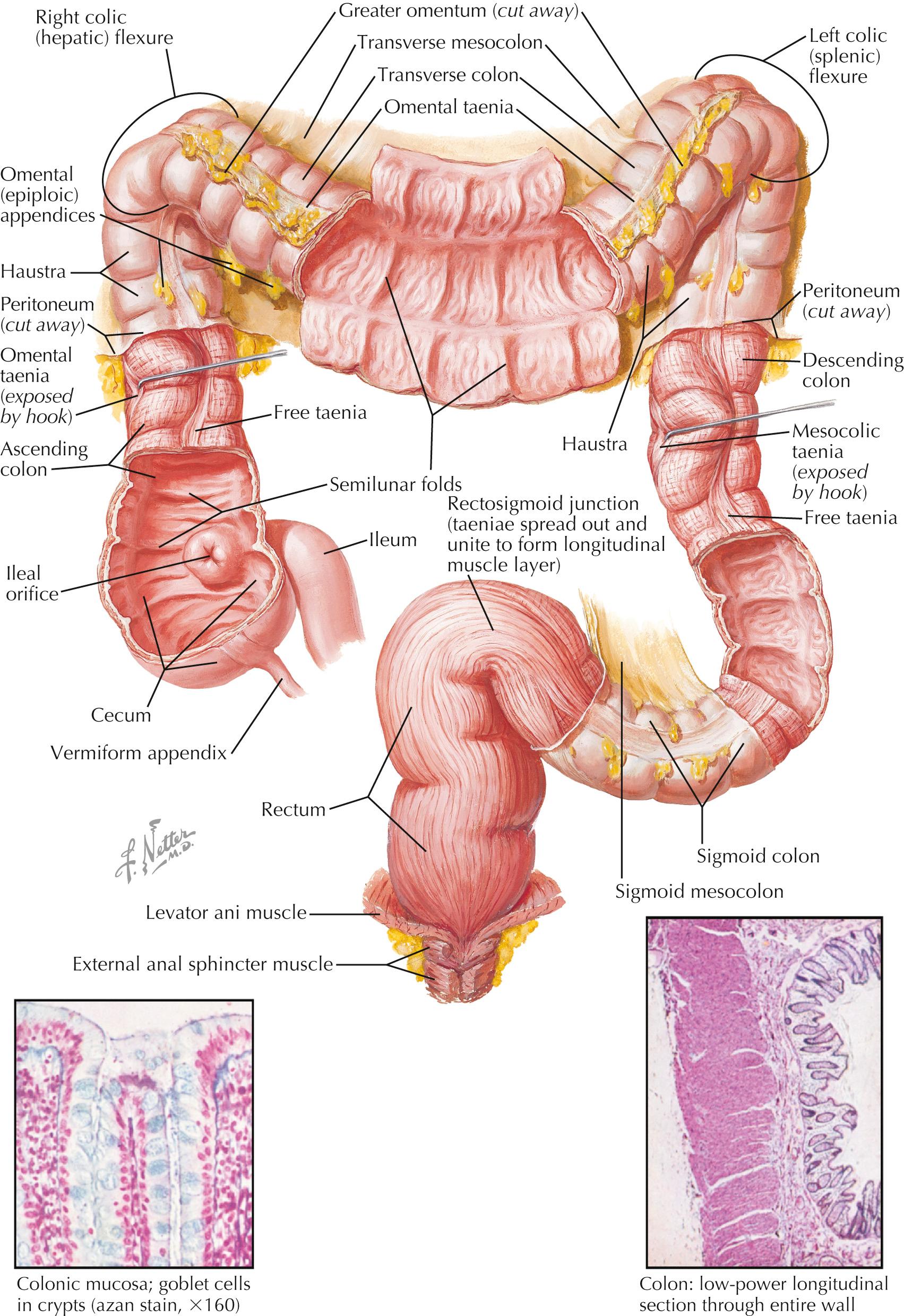
The histologic appearance of the colon is a modification of the normal structure of the entire intestinal tract. Specifically, the colon, cecum, and appendix consist of a mucosa, submucosa, double-layered muscularis externa, and either a serosal or an adventitial layer. Despite having similar layers, the colon differs significantly from the small intestine, being larger in diameter and containing a wider lumen. The colon also differs from the small intestine because of the three structures that are typical of it: (1) the three taeniae coli, (2) the haustra, and (3) the omental appendages.
The taeniae coli are three longitudinal bands, approximately 8 mm in width, running along the length of the colon. They are actually the external (outer) layer of the muscularis externa. This layer of smooth muscle typically runs longitudinally, but unlike elsewhere in the gastrointestinal tract, the taeniae do not form a uniform coat but condense into three distinct bands. The spaces between the taeniae coli consist of a thin longitudinal coating of smooth muscle. Each of the taeniae is named for its location on the transverse colon. The mesocolic taenia is located on the posterior aspect of the transverse colon between the two layers of the transverse mesocolon. It lies on the posteromedial surface of the ascending and descending colon. A second taenia, the omental taenia, is positioned along the attachment of the greater omentum as it lies across the anterosuperior surface of the transverse colon. It continues along the posterolateral aspect of the ascending and descending colon. The third taenia, called the free taenia, can frequently be noted without dissection on the inferior surface of the transverse colon and on the anterior aspect of both the ascending and descending colon. The three taeniae coli merge into a uniform longitudinal coat of smooth muscle where the appendix joins the cecum and as the sigmoid transitions to become the rectum. Generally, the posterolateral and anterior taeniae coalesce into a broad longitudinal band in the distal sigmoid colon. The external longitudinal muscular layer of the proximal rectum retains a slight trace of the taeniae because the layer is more strongly developed in its anterior and posterior parts than it is laterally.
A haustrum is a more or less prominent sacculation of the colon formed in the spaces between the taeniae coli. Individual haustra are separated from each other by constricting circular furrows of varying depth. The degree of their prominence depends on contraction of the taeniae; the more the taeniae contract, the more marked the haustra become. When the taeniae coli are relaxed, the haustra are almost completely absent. The omental appendages are subserous pockets filled with fat that are distributed in two rows along the length of the ascending and descending colon. In the transverse colon they form only one row along the line of the free taeniae. The size of each appendage varies according to the individual's state of nutrition or amount of overall body fat.
Within the lumen of the colon, the mucous membrane of the large intestine forms crescent-shaped transverse folds, known as semilunar folds or plicae semilunares, which correspond to furrows between haustra on the outer surface. Whereas the circular folds (plicae circulares, Kerckring folds) in the small intestine consist of only mucosa and submucosa, the semilunar folds include the circular layer of the muscularis externa.
One major difference in the microscopic appearance of the colon compared with the small intestine is that the mucosa of the large intestine has no villi. Like the small intestine it does have deep intestinal glands (crypts of Lieberkühn), which increase in depth toward the rectum and can extend as far as the muscularis mucosae. In the submucosa, in addition to the usual blood vessels, lymphatics, and submucosal plexus, there are numerous solitary lymphatic nodules in the lamina propria that penetrate through the muscularis mucosae into the submucosa. The epithelial lining of the large intestine has one layer built up of tall columnar cells that replicate from a stem cell population in the lower third of the gland and move progressively toward the surface. Mucus-producing goblet cells are very numerous in the epithelium of the colon, especially at the base of the pits.
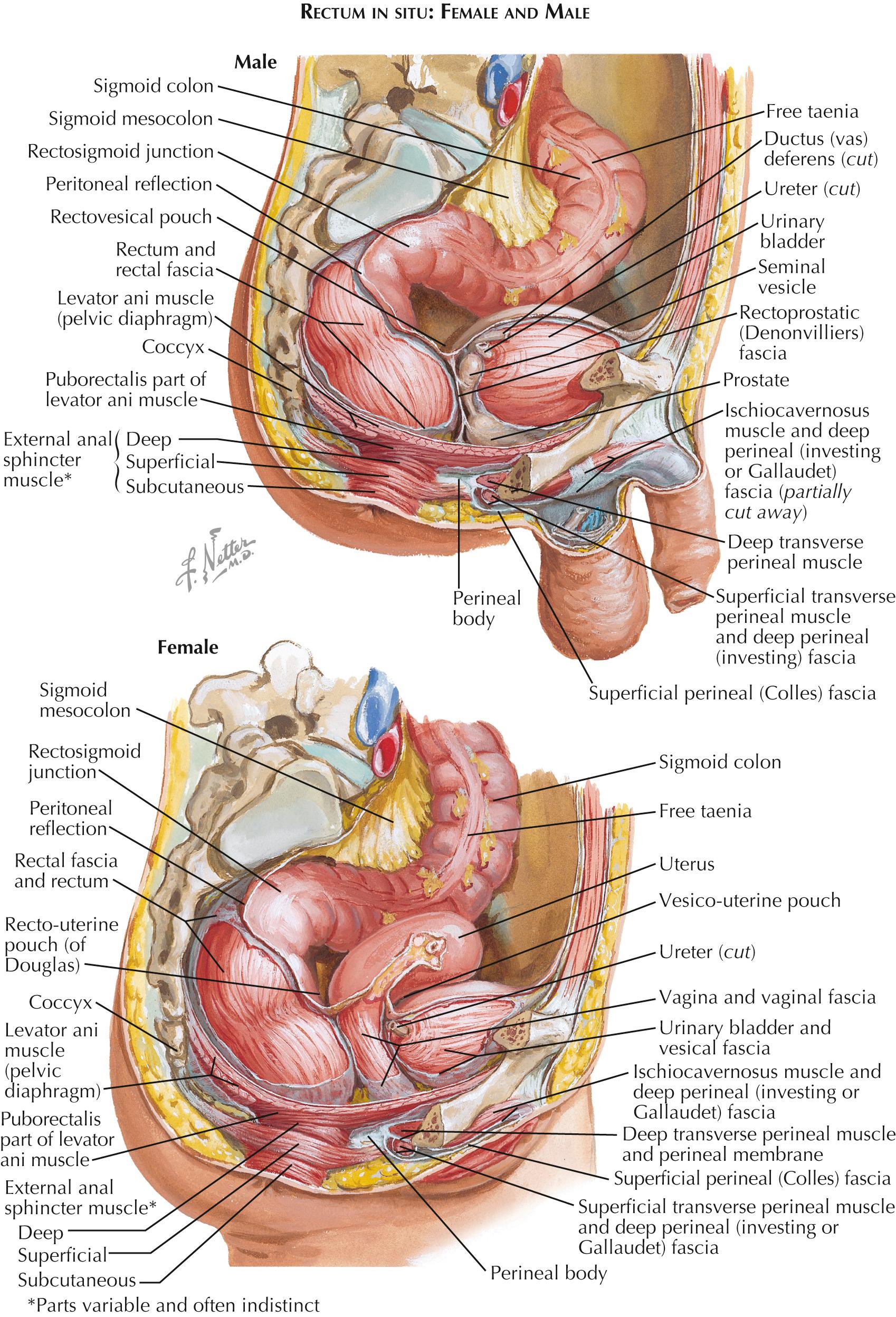
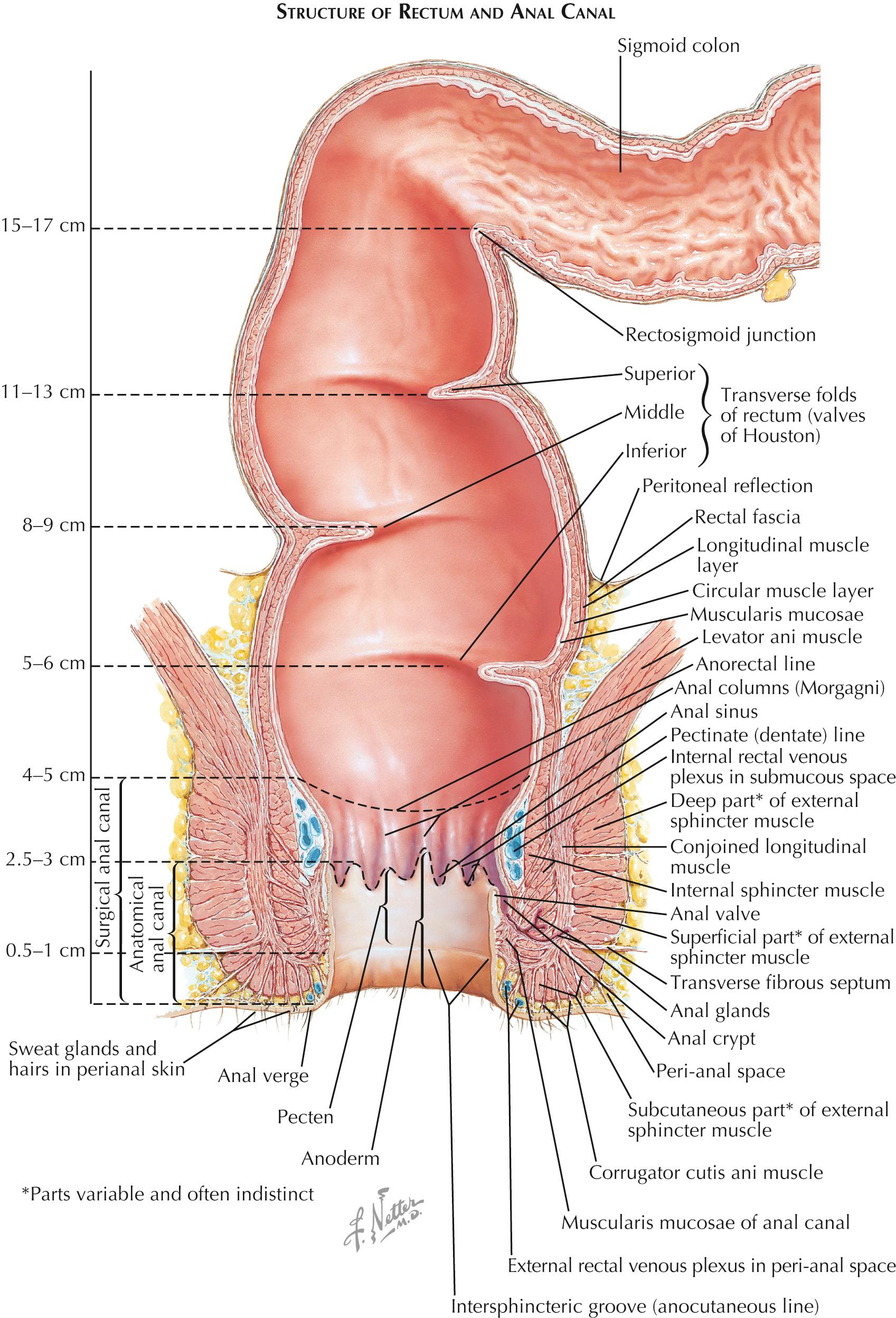
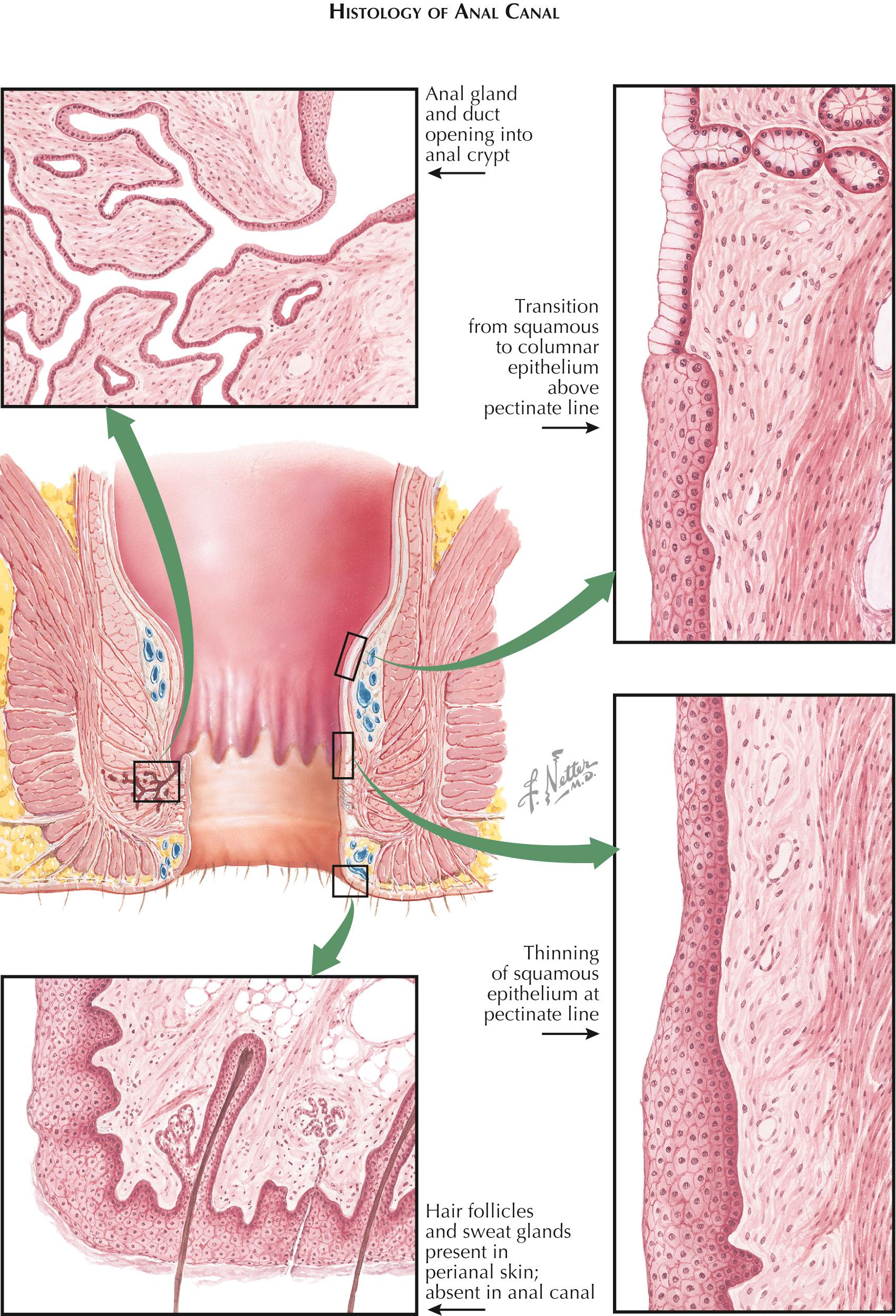
The terminal part of the gastrointestinal tract comprises the rectum and the anal canal, which are derived from quite different embryonic structures. The rectum extends from the rectosigmoid junction, at the level of the third sacral vertebra, 10 to 15 cm downward to the anorectal line. The peritoneal lining that creates the serous layer of the sigmoid colon continues inferiorly, but only over the anterior and lateral walls of the rectum. The posterior surface is typically adventitial, connected directly to the posterior body wall without a mesentery. Occasionally, a very small mesorectum may be present but only close to the rectosigmoid junction. The rectum is thus generally a truly retroperitoneal organ. The peritoneum that lines the anterior surface of the rectum is reflected into the region between the rectum and the bladder in the male, forming the rectovesical pouch, or rectum and uterus in the female, forming the rectouterine pouch. The depth of these pouches is variable, although the average distance from the anus to these peritoneal sacs is 7 cm in the male and 4 cm in the female, the rectouterine pouch being considerably deeper than the rectovesical pouch. As one follows the peritoneum on the anterior surface of the rectum laterally, it travels toward the sacrum, creating two longitudinal furrows, the pararectal fossae.
To understand its function, the rectum can conceptually be divided into an ampullary and a sphincteric portion. The ampullary portion appears as a transverse slit that can be almost completely collapsed or ballooned outward when filled with fecal matter. Its size and shape vary at different times in the same individual depending upon its fullness and intraabdominal pressure. With a circumference of approximately 15 cm at the rectosigmoid junction and 35 cm or more at its widest part, the rectum narrows as it passes through the musculature of the pelvic diaphragm. This occurs roughly at the level of the middle of the prostate in the male or the middle of the vagina in the female. The length of the rectum is subject, as is the diameter, to great variation between individuals, although on average, it is smaller in women than in men. The sacral curvature of the ampullary portion of the rectum conforms, unsurprisingly, to the anterior surface of the sacrum. The rectum's posterior wall continues to lie adjacent to the sacrum inferiorly to the level of the sacrococcygeal articulation, at which point it comes to lie more or less horizontally over the levator ani muscle. The anterior wall is comparatively straight and follows closely a line parallel to the posterior aspect of the vagina in the female or the urinary bladder in the male. In any event, the rectum is anything but straight (the Latin term rectus [straight] is derived from the early anatomists' experience in dissecting mammals that do not walk upright).
The ampullary portion of the rectum typically has three lateral flexures. Of these, the superior lateral flexure is convex to the right, the intermediate lateral flexure is convex to the left, and the inferior lateral flexure is convex to the right. All three bends correspond to the indentations on the internal rectal wall on the concave side, which are produced by crescent-shaped infolding of the mucosa and submucosa that also includes the circular musculature but not the longitudinal layer of the muscularis externa. These more or less marked folds, known as transverse folds of the rectum (rectal valves, valves of Houston), encircle about one third to one half of the rectal circumference. The superior and inferior transverse folds are located on the left side, the former approximately 4 cm below the rectosigmoid junction and the latter about 2 to 3 cm above the pectinate line at a site where the ampullary portion of the rectum begins to narrow. The intermediate transverse fold typically lies on the right side at or slightly above the level of the peritoneal reflection, about 6 to 7 cm above the pectinate line. It is worth noting that this distance is about the limit to which a probing finger may reach during rectal digital examination. In most instances the intermediate transverse fold is the largest of all three valves, but their size varies, as does their number. One or two additional folds or valves may be encountered, or only two may be present.
The sphincteric portion of the rectum, often considered to be the upper third of the surgical anal canal, begins at the palpable upper edge of the anorectal muscle ring, usually about 4 to 6 cm above the external opening of the anus, where the rectum narrows considerably. It extends down to the pectinate line (anatomic anorectal line, dentate line), an irregular, undulating demarcation in the rectal mucosa about 2 to 3 cm above the external anal opening. It has been assumed that this line marks the junction of the endodermal primitive gut with the ectodermal proctodeum; histologic evidence, however, has disclosed that this transition of the two fetal structures is not abrupt but spreads gradually over several centimeters. Nevertheless, the dentate line is visually recognizable, encircling the bowel, presenting from 6 to 12 superior extensions that are interrupted by an equal number of intervening inferior sinuses. The superior extensions of the dentate line are generally related to and overlie longitudinal elevations in the anal mucosa, known as anal columns, or columns of Morgagni. These stretch 2 to 3 cm superiorly and blend into the anal/rectal mucosa. They contain a richer lymphatic and vascular bed than does the intervening tissue. The uneven nature of the pectinate line is partially due to the fact that it stretches along the length of the anal columns. The valleylike depressions between the anal columns are the anal sinuses, or sinuses of Morgagni. At their lower extremities (the dentate line), the rectal columns are joined together by mucosal folds, the anal valves. These anal valves should not be confused with the transverse rectal folds, which are sometimes called rectal valves. Most, but not all, of the anal sinuses extend inferiorly to form pockets, designated as anal crypts (also known as anal pockets, crypts of Morgagni, and saccules of Horne), which may be 1 cm or more deep. The ducts of anal glands release mucus into the anal crypts, but the ducts and glands may extend for a variable distance into the adjacent tissues, even into the sphincter muscles; for this reason they are sometimes referred to as “intramuscular glands.” These glands and their ducts are sometimes foci for anorectal infections. Infection or inflammation can create perianal abscesses that extend to the skin surrounding the anus and rupture through the epidermis, creating a perianal fistula.
Occasionally, the anal columns form papillary projections into the rectal lumen, and the name anal papillae has been applied to these teatlike processes. In most instances these anal papillae are absent, but when they are present, they may hypertrophy and become prominent enough to appear as fibrous polyps that may even prolapse through the anal canal.
The section of the anus that forms the inferior two thirds of the surgical anal canal is termed the anatomic anal canal, which starts at the pectinate line and extends to the external opening of the anus. The superior portion of the anatomic anal canal is called the anal pecten or just pecten (Latin for “comb”) because of the comblike appearance of the pectinate line. The pecten is made up of the mucocutaneous epithelial lining, sometimes called the anoderm, and the structures found within the subepithelial connective tissue. This region is important because it marks the transition between the visceral blood supply and innervation superiorly (rectum) and the somatic blood supply and innervation inferiorly (anus). Anastomoses between the portal venous system and branches of the internal iliac veins occur in this area, creating an internal rectal (venous) plexus at the watershed areas between the two. Connections between the autonomic innervation of the rectum and the peripheral nerve supply of the anal canal, as well as the lymphatic drainage of both regions, also occur in the region of the pecten. The pecten is surrounded by all the muscles that constitute the anal muscular ring, extends inferiorly for a varying length of 1 to 1.5 cm to the pecten's inferior border, the intersphincteric groove (white line of Hilton , intermuscular groove). The intersphincteric groove is a palpable landmark created by the attachment of the conjoined longitudinal muscle (combination of the levator ani and muscularis externa) to the anoderm at the level between the blunt lower margin of the internal anal sphincter and the subcutaneous portion of the external anal sphincter. The clinical significance of the pecten is indicated by its being the zone of predilection for anal fissures, fibrosis (pectenosis), and inflammatory processes. Inferior to the pecten, a ring of cutaneous tissue that is 1 cm broad begins at the intersphincteric groove and terminates at the external opening of the anal canal. The anoderm in this region of the anatomic anal canal contains the perianal space, the subcutaneous part of the external anal sphincter, and another portal/systemic venous watershed area, the external rectal (venous) plexus.
The axis of the anal canal (anatomic as well as surgical) is, in adults, directed superiorly and anteriorly toward the umbilicus, in contrast to that of the rectum. In infants, both axes, that of the rectum and that of the anal canal, take the same direction because the child still lacks the adult rectal curves. This predisposes children to anal and rectal prolapse more frequently than adults.
Microscopically, the mucosa of the rectum is thicker than that of the nearby sigmoid colon. It also becomes increasingly redder and more richly vascularized as it approaches the surgical anal canal, until its lowermost portion assumes nearly a plum color. The extreme vascularity predisposes it to hemorrhagic disorders. The mobility of the rectal mucosa is also greater, and large folds, sometimes referred to as pseudopolyps, can form from it. The simple columnar epithelium of the rectum is similar to that of the colon, though the cells may appear more cuboidal toward the inferior end. Like the remainder of the colon, the rectum contains intestinal glands (crypts of Lieberkühn) that are particularly well developed and contain an abundance of goblet cells. The columnar epithelium of the rectum extends downward into the upper third of the surgical anal canal, where it changes into a stratified squamous epithelium at a point just above the pectinate line. This epithelium directly covers the internal rectal (venous) plexus as well as the anal columns and anal sinuses. An anal transitional zone exists between the simple columnar epithelium of the rectum and the stratified squamous epithelium of the external anal and perineal areas. In this transitional zone, the epithelium appears blended, and it is possible to see simple columnar, simple cuboidal, stratified cuboidal, and stratified squamous cells in the region. This epithelial transition zone may extend far above the dentate line up to the region of the anorectal muscle ring but generally does not extend more inferiorly than the anal valves. It is therefore incorrect to refer to the dentate line as being the “mucocutaneous junction.”
The stratified squamous epithelium of the anoderm covers the rectal columns and sinuses and thickens as it approaches the intersphincteric groove. The anoderm itself is devoid of mucous, sebaceous, and sweat glands and is firmly attached to the muscular and fibrous tissues of the pecten, and it is separate from the perianal space located inferiorly. Below the intermuscular groove, the anoderm further thickens and continues as perianal skin with its usual cutaneous hair follicles, sebaceous glands, and eccrine sweat glands. The perianal skin also contains large apocrine glands, called circumanal glands (circumanal glands of Gay), in which perianal hidradenoma may occasionally be diagnosed.
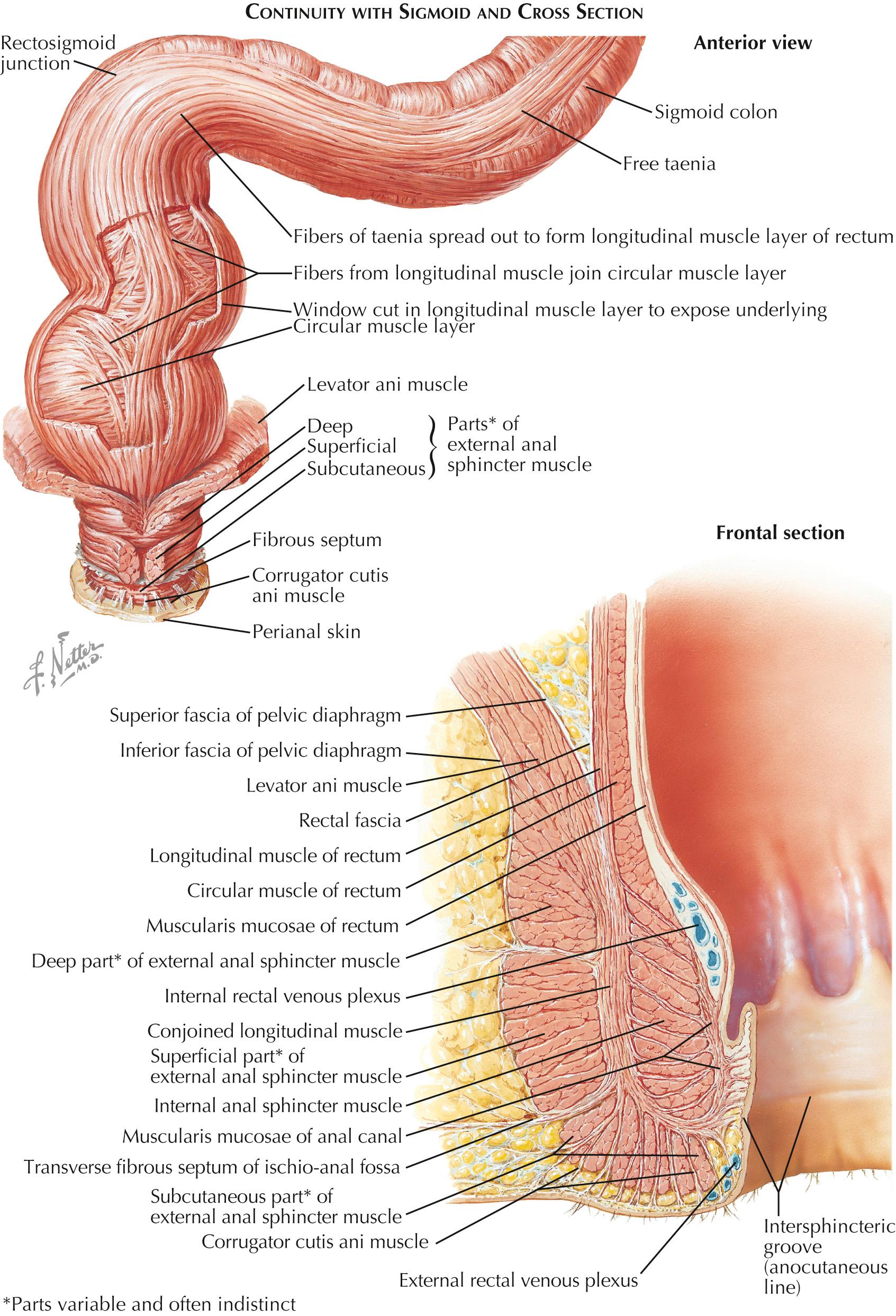
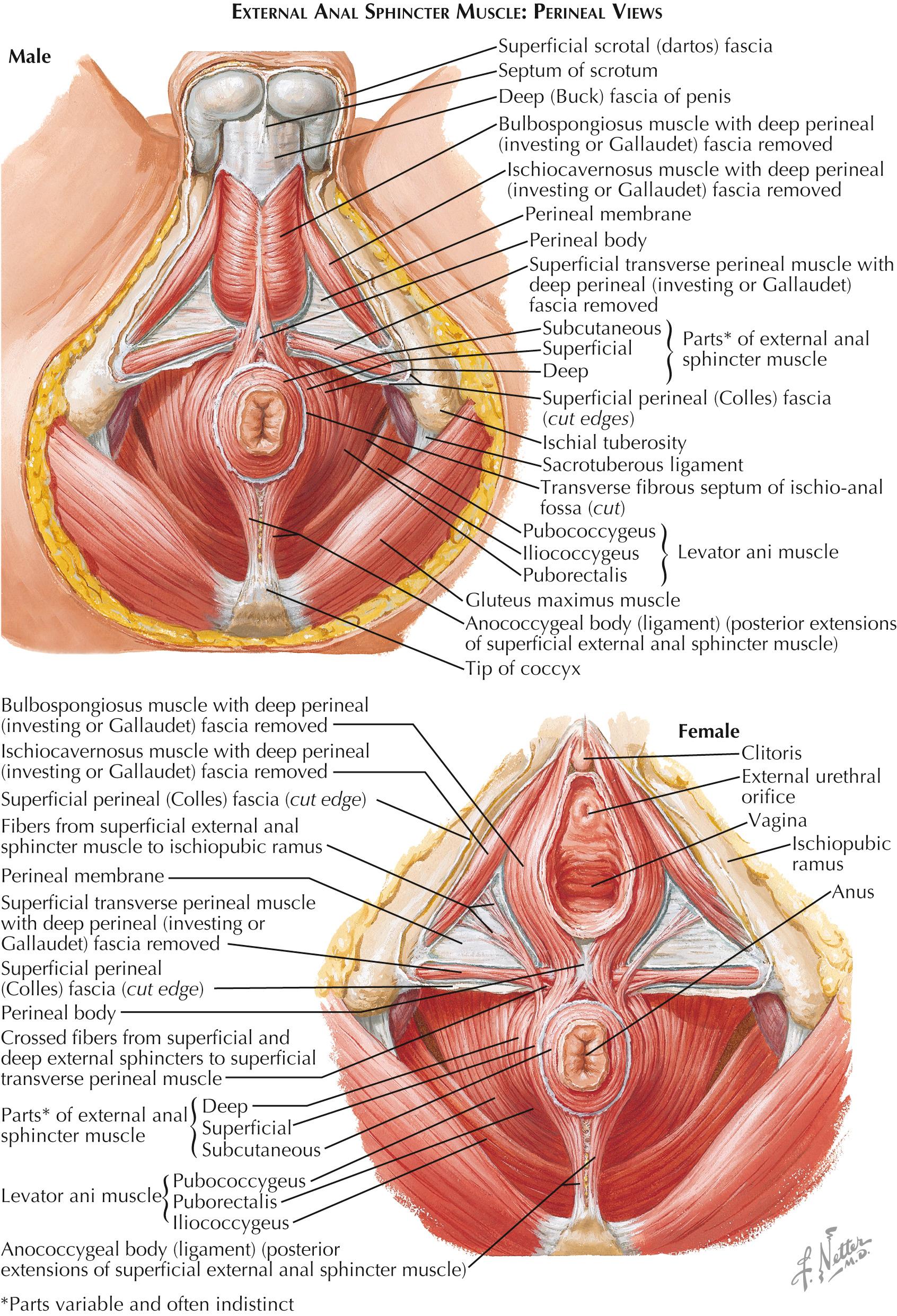
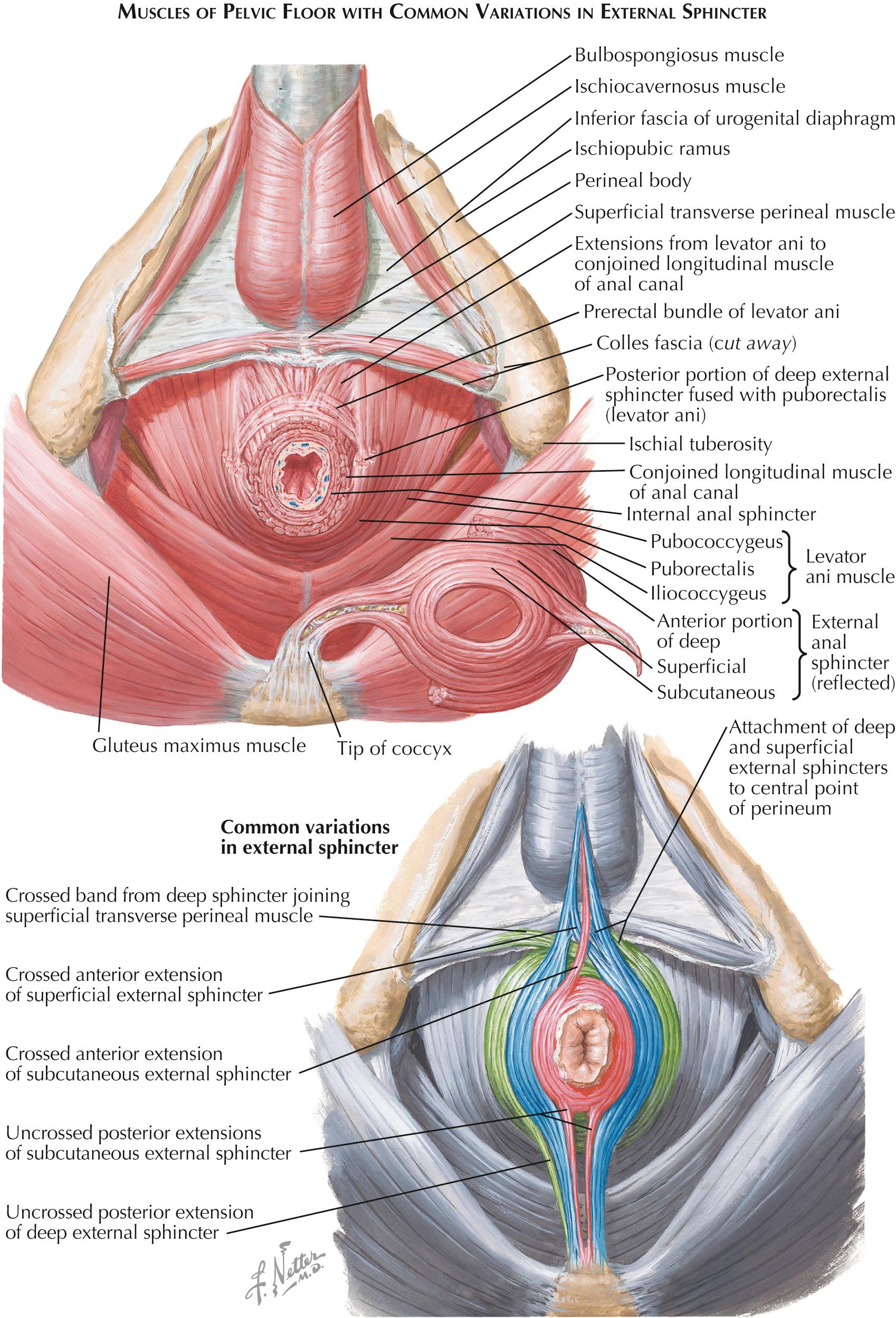
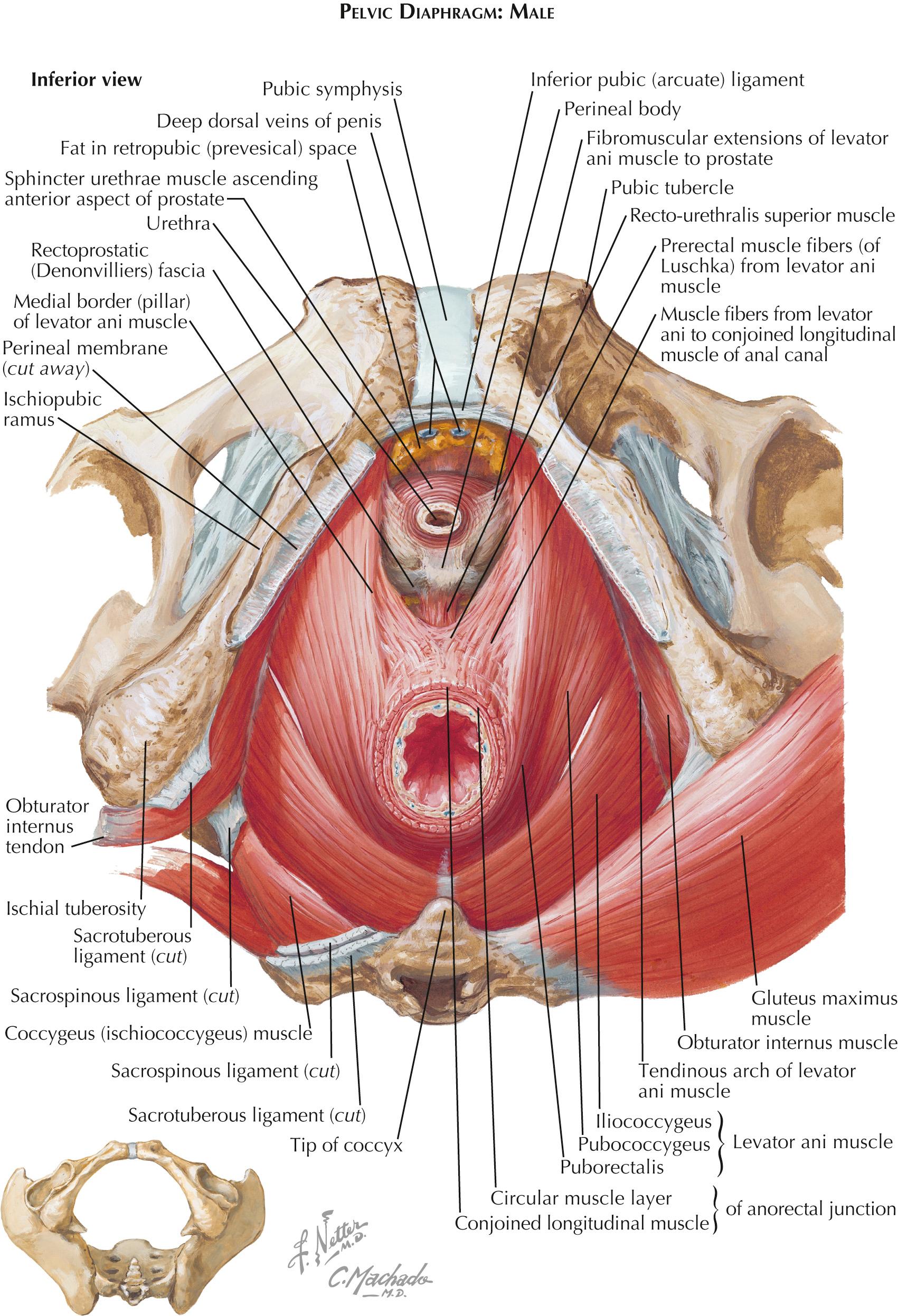
Like the rest of the gut tube, the rectum has an inner circular and an outer longitudinal muscularis externa, which is made of smooth muscle. However, this simple organization becomes much more complex and quite peculiar as it integrates with the skeletal muscle fibers that make up the anal sphincters and levator ani muscles. In the rectum the longitudinal layer of the muscularis externa is formed by an expansion of the taeniae coli as they spread out in the region of the rectosigmoid junction to coat the rectum more uniformly. Similarly, the inner circular layer of the muscularis externa of the rectum is a continuation of the circular muscle of the sigmoid colon. The ampullary section of the rectum is characterized by frequent connections of longitudinal and circular fibers. Fanlike muscular bundles of the longitudinal musculature insert into the circular layer, particularly at the site of those indentations that correspond to the transverse folds. At the lower extremity of the rectum, the longitudinal smooth muscle fibers fuse with striated fibers from the pubococcygeus and puborectalis portions of the levator ani muscle as well as by fibers from the supraanal fascia to become a conjoined longitudinal muscle in the upper part of the surgical anal canal. At the same level, the inner circular layer of smooth muscle becomes thicker to constitute the internal anal sphincter muscle.
Thus the internal anal sphincter muscle, representing a gradual enlargement of the inner circular muscle of the rectum, is composed of smooth muscle fibers that are innervated by autonomic nerves via the intrinsic myenteric and submucosal plexuses. At the level of the intersphincteric groove (0.5 to 1 cm above the external opening of the anus), the internal anal sphincter, having a thickness of 0.6 to 0.8 cm and a length of 3 to 5 cm, ends with a sharply defined and readily palpable rounded lower margin, resulting from its strong fascial encasement and the recurrent arrangement of its more caudal muscle bundles.
The combined longitudinal muscle (from rectal longitudinal smooth muscle and skeletal muscle fibers of the levator ani) extends inferiorly, surrounding the internal anal sphincter, before itself becoming surrounded by the external anal sphincter. While continuing on its inferior course, the muscle gives off bundles of fibroelastic tissue interwoven with muscular fibrils, which penetrate the internal sphincter. These fascicles decrease successively in their obliquity as they pass through the internal sphincter, until the deepest fascicles actually ascend. Some of these penetrating fascicles fuse with the well-developed muscularis mucosae of the anal canal and were formerly designated as “sustentator mucosae of Kohlrausch” but are more properly referred to as muscularis submucosae ani. These fibers anchor the anoderm of the pecten to the underlying tissue and to the lower third of the internal anal sphincter. This fixation to the underlying fibromuscular structures supports the nearby internal rectal (venous) plexus during defecation. It also helps the pecten resist eversion of the anal canal and prolapse of the rectum. When prolapse or procidentia does occur, it is also this fixation that is responsible for the formation of the intermuscular depression or groove. In its most inferior part, the conjoined longitudinal muscle gives off a fanlike series of fibromuscular septa, which pass through the circular fibers of the subcutaneous portion of the external sphincter ani to attach themselves to the perianal skin. Here, the muscular elements of these septa form (together with some extended fibers of the muscularis submucosae ani) the corrugator cutis ani.
Extensions from the conjoined longitudinal muscle pass outward through the external anal sphincter. The most important of these extensions are those that separate the subcutaneous and superficial portions of the sphincter and continue as the transverse septum of the ischioanal fossae. Anteriorly, extensions are also reflected to the urethra above the external sphincter, forming part of the rectovesicalis muscle and, posteriorly, to the coccyx as the anococcygeal ligament.
The significance of the conjoined longitudinal muscle for the physiologic study, pathologic study, and surgical procedures of the anal and rectal areas cannot be overemphasized. Together with the levator ani muscle, it exercises its levator and sphincteric actions on the entire length of the anal canal. By its extensions at the level of the intersphincteric groove and by its fascial frame in the upper third of the surgical anal canal, the muscle influences the spread of anorectal infections as well as the sites of the openings and main tracts of fistulas. From the surgeon's point of view, the terminal conjoined longitudinal muscle fibers are important because they permit the recognition of the lower border of the internal sphincter, which is a landmark during internal hemorrhoidectomy or hemorrhoidopexy.
The outermost and also most inferior muscular elements of the anal canal belong to the external anal sphincter, which is a trilaminar skeletal muscle. Its three parts, the subcutaneous, superficial, and deep parts, are more easily recognized surgically than in the cadaver. The subcutaneous portion, about 3 to 5 mm in diameter, surrounds the anal orifice directly above the anal margin and is readily palpable and often discernible as a distinct annular ridge. Separated from the internal anal sphincter by fibers of the conjoined longitudinal muscle at the level of the intersphincteric groove, the subcutaneous portion is situated inferior to and slightly lateral to the internal sphincter. Seen from below, the subcutaneous portion usually has an annular form, though its fibers may cross and branch in all directions and may extend posteriorly. In the male, anterior muscular extensions to the median raphe are not uncommon, and uncrossed posterior extensions of the subcutaneous external sphincter connecting with the coccyx may also be found. In the female, the subcutaneous portion is much more strongly developed, particularly anteriorly, where it forms a prominent annular band, frequently incised at episiotomy. The subcutaneous muscle is functionally integrated with the levator ani muscle through extensions of the conjoined longitudinal muscle which pass fanlike through it, to terminate as fibers of the corrugator cutis ani.
Just deep to the subcutaneous part of the external anal sphincter is the elliptically shaped superficial portion, which is the largest and strongest of the three parts. It is situated somewhat lateral to the subcutaneous portion and arises independently from the tip of the coccyx; this fact explains why it is sometimes referred to as the coccygeal portion. The fibers enclose, in a crescentlike fashion, the lower third or half of the internal sphincter and insert, in the male, at or around the central point of the perineum and the median fascial raphe of the bulbospongiosus muscle. In the female, however, only a few fibers of the superficial portion insert at the central point of the perineum; the majority of them merge with the bulbospongiosus muscle, and some may extend laterally as far as the ischiopubic rami and the ischial tuberosities in conjunction with, or independent of, the thin superficial transverse perineal muscles. It is not uncommon that fibers, which pass around the anal canal on the left side, cross over to insert anteriorly or laterally on the right side, and vice versa, as they move anteriorly. Posteriorly, the superficial muscle forms the right and left muscular components of the anococcygeal ligament. Deep or superior to this ligament, the right and left ischioanal fossae are continuous through the deep postanal spaces, whereas the right and left perianal spaces communicate with each other through the superficial postanal space superficial or inferior to the anococcygeal ligament.
The deep part of the external anal sphincter is, for the most part, an annular muscle bundle that blends with the puborectalis muscle as it passes around the posterior end of the terminal rectum and does not usually attach to the coccyx. The deep part of the external sphincter surrounds the upper third of the surgical anal canal and, with the prerectal muscle bundles of the levator ani, some fibers may attach themselves to the perineal body or, after crossing sides, may join the superficial transverse perineal muscle and extend as far as the ischium.
The muscles that form the pelvic diaphragm, in particular the levator ani muscle, keep the rectoanal canal in position. The levator ani is frequently subdivided into three individual components that form a nearly continuous sheet of skeletal muscle, namely, the puborectalis, pubococcygeus, and iliococcygeus muscles. Another way to view the levator ani is to conceptualize its component muscles as enclosing the pelvic outlets in two planes, a diaphragmatic and a subdiaphragmatic plane. The former is created by a broad, sweeping, muscular sheet of the pubococcygeus and iliococcygeus muscles, with the puborectalis muscles contributing a very small ventral muscle bundle. The subdiaphragmatic plane is formed by the inferior extensions of the pubococcygeus and puborectalis muscles into the nearby musculature of the visceral outlets, particularly of the anal canal. The subdiaphragmatic plane assumes a more vertical axis as its fibers funnel around the anorectal canal and urogenital outlets, whereas the diaphragmatic plane is oriented more horizontally.
The puborectalis muscle contributes only a small part to the diaphragmatic plane and lies almost entirely in the subdiaphragmatic plane. It is the most medial portion of the levator ani, taking its origin at the pubic bone just medial to the origin of the pubococcygeus muscle. Not readily recognizable as a distinct muscular structure in its region of origin, its fibers pass posteriorly and horizontally on either side of the pelvic aperture and gradually come to lie inferior and medial to the anal extensions of the nearby pubococcygeus muscle. In its course, the originally horizontal surface of the muscle becomes its inner surface, and its originally medial edge its inferior margin. It then forms a sling around the posterior aspect of the rectum just superficial to the rectum's conjoined longitudinal muscle fibers. In conjunction with the deep part of the external anal sphincter, to which it is attached, this slinglike muscle band forms the posterior half of the proctologically important anorectal muscle ring. Although the fibers of the puborectalis muscle do not extend to the coccyx, the midline raphe sends fibrous bands posteriorly to the coccyx, fixing it posteriorly. Anterior to the rectum, the muscle also gives off fibromuscular extensions to the prostate or vagina and to the conjoined longitudinal muscle of the rectum. It is better developed and more readily visible in the female.
Just lateral to the puborectalis muscle origin is the origin of the pubococcygeus muscle, which arises from the posterior aspect of the pubic bone and superior pubic ramus and extends from a site near the pubic symphysis to a site just medial to the obturator foramen. It continues posteriorly, attaching to the anterior extremity of the arcus tendineus, formed from the thickened fascia of the obturator internus muscle. From this origin the muscle fibers stretch medially and posteriorly along the inner boundaries of the pelvic aperture, looping around the rectum, just superior to the puborectalis muscle. The fibers of both sides join in the midline, contributing to the muscular raphe that inserts into the anterior aspect of the coccyx, continuous with a contribution from the puborectalis muscle. Aponeurotic extensions from this raphe continue along the sacrum as anterior sacrococcygeal ligaments. The part of the pubococcygeus muscle that lies in the subdiaphragmatic plane consists of fibromuscular extensions to the prostate gland, urethra, and vagina, and also the rectum and anal canal. These extensions fuse with the longitudinal muscles and fascial collars of the visceral outlets or bridge the interval between them. Some fibers from each side do interdigitate with those of the opposite side, and some cross from side to side as the prerectal bundle .
The iliococcygeus muscle arises almost entirely from the thickened medial fascia of the obturator internus muscle along a convex line, the arcus tendineus of the levator ani, which begins posterior to the obturator foramen and extends posteriorly to attach just superior to the ischial spine. The muscle's fibers, directed medially, inferiorly, and slightly posteriorly, converge and contribute to the levator ani slightly inferior to the pubococcygeus muscle.
The muscular constituents of the levator ani muscle, when conceptualized together in the subdiaphragmatic and diaphragmatic planes, are shaped (from a superior view) like a funnel. The rims of the funnel attach to the pubic bone, arcus tendineus, and ischium, and the lowest point is marked by the hiatus for the anal canal. The levator ani thus fixes the pelvic floor and acts as a fulcrum against which increased abdominal pressure, as occurs in lifting, coughing, or defecation, may be resisted. Its pubococcygeal portion and the sling muscle of the puborectalis muscle have additional functions, insofar as they become integral parts of the anorectal muscle ring surrounding the inferior part of the rectal ampulla and the upper end of the surgical anal canal. The posterior half of this ring consists mainly of the puborectalis sling fibers, which also serve as a prominent, readily definable, proctologic landmark. The less prominent anterior half of the ring is composed of the internal anal sphincter, the thin muscular extensions from the pubococcygeus known as the prerectal bundle (Luschka fibers), and the conjoined longitudinal muscle surrounded by the deep portion of the external sphincter. In view of such integration between the skeletal (voluntary) musculature of the pelvic floor and the smooth (involuntary) or partly mixed muscles intrinsic to the terminal structures of the intestines, the role of the levator ani as supplement and synergist for the contraction and relaxation of the anorectal sphincter mechanism is evident. The posterior half of the anorectal muscle ring, in conjunction with the puborectalis muscle sling, contracts to pull the rectum toward the os pubis (increasing the angulation in the anorectal tube), shortens and narrows the pelvic aperture, and elevates the anus and thus collaborates in closing the anal canal.
Posterior to the levator ani muscle, the remaining pelvic floor is formed by the coccygeus muscle. Together, the levator ani muscle and the coccygeus muscle are called the pelvic diaphragm. The levator ani and coccygeus muscles are innervated by special nerves derived from the ventral rami of the fourth (sometimes also third) sacral spinal nerve. These nerves course on the superior surface of the muscles until they penetrate them. The three laminae of the external sphincter muscle are supplied by the inferior rectal and perineal nerves branching from the pudendal nerve.
Clinical experience, especially in surgery of anterior anal fistulas, has shown that the greater portion of the anal musculature may be severed without materially interfering with anal continence, but some degree of incontinence is apt to follow, as a result of a relatively greater retraction of the musculature, when the anorectal ring is divided through its entire thickness, particularly in its anterior and lateral aspects. A change in the anatomic relations of the anorectal musculature occurs under anesthesia, especially spinal anesthesia, a fact that is significant in anorectal surgery. All the somatic components of the musculature relax, but the visceral components tend to retain or even increase their tone. As a result, the anal canal becomes foreshortened and the internal sphincter is displaced to a relatively lower level, becoming the principal presenting muscle surrounding the anal orifice. The subcutaneous portion of the sphincter flattens out and recedes laterally, so that the intermuscular depression may disappear and become less readily palpable.
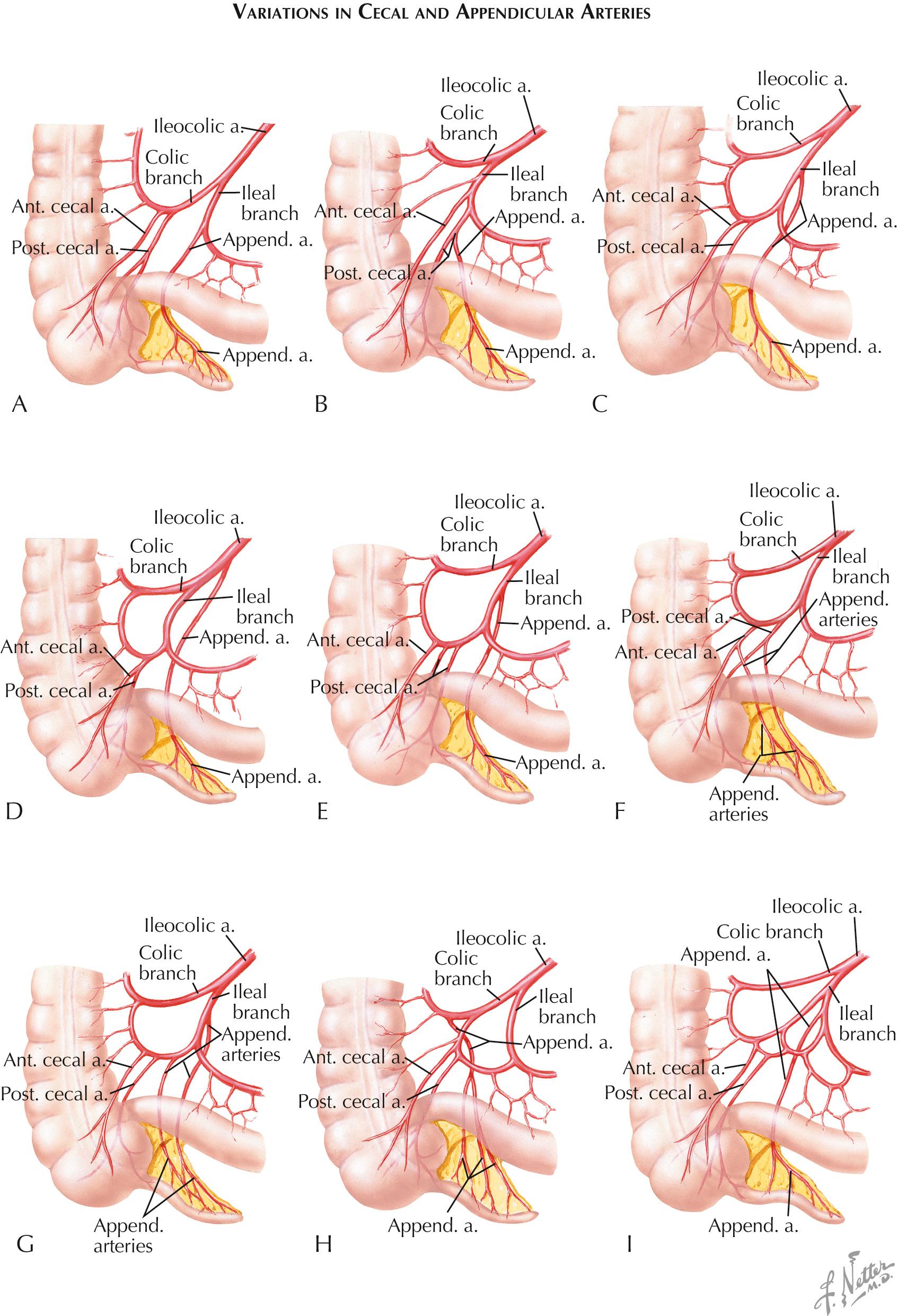
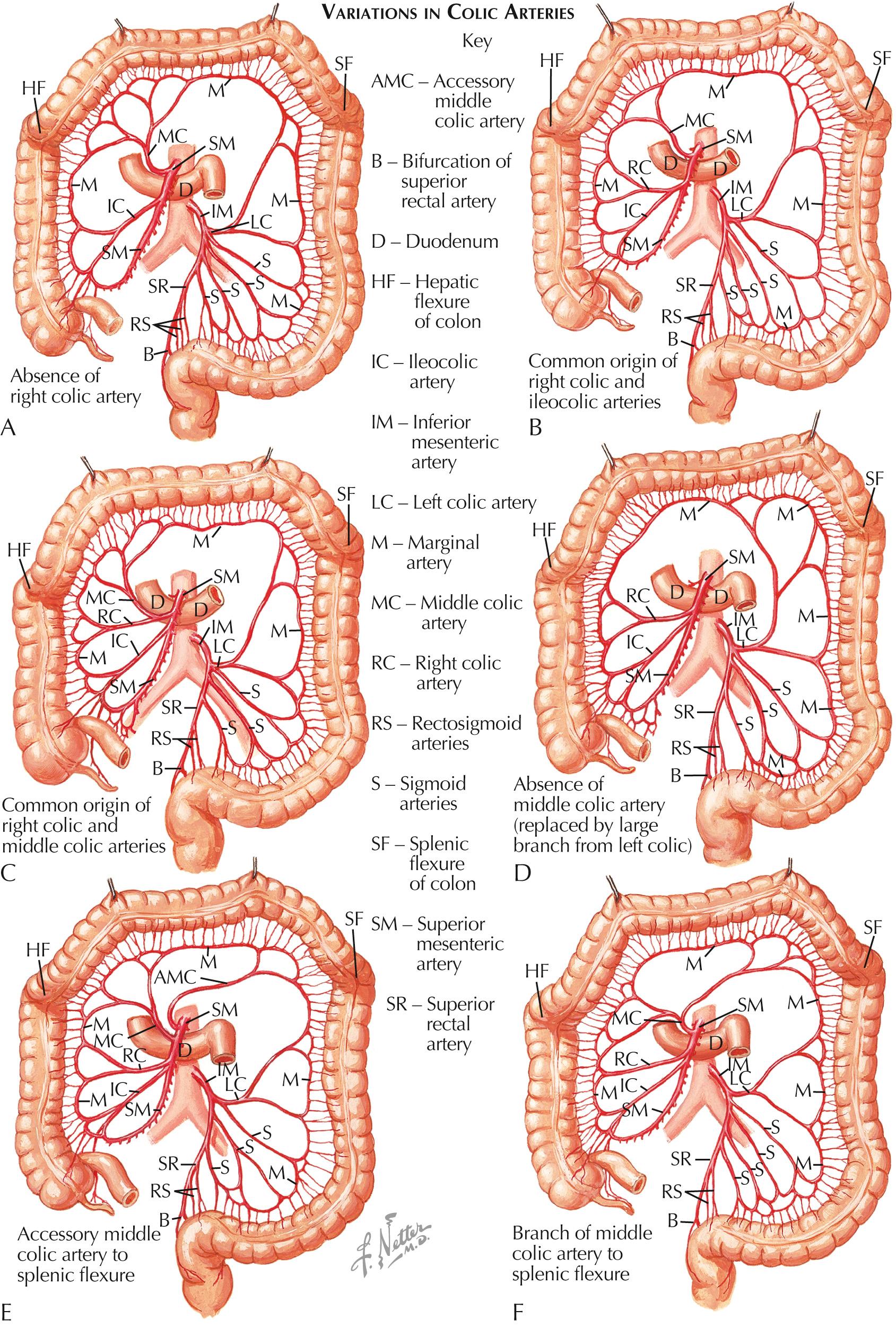
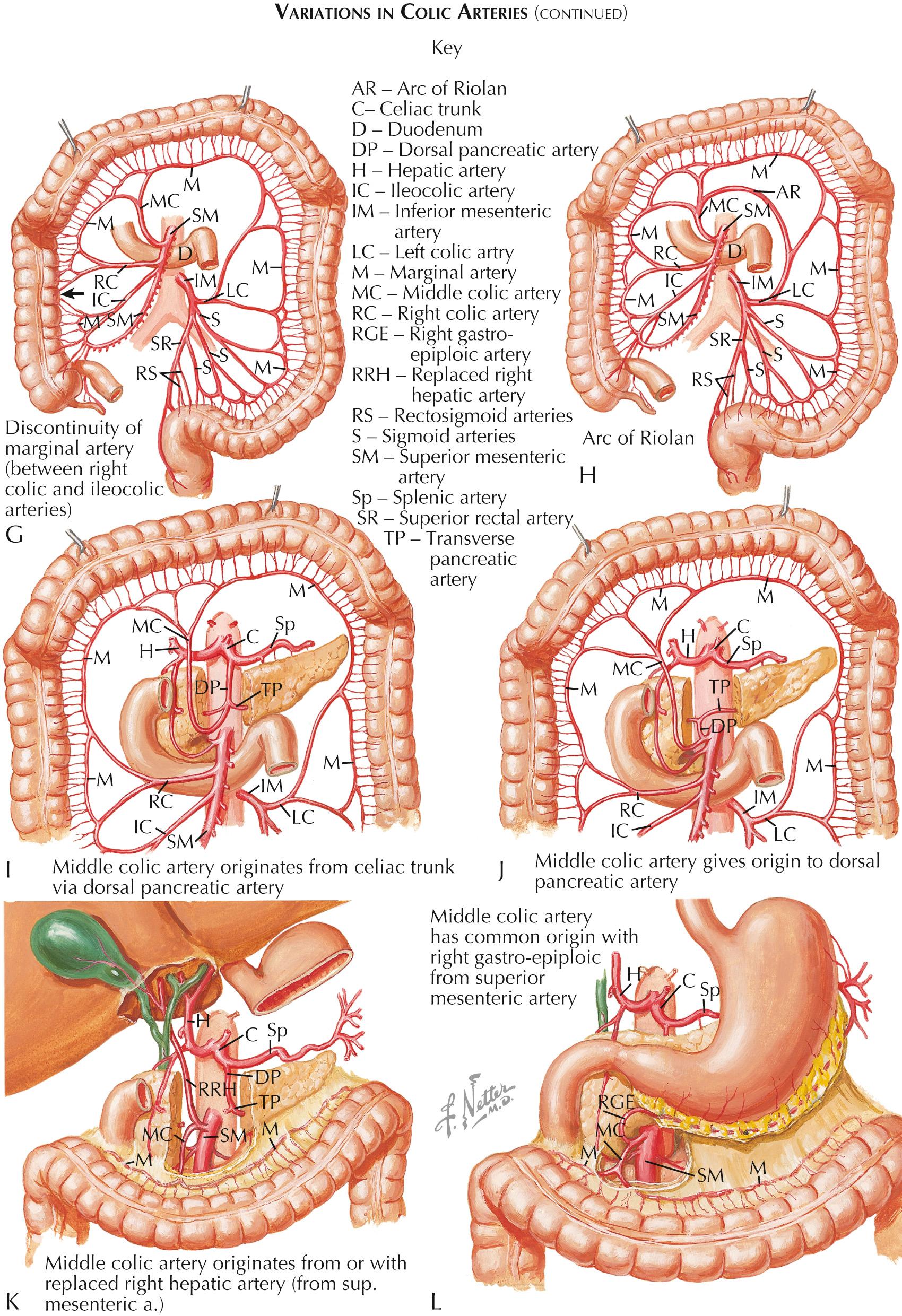
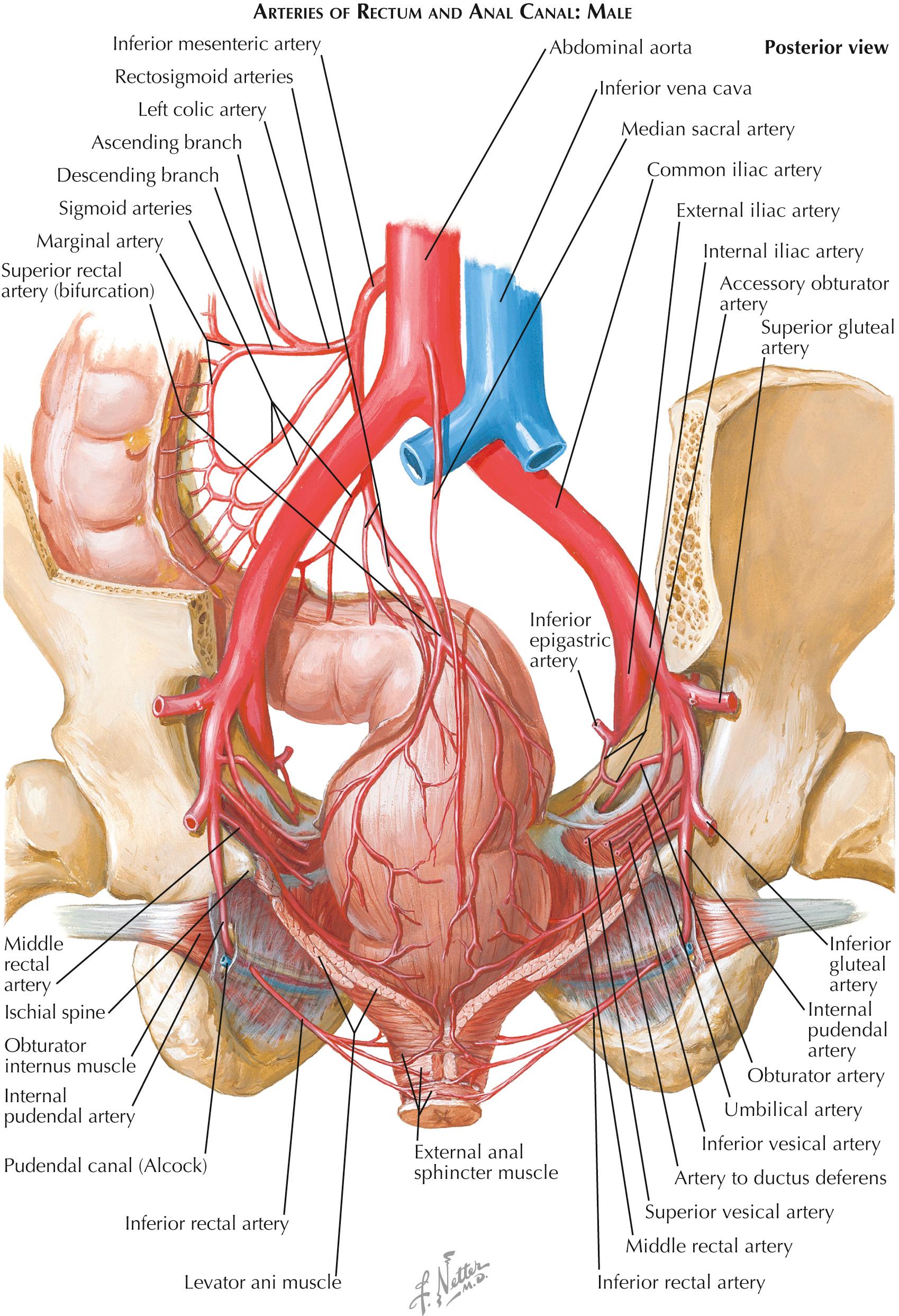
For the typical pattern of arterial branching of the intestines, please refer to Plates 1-1 and 1-2. In this section we will describe the variations concerning the origin, course, anastomoses, and distribution of the vessels supplying the large intestine. These variations are so frequent that conventional textbook descriptions are inadequate for anyone attempting procedures in the area. Briefly, the typical pattern of branching of the arteries to the large intestine is as follows: The ileocolic artery, from the superior mesenteric artery, supplies the distal ileum and also gives off the appendicular artery. The cecum receives anterior and posterior cecal arteries from the ileocolic artery. Two other branches of the superior mesenteric artery, the right and middle colic arteries, supply the ascending and transverse colon, respectively. The inferior mesenteric artery splits into left colic, sigmoid, and superior rectal arteries, which supply the descending colon, sigmoid colon, and rectum, respectively. The right, middle, and left colic arteries all feed into the marginal artery (of Drummond), an artery that parallels the colon itself; it allows all these vessels to anastomose and provides redundancy in blood supply. Many straight arteries leave the marginal artery and enter the colon itself.
During an appendectomy, identifying and isolating the blood supply of the vermiform appendix is imperative, making familiarity with variations in the branching patterns of the distal ileocolic artery particularly important. The ileocolic artery usually splits into ileal and colic branches. The ileal branch anastomoses with the ileal arteries but also gives off the appendicular artery, which runs posterior to the ileal branch to reach the appendix. The colic branch of the ileocolic artery typically gives off the posterior and anterior cecal arteries. The appendicular artery may exit the ileal branch distally and not run posterior to it ( Plate 3-15A ). The anterior cecal, posterior cecal, and appendicular arteries may also branch from the ileal branch. In such a case, the appendicular artery may originate from the posterior cecal branch ( Plate 3-15B ). There may also be one or more arcades formed between the ileal branch and the colic branch of the ileocolic artery ( Plate 3-15C to I). The anterior and posterior cecal branches may leave this arcade rather than the colic branch ( Plate 3-15C ), or they may leave as a common trunk and separate thereafter ( Plate 3-15D ). There may be two posterior cecal branches ( Plate 3-15E ), and the appendicular artery may originate from the posterior cecal artery, or both the anterior and posterior cecal arteries can give rise to two appendicular arteries ( Plate 3-15F ). Multiple appendicular arteries may also arise from the arcade and ileal branch ( Plate 3-15G ), or in some cases, the appendicular artery in its entirety may arise from the colic branch of the ileocolic artery ( Plate 3-15H ). There may be more than one arcade running between the ileal and colic branches, further complicating the possible variations ( Plate 3-15I ). With double appendicular arteries, both may supply the entire appendix or one may take care of the organ's base and the other, the tip.
In nearly one fifth of the population, the right colic artery is absent. In such a case, the ascending colon is still supplied with blood from the ileocolic and middle colic arteries that perfuse the marginal artery ( Plate 3-16A ). At other times, the right colic artery may indeed exist but instead of leaving the superior mesenteric artery directly, it leaves the ileocolic artery ( Plate 3-16B ). As a separate branch of the superior mesenteric artery, the middle colic artery is frequently absent. In such instances the artery is often replaced by a common right middle colic trunk that gives off a middle colic branch ( Plate 3-16C ) and occasionally by an enlarged branch of the left colic artery, the latter at times reaching the hepatic flexure ( Plate 3-16D ). An accessory middle colic artery may be present. It usually anastomoses with branches from the left colic artery in the left side of the transverse mesocolon ( Plate 3-16E ). This accessory middle colic artery may also arise from the trunk of the middle colic artery to serve the splenic flexure. At other times a single middle colic artery may give off two large trunks leading toward the hepatic and splenic flexures, where the ascending and descending colon meet the transverse colon ( Plate 3-16F ). The marginal artery, which parallels the ascending, transverse, and descending colon, typically allows significant anastomosis between the right, middle, and left colic arteries. It may be discontinuous, so that a region of the colon ( Plate 3-17G shows the proximal ascending colon) has only one of the colic arteries contributing blood to the organ. Another variation is a large trunk running between the middle and left colic arteries, creating an additional anastomosis besides the marginal artery. This is referred to as the arc of Riolan ( Plate 3-17H ), and the additional vessel can be found in the transverse mesocolon between its two parent branches.
The middle colic artery also has the bizarre tendency to sometimes originate from branches of the celiac artery, which typically supplies only the foregut organs. This is strange because even though the transverse colon is located in close proximity to several foregut organs, it is near the end of the midgut; one would not therefore expect that it would have any blood supply in common with foregut organs. The middle colic artery may arise from the dorsal pancreatic artery in the vicinity of the transverse pancreatic artery before entering the transverse mesocolon to supply the transverse colon ( Plate 3-17I ). The situation may also be reversed, with the dorsal pancreatic artery originating from the middle colic artery ( Plate 3-17J ). Far less frequently, this situation may be more complex, with the middle colic artery originating directly from the celiac trunk or splenic artery before giving off the transverse pancreatic artery. Occasionally, the middle colic artery originates behind the head of the pancreas from an accessory right hepatic artery or from a common trunk, giving rise to both the right hepatic artery and middle colic artery ( Plate 3-17K ). The middle colic artery may also sometimes give off the right gastroomental artery ( Plate 3-17L ), which is typically a branch of the gastroduodenal artery, a tributary of the celiac trunk.
In all of these cases, an additional anastomosis between the celiac trunk and superior mesenteric artery is created within the body of the pancreas. Typically these two parent arteries anastomose via arteries originating from the superior pancreaticoduodenal branch (celiac trunk) and inferior pancreaticoduodenal branch (superior mesenteric artery), which supply the head of the pancreas and descending duodenum. The additional anastomosing arteries in the body of the pancreas are predominantly small (1 mm in diameter) but may enlarge, especially when connecting the superior mesenteric artery with the hepatic or right gastroomental artery, reaching a diameter of 2 to 3 mm.
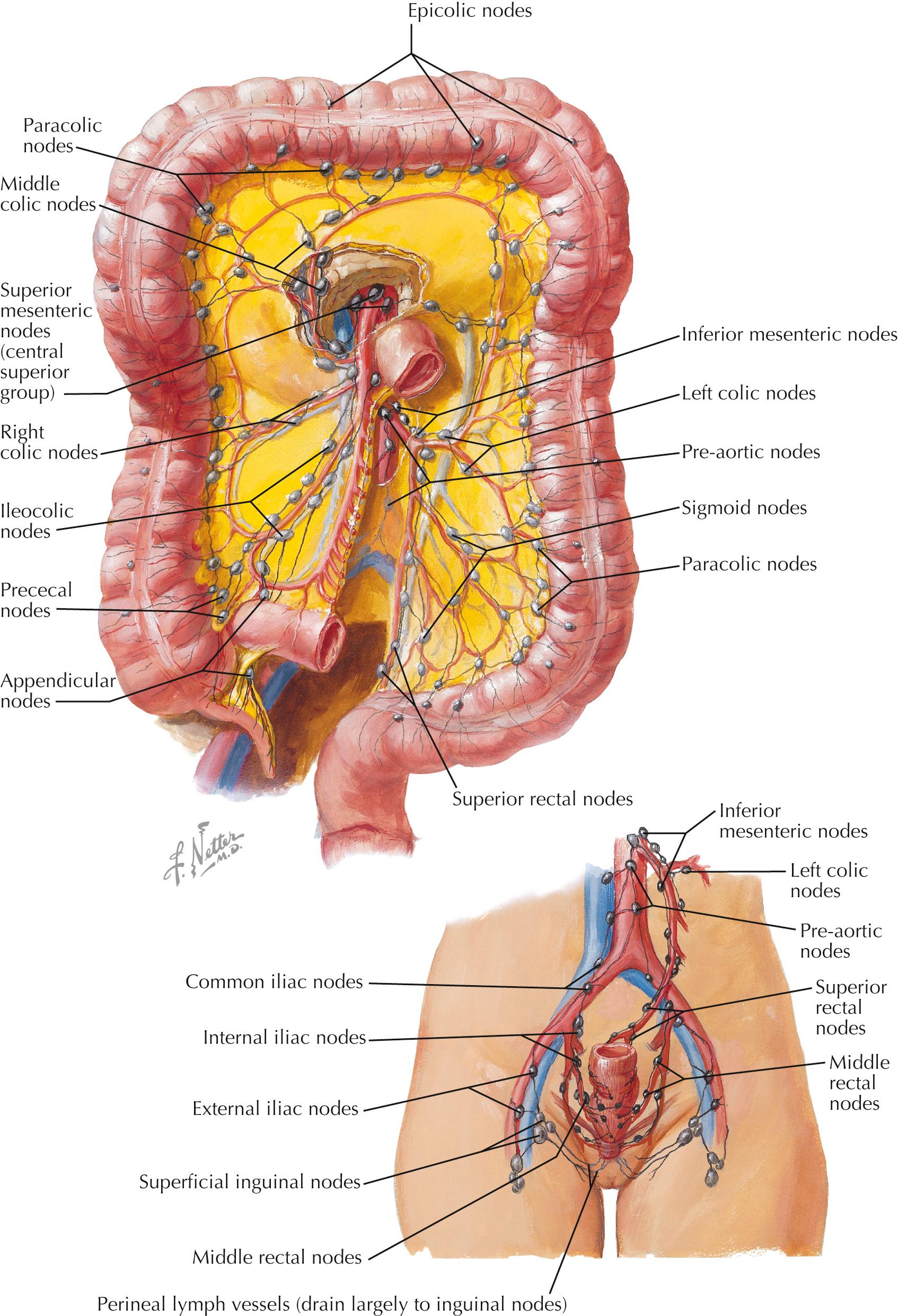
Lymphatic fluid from the large intestine might first encounter the diffuse epicolic nodes, which are situated immediately beneath the serous membrane on the intestinal wall. Because these are so few, much of the colon's lymphatic fluid likely bypasses these nodes. The first important regional lymph nodes are the paracolic nodes, located within the mesentery near its attachment to the ascending, transverse, descending, and sigmoid colon. These nodes send fluid through lymphatic ducts that parallel the nearby vessels to reach nearby regional lymph nodes: ileocolic, right colic, middle colic, and left colic lymph nodes, appertaining to the respective regions of the large intestine. The majority of the lymph nodes along the course of the ileocolic artery receive their lymph from the ileocecal region, including the appendix (prececal, retrocecal, ileocecal, and appendicular nodes). There are interconnections between the ileocecal and retroperitoneal lymphatics, including those that run near the spermatic vessels, accounting for the occasional migration of bacteria from the ileocecal zone into the superficial lymph nodes of the inguinal region. Similar interconnections occur on the left side of the body.
The ileocolic, right colic, and middle colic lymph nodes send fluid along the accompanying blood vessels to reach the superior mesenteric nodes located at the base of the vessel. The lymph ducts from the descending and sigmoid colon follow the branches of the inferior mesenteric vessels and lead to the inferior mesenteric nodes. The lymph from the region of the splenic flexure flows partly into the superior mesenteric lymph nodes and partly into the inferior mesenteric lymph nodes.
Some of the lymphatics emanating from the inferior mesenteric nodes follow the uppermost branches of the inferior mesenteric vessels, passing from left to right in a craniomedial direction around the duodenojejunal flexure to reach the superior mesenteric nodes. In contrast, lymph ducts draining the lower parts of the colon on the left run to the preaortic lymph nodes and thence into the lumbar, superior mesenteric, and celiac lymph nodes. Lymphatic fluid in this region enters the cisterna chyli, a saclike lymphatic vessel. The cisterna chyli also receives much of the lymphatic fluid drained from the lower limbs, pelvic organs, hindgut, midgut, and foregut organs. From the cisterna chyli, lymph drains superiorly through the thoracic duct. This large lymphatic vessel has prominent valves in its wall and is found in the posterior mediastinum between the aorta and the esophagus. It travels posterior to the arch of the aorta to ultimately drain the lymphatic fluid into the venous system at the left subclavian vein near its junction with the left internal jugular vein.
Lymphatic vessels emanating from the rectum and anal canal run in two main directions. The upper part of the anal canal is drained cranially via various intermediary nodes to the preaortic lumbar lymph nodes, which project fluid to the inferior mesenteric nodes. From the lower part of the anal canal, lymph vessels pass over the perineum, alongside the scrotum or labia majora and inner margin of the thigh, to the superficial inguinal lymph nodes.
From the region of the surgical anal canal of the rectum, the lymphatic fluid passes into anorectal nodes lying immediately posterior to the lower portion of the ampulla and from there to sacral nodes situated behind and adjacent to the rectum in the concavity of the sacrum. From the area of the rectal ampulla and above, lymphatics run directly to the sacral nodes, and from the lateral parts of the inferior region of the rectum, lymphatics extend to the pararectal nodes. Lymph flows through vessels alongside the three rectal arteries in a superior direction to the internal iliac lymph nodes and thence via the common iliac nodes to the preaortic and lumbar nodes. This fluid follows the normal path to reach the cisterna chyli, thoracic duct, and left subclavian vein.
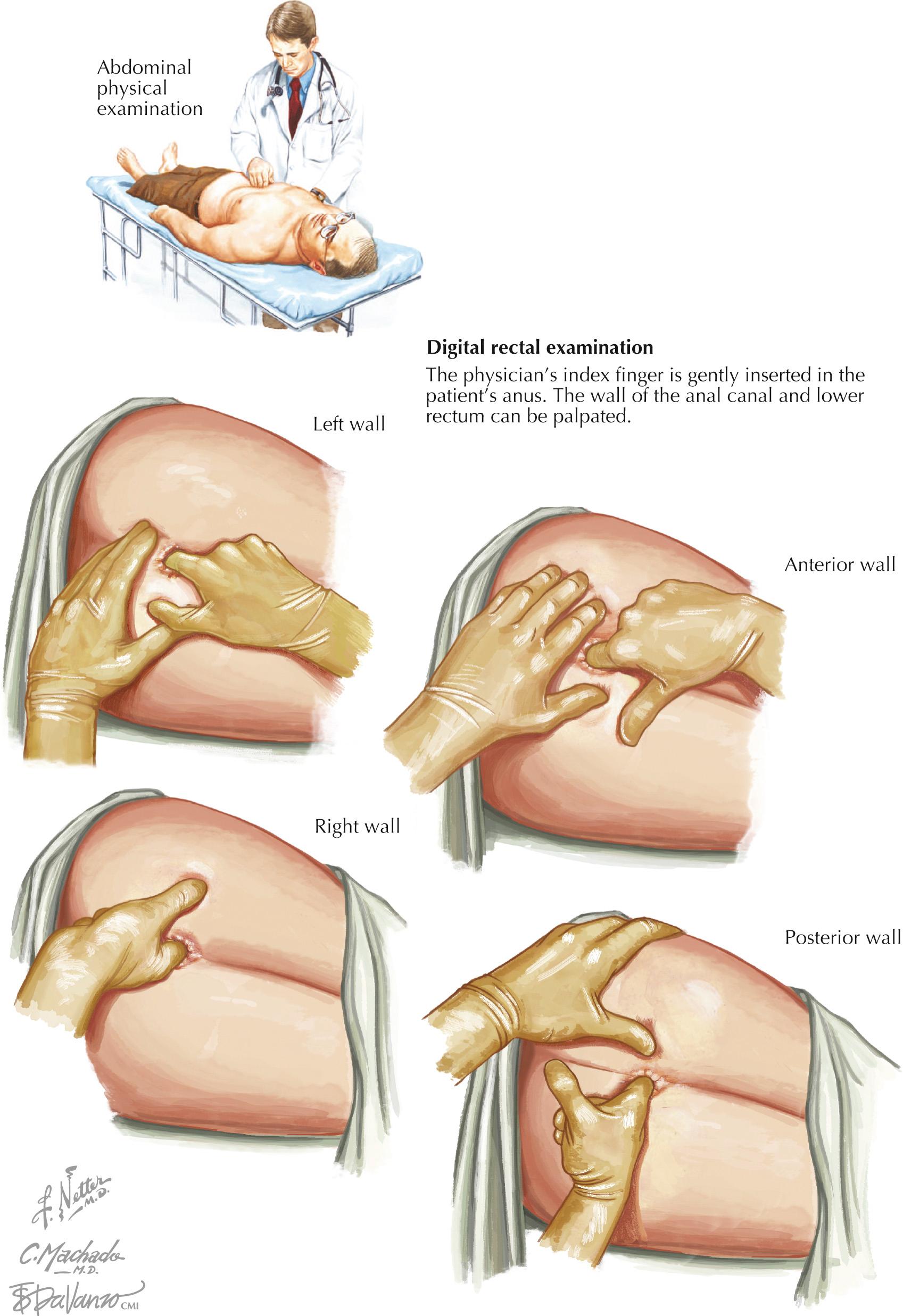
The physical examination is essential for determining the cause of a patient's chief complaint. Gastrointestinal examinations have three general parts, inspection, auscultation, and palpation. The provider should first inspect the abdomen for asymmetry, protuberances, scarring, erythema, hernias, striae, or bruising. Inspection is best done by approaching the abdomen as four quadrants or nine segments, while keeping in mind each organ's anatomic position in the body.
Each of the four quadrants of the abdomen should be auscultated with a stethoscope. Auscultation should always be performed before palpation to prevent disruption of the migrating motor complex of the intestines. A patient is said to have normal bowel sounds if sounds are heard at intervals of approximately 5 to 10 seconds. Sounds heard at intervals of less than 5 seconds are considered hyperactive sounds, and sounds heard at intervals of anything over 10 seconds are considered hypoactive sounds. Hyperactive bowel sounds could support a diagnosis of gastroenteritis, obstruction, irritable bowel syndrome, or bleeding. Hypoactive sounds could suggest obstruction, impaired motility, or perforation. It takes 3 full minutes of listening in one area to determine if bowel sounds are absent.
The practitioner should conclude the abdominal examination with percussion and palpation of all four quadrants. Tympanic percussion may signify the presence of gas or free air, whereas dullness to percussion suggests the presence of a solid mass or excess fluid or stool. Palpation should start in a shallow manner; a second pass may become deep if tolerated by the patient. One should try to palpate the afflicted area last. Specialized maneuvers can also be done to rule in a specific pathologic condition. For example, a positive Murphy sign is elicited when a practitioner palpates the right upper quadrant and there is a pause in respiration resulting from associated pain. A positive Murphy sign would support a diagnosis of cholecystitis.
The digital rectal examination is indicated as part of a full physical examination and can be a focused component of a urologic, gynecologic, gastrointestinal, or neurologic complaint. This examination may reveal a perianal pathologic condition, rectal bleeding, rectal pathologic condition, or prostate problems. There are many possible positions in which to perform the rectal examination. The two most common are the dorsal lithotomy and the left lateral recumbent position where the knees are tucked toward the chest. When beginning the examination, take time to inspect the external anal area for masses, hemorrhoids, skin tags, scars, fistulae, or fissures. The perianal area can be scratched first with a gloved finger or stick end of a cotton-tipped swab to determine the integrity of the anal wink, which is a sign of neurologic integrity. Next, the provider should insert a properly lubricated, gloved finger into the rectum at which time an assessment of resting tone can take place. The entire circumference of the rectum should be assessed for masses, stool, decreased internal sphincter tone, and pain. The patient can be asked to squeeze the external anal sphincter to assess for tone if there are concerns for fecal incontinence. The prostate should be examined for hypertrophy or irregularities in all male patients. A patient with the complaint of constipation could be asked to try to simulate defecation to determine if the muscles do the correct action and to determine the degree of perineal descent. Failure of the muscles to perform correctly may indicate dyssynergia, but further testing is indicated for confirmation because the patient may be embarrassed or feel inhibited during the examination and the examination may not be representative of true function. At the conclusion of the examination, the gloved finger may be examined for blood, mucus, or abnormal stool. It is very important to explain each step to a patient when conducting the examination and refrain from using language that could make the patient feel uncomfortable or be misinterpreted.
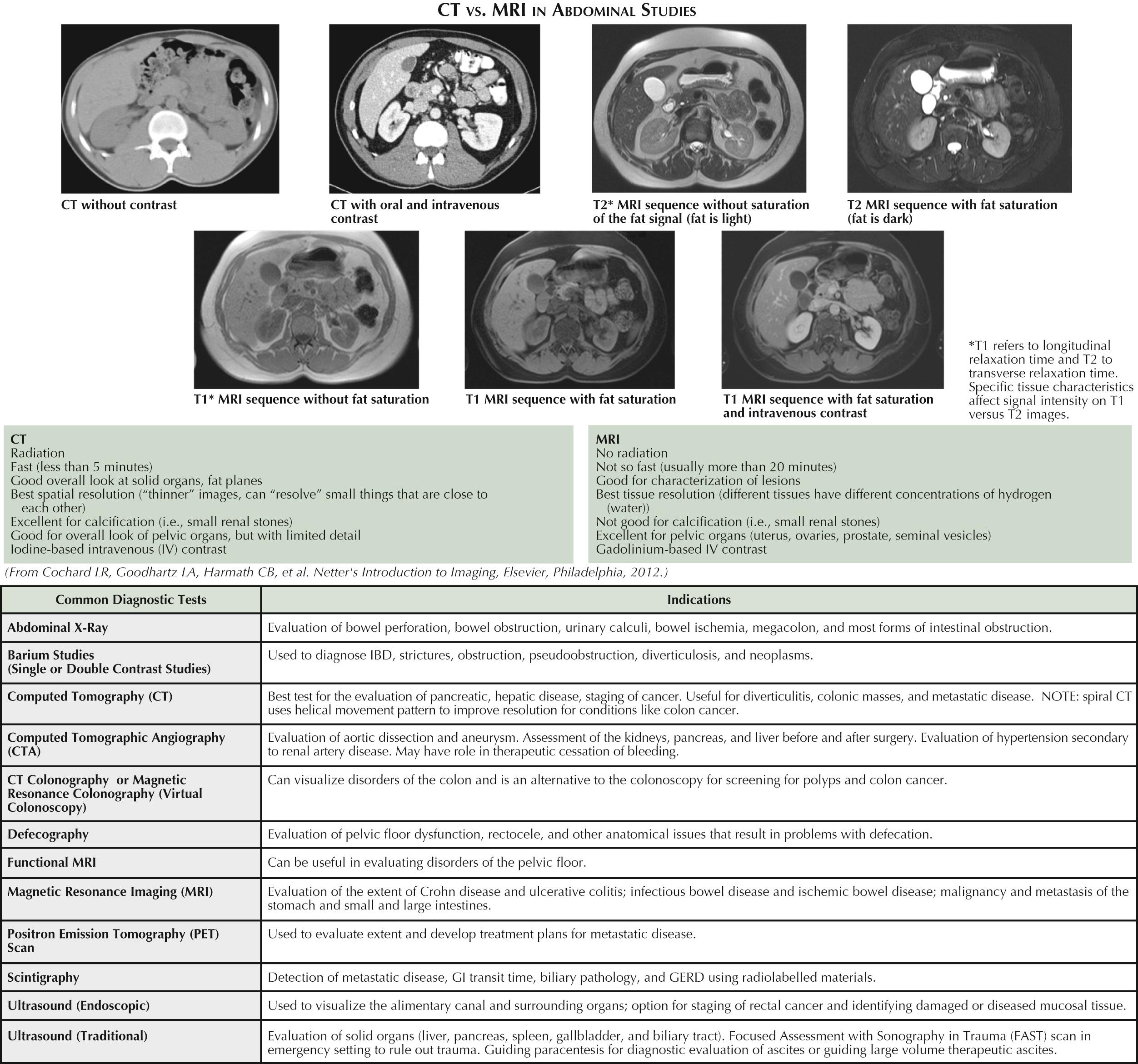
Over the last century, radiologic imaging and other radiographic modalities have made significant advancements that allow practitioners to easily visualize, diagnose, and treat disease.
The best approach to ordering an imaging test is to choose the one that best answers the clinical question at hand while limiting the cost and potential side effects. For example, a practitioner may choose to rule out perforation by ordering an upright abdominal x-ray because it is faster to obtain, produces significantly less radiation, and costs less than a computed tomography (CT) scan. If the x-ray shows free air under the diaphragm, this is diagnostic. The clinician may choose to get a CT scan to not only document perforation but to locate the cause of the perforation. The benefits of helping the surgeon characterize the perforation may be more important than limiting the expense or amount of radiation exposure. As an example, CT scanning may show a localized perforation or inflammatory changes associated with diverticulitis. It should also be remembered that an erect posteroanterior x-ray may not be sensitive enough to rule out pneumoperitoneum in some patients presenting with upper abdominal pain and perforation. Cost should always be a consideration for all patients, especially those who do not have adequate health care insurance.
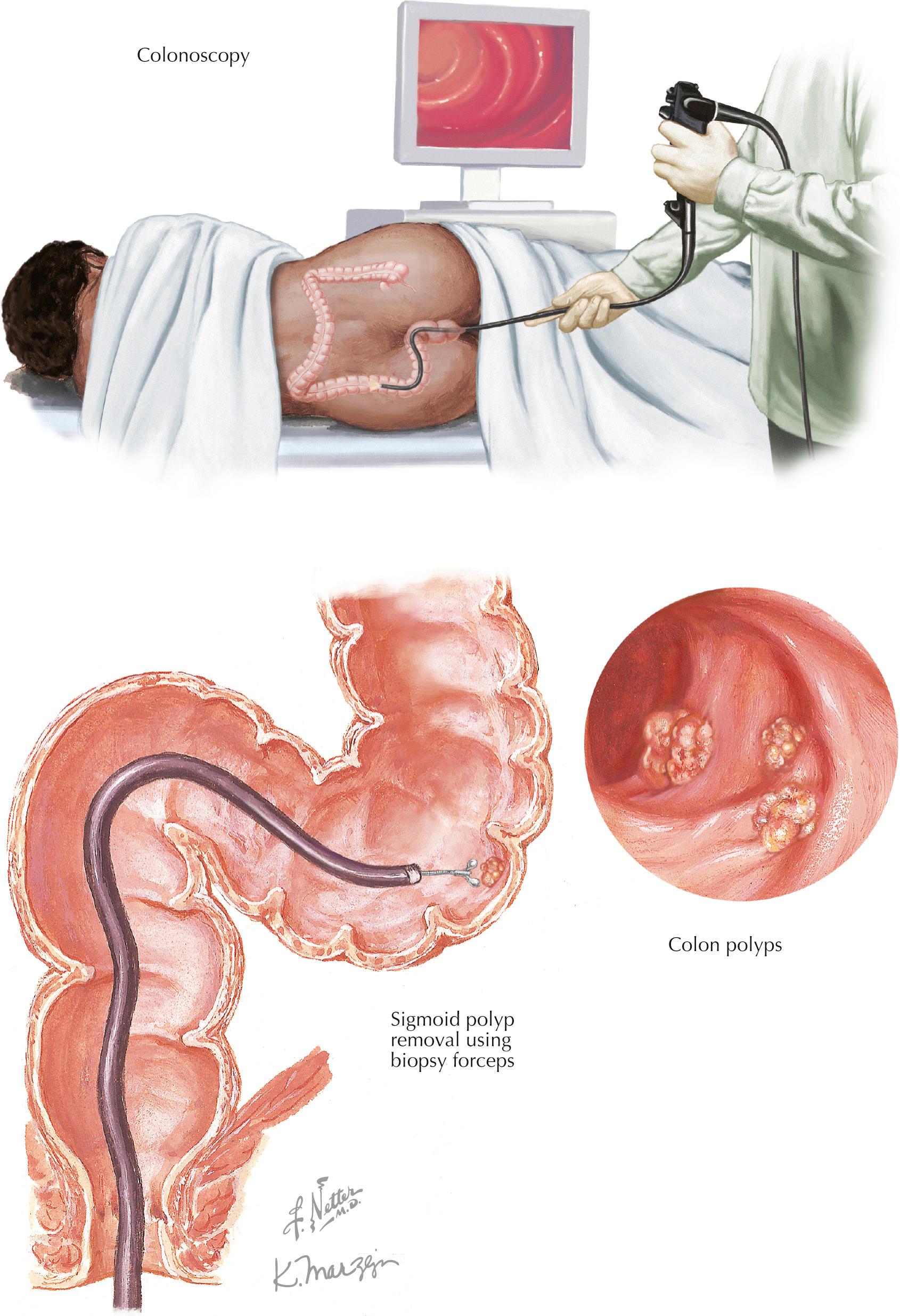
Colonoscopy is a procedure in which a long flexible tube is inserted into the rectum and colon to detect diseases of the large intestine. The indications for colonoscopy can include screening to detect colorectal neoplasms or diagnostic intent for the investigation of blood in the stool, anemia, diarrhea, and other symptoms. Sigmoidoscopy is a procedure in which the tube can be inserted for up to 60 cm from the anal verge. Indications for sigmoidoscopy include colorectal screening, preoperative evaluation prior to anorectal surgery, surveillance of a previously diagnosed lesion within the range of the sigmoidoscope, local treatment of disorders such as radiation proctitis, removal of foreign bodies, biopsies for graft-versus-host disease or amyloidosis, stent placement or balloon dilation, or hemostasis of local bleeding. The remainder of this section will focus on colonoscopy, although most information will also apply to sigmoidoscopy.
The first consideration is to be sure that there is an applicable indication for the procedure and that the timing for the procedure is appropriate (e.g., colonoscopy would not be performed on a patient in the hospital with pneumonia who is noted to have iron deficiency anemia without clinical compromise). The examiner should have adequate knowledge of the anatomy of the colon and the capabilities of the instrument and should be prepared to perform diagnostic and therapeutic procedures such as biopsy, control of bleeding, and polyp removal.
Although the number of colonoscopies required for competence in performing the procedure is variable between trainees, it has been suggested that 500 colonoscopies are likely required to ensure (>90%) a completion rate, but new competency-based assessments are being implemented.
Bowel cleansing in advance of a colonoscopy is required in most cases.
Sedation is indicated in most patients undergoing colonoscopy but may not be needed for sigmoidoscopy. Sedation can be accomplished with intravenous administration of either a short-acting hypnotic/amnestic agent such as propofol or with an opiate and benzodiazepine. The procedure can be carried out in the hospital or an outpatient endoscopy suite while the patient is placed in the left lateral position with knees bent and pulled up. Digital rectal examination preceding the introduction of a colonoscope is obligatory to rule out any impediment to the free passage of the instrument and to inspect the anal area for any lesions or defects.
The tip of the well-lubricated colonoscope (a long, flexible, narrow tube with a light and a tiny camera on one end) is inserted with steady pressure into the anal ring and slowly passed forward through the sphincters in the colon. The colonoscope is then advanced, always with the lumen in view to the cecum. A minimal puff of air from the insufflation bag will help to open the opposed folds if needed.
The scope enables the endoscopist to irrigate and suction the unwanted debris for better visualization.
Complete colonoscopy requires the visualization of the cecum. This is documented by taking pictures from the appendiceal orifice and the ileocecal valve. The diagnostic value of intubating the ileum during colonoscopy will need to consider the indication for the procedure.
Not every patient requires a complete examination of the colon. For example, in acute severe ulcerative colitis, the endoscopist may only need to evaluate the distal part of the colon and rectum due to a higher risk of complications with a complete examination. In the absence of conditions of this type, however, every reasonable effort should be made to perform a complete examination, to keep a short scope, to avoid excessive looping, and to use torque steering and rotation of the scope to reach the cecum.
The mucosa is carefully evaluated as the instrument is withdrawn by viewing the display monitor. Colonoscopists with longer mean times for withdrawal of the colonoscope may have higher adenoma detection rates. The inside of the colon can also be accessed with surgical instruments, which help with diagnostic and therapeutic interventions.
The examiner should not ignore anything that is encountered on the way in; if a constricting lesion is encountered, the examiner should not insist on advancing beyond it.
Like many other procedures, colonoscopy is not without risk, but mastering the required techniques will minimize the risk. The recognition and evaluation of pathologic conditions depend on a thorough acquaintance with the range of normal variation.
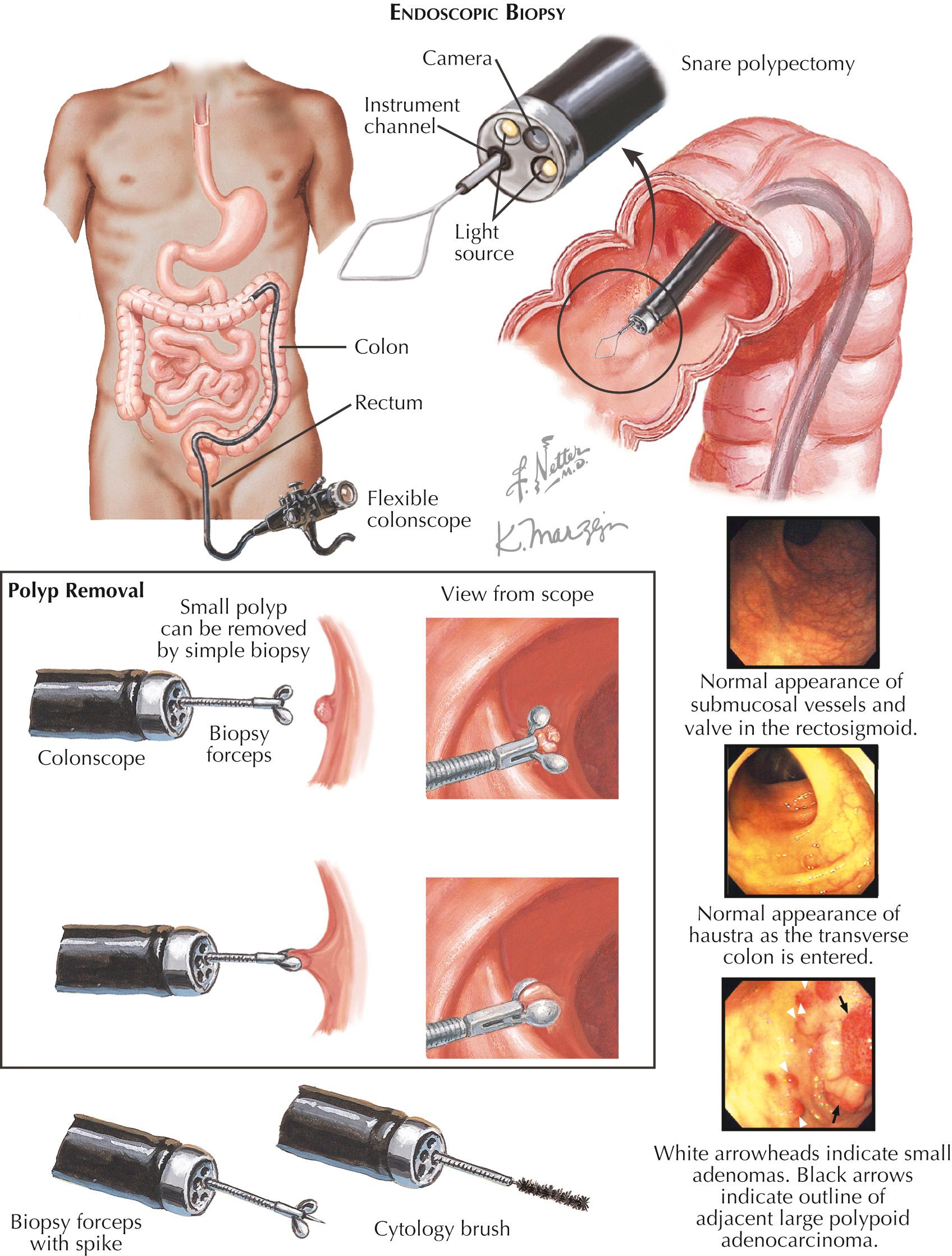
Pathologic specimens obtained through biopsy or cytologic studies provide critical information pertaining to a patient's illness. The following sections will discuss both biopsy and cytologic examination for the colon and rectum in greater detail.
Endoscopic biopsy is the most common technique used for tissue sampling of the colon and rectum. Biopsies are done using forceps with two cups varying in shape, size, and serration which allow for a single grasp of tissue. Most forceps come with a needle-spike apparatus that acts as both a grip and an anchor for sampling. Endoscopic forceps are considered hot forceps when they can cauterize tissue and are generally used to either stop internal bleeding or for a polypectomy. Most procedures use cold forceps, or those that cannot cauterize tissue. Practitioners also have the choice to use either single-use or reusable forceps. Although using single-use forceps guarantees less sample contamination, reusable forceps are much more cost-effective and are sanitary if cleaned properly.
Biopsies are best used to confirm a diagnosis and dictate future therapy. For example, in patients suspected of having Hirschsprung disease, a rectal biopsy can confirm the diagnosis before surgery is considered. How the biopsy is performed can vary considerably, as is seen with biopsy for ulcers, where the pathologist requires samples from the edge and the base to rule out different causes. Endoscopic biopsy is associated with a minimal risk of bleeding and perforation; however, biopsy is contraindicated when patients already are at high risk for bleeding or for colonic perforation. The following is a list of conditions that frequently warrant biopsy:
Chronic diarrhea: To make the diagnosis of microscopic colitis (e.g., collagenous or lymphocytic colitis) and amyloidosis
Inflammatory bowel disease: Diagnosis and evaluation of Crohn disease and ulcerative colitis; screening for colon cancer
Polyps and colon cancer: For initial diagnosis; follow-up for full removal of cancer
Infectious colitis: Common causes being E. coli O157:H7, salmonella, shigella, campylobacter, and Clostridium difficile
Other conditions: To c onfirm the diagnosis of Hirschsprung disease, anal cancers, lipomas, Peutz-Jeghers syndrome, Behçet disease, and any unexplained abnormalities of colonic tissue
Cytologic study is an alternative method to biopsy that can characterize infections and colonic growths, such as adenoma progressing to adenocarcinoma. As the name implies, in brush cytologic study, a flexible brush is rubbed across the area of interest in the colon. The act of brushing removes cells from the area that can later be studied with the use of a microscope. Although this technique has limited use for most diseases of the colon, brush cytologic study has been shown to be as accurate as endoscopic biopsy in diagnosing colorectal cancer and it provides the best diagnostic yield when paired with biopsy results. Anorectal cytologic study is considered the diagnostic gold standard when screening for anal cancer.
There is a debate in the literature about stopping anticoagulation agents (e.g., coumadin, heparin, and direct factor Xa inhibitors) and antiplatelet agents (e.g., aspirin and clopidogrel) when performing tissue sampling to reduce the risk of procedural bleeding. Stopping these medications comes with the adherent risk of an adverse outcome from a thromboembolic event. The overall risk of bleeding for a cold biopsy is less than a 1%; the risk is higher with polypectomy and the use of hot forceps or a snare. The American Society for Gastrointestinal Endoscopy has created guidelines as to when these medications should be stopped based on both the risk associated with each procedure and the risk of an adverse event associated with each condition. Patients undergoing low-risk procedures should continue anticoagulation therapy and undergo the procedure as long as their international normalized ratio (INR) is therapeutic. Patients undergoing high-risk procedures should stop their anticoagulation medication 3 to 5 days before the procedure and restart it within 24 hours after the procedure or at the time judged best by the practitioner. Those with conditions that have a high risk of thromboembolic events should be started on heparin until a few hours before the procedure begins, whereas those with low-risk conditions do not need a heparin bridge. Conditions considered to have a high risk for thromboembolism are atrial fibrillation with a history of cerebrovascular accident or embolism with a mechanical valve, mechanical mitral valve, mechanical valves with a previous thromboembolic event, acute coronary syndrome, placement of a stent within the last year, and percutaneous intervention with no stent after a myocardial infarction.
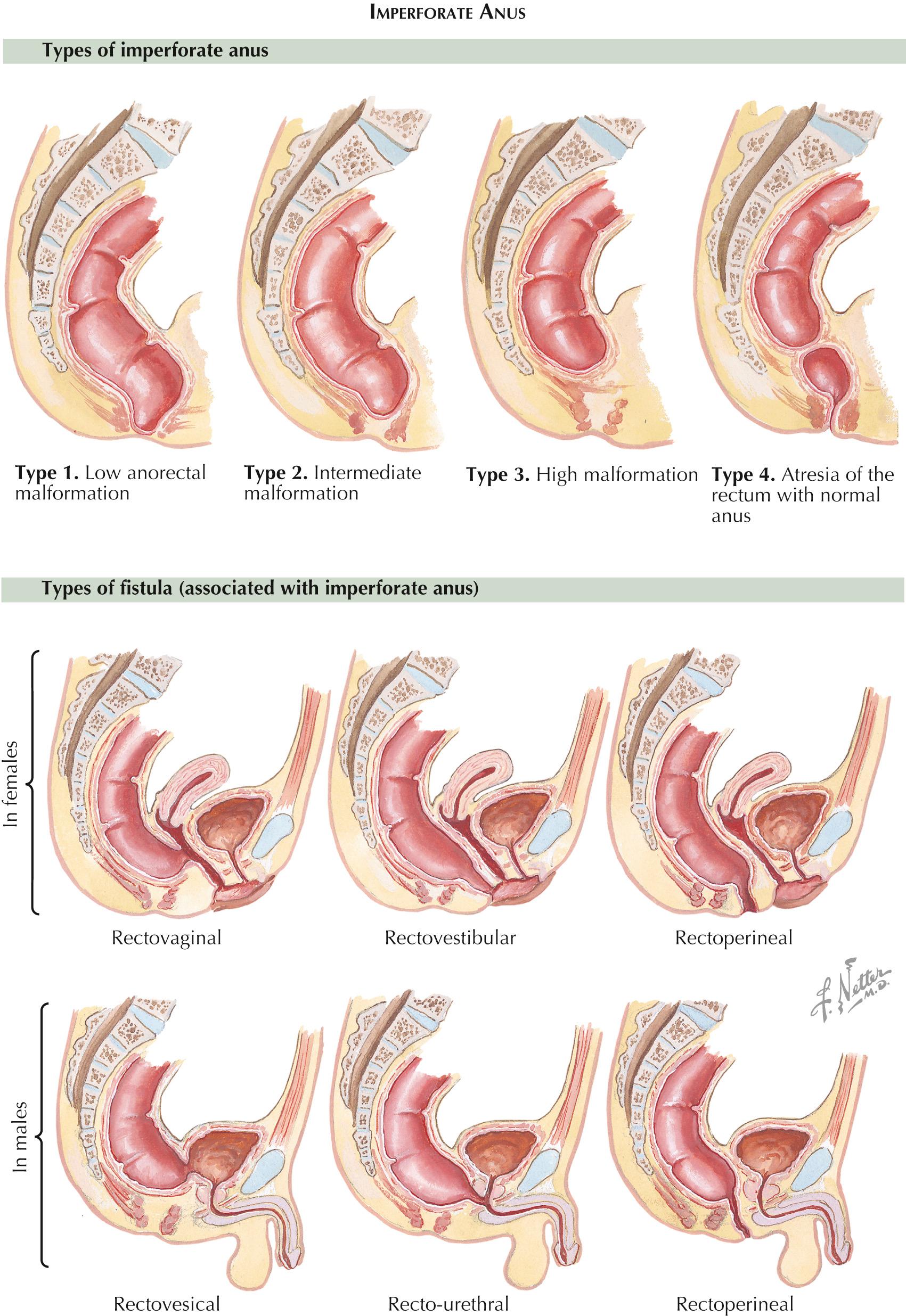
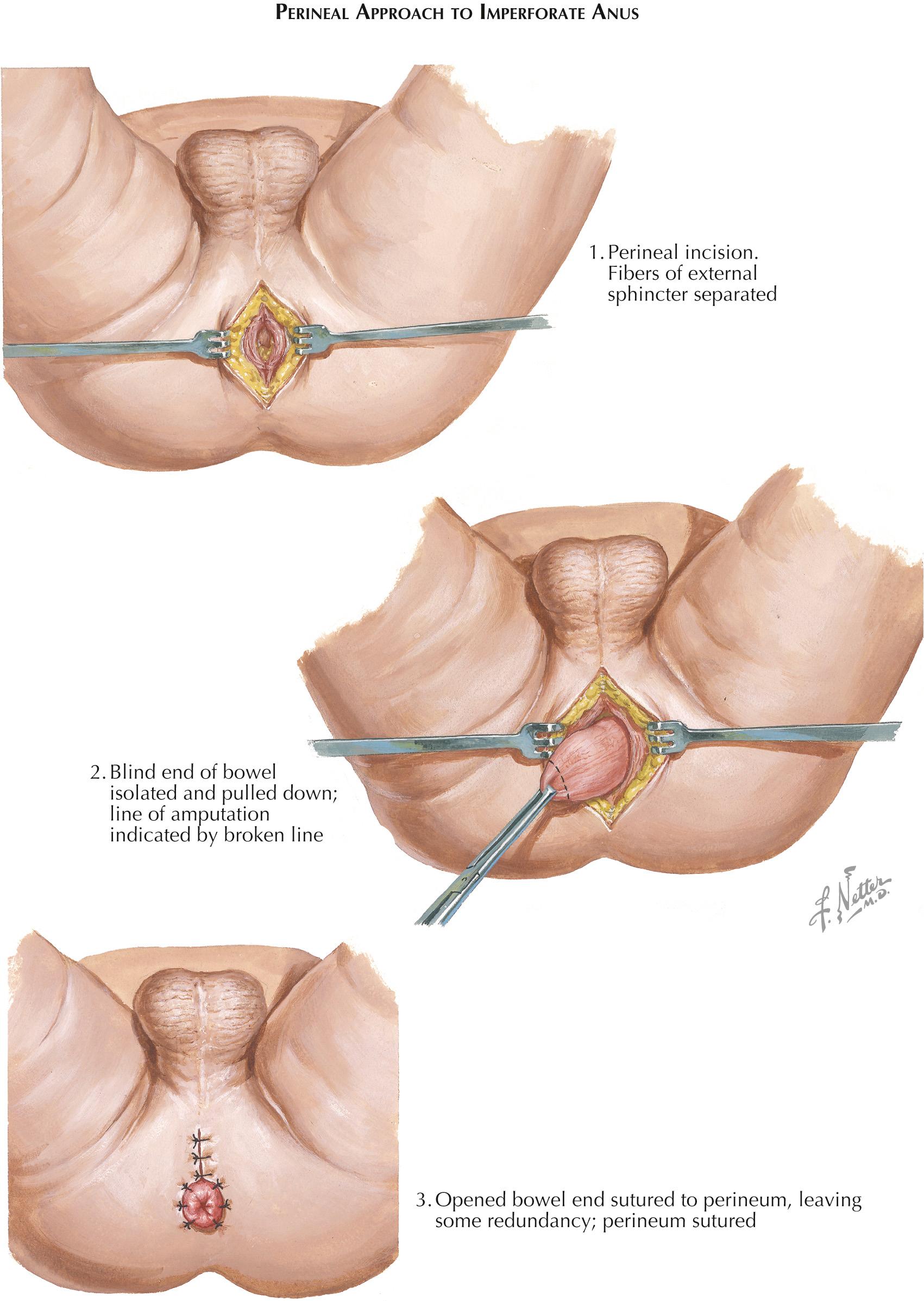
Normally, by the eighth week of embryonic life, the cloacal membrane, which separates the rectum and the anal invagination, is absorbed, so that the anus and rectum become one continuous canal. When this membrane fails to disintegrate, there is no opening where the anus should be, resulting in a condition known as imperforate anus. This is one of the most common congenital anomalies encountered in neonates (1 : 5000 live births) and is slightly more prevalent in males. Several variants of this condition have been observed. Traditionally, these defects have been classified as low, intermediate, or high based on anatomic criteria, including the position of the blind rectal pouch relative to the levator ani muscle complex and pelvic bony landmarks. Imperforate anus without fistula is rare (only 5% of anorectal malformations), and of those, 95% occur in association with Down syndrome. Rarely, the anal canal develops normally, but there is total atresia of the rectum. It is important to recognize the nature of the malformation because of the different surgical approaches used in the repair of these anomalies (see Plate 3-26 ).
Anorectal malformations are frequently accompanied by incomplete separation of the rectum and the urogenital sinus, so that most infants with an imperforate anus have a fistula between the rectum and the urinary tract or perineum in the male, or between the rectum and the vagina or perineum in the female. In the male, the fistula may enter the bladder (rectovesical) or the prostatic or bulbar urethra (rectourethral), or may emerge in the skin of the scrotum or perineum (rectoperineal). Rectourethral fistular tracts are the most common in males, followed by rectoperineal fistulas. In the female, the fistula may open into the vagina (rectovaginal), the vestibule (rectovestibular), the posterior fourchette, or the perineum (rectoperineal). Rectovestibular fistulas are most common in females, followed by cutaneous rectoperineal fistulas. The next most common defect in females is that of persistent cloaca, in which there is a single opening formed by fusion of the rectum, vagina, and urethra.
Imperforate anus is usually diagnosed by careful inspection or discovered upon attempting to insert a rectal thermometer. If no meconium is seen within 24 hours, patency of the anus should be assessed to rule out the rare atresia of the rectal canal in the presence of a fully formed anus. When meconium is present, its source should be carefully identified. The presence of a perineal fistula associated with a low anorectal malformation is sometimes missed when meconium has passed through the fistula rather than the anus. Inspection of the perineum also should be carried out to look for the presence of a rectoperineal fistula. A rectovestibular fistula is manifested as a third opening within the vestibule in addition to a normal urethral meatus and vagina. The presence of only a single perineal opening indicates a persistent cloaca. Other diagnostic signs depend on the size and location of the fistula. Meconium may appear at the urethral meatus, or flecks of it may be found in the urine on microscopic examination, but this typically takes 24 hours to occur. Air in the bladder, a rare demonstration by x-ray, indicates a communication between the intestinal and urinary tracts. If a fistulous opening is present in the perineum, introduction of contrast dye (fistulography) may reveal the origin and level of the fistulous connection. Alternatively, it may also be possible to outline the fistula by introducing contrast dye into the bladder (cystourethrography). Newer radiologic techniques using MRI even in the fetal stage can be used to make the diagnosis.
If no clinical signs indicating the location of the anomaly become evident by 24 hours, the distance between a blind rectal pouch and the anal dimple can be assessed radiologically using anatomic criteria. Air taken into the gastrointestinal tract and passed along by peristalsis toward the rectum during the first 24 hours is visualized upon x-ray with the infant in an inverted position so that the air bubble reaches the lower limit of the rectal pouch. Its location relative to a radiopaque marker placed at the location of the anal dimple and relative to bony markers such as the pubococcygeal line and the ischial line are used to determine the distance between the rectal pouch and the anal dimple. This allows anorectal malformations to be broadly classified by location of the rectal pouch as high (supralevator), intermediate (partially translevator), or low (fully translevator).
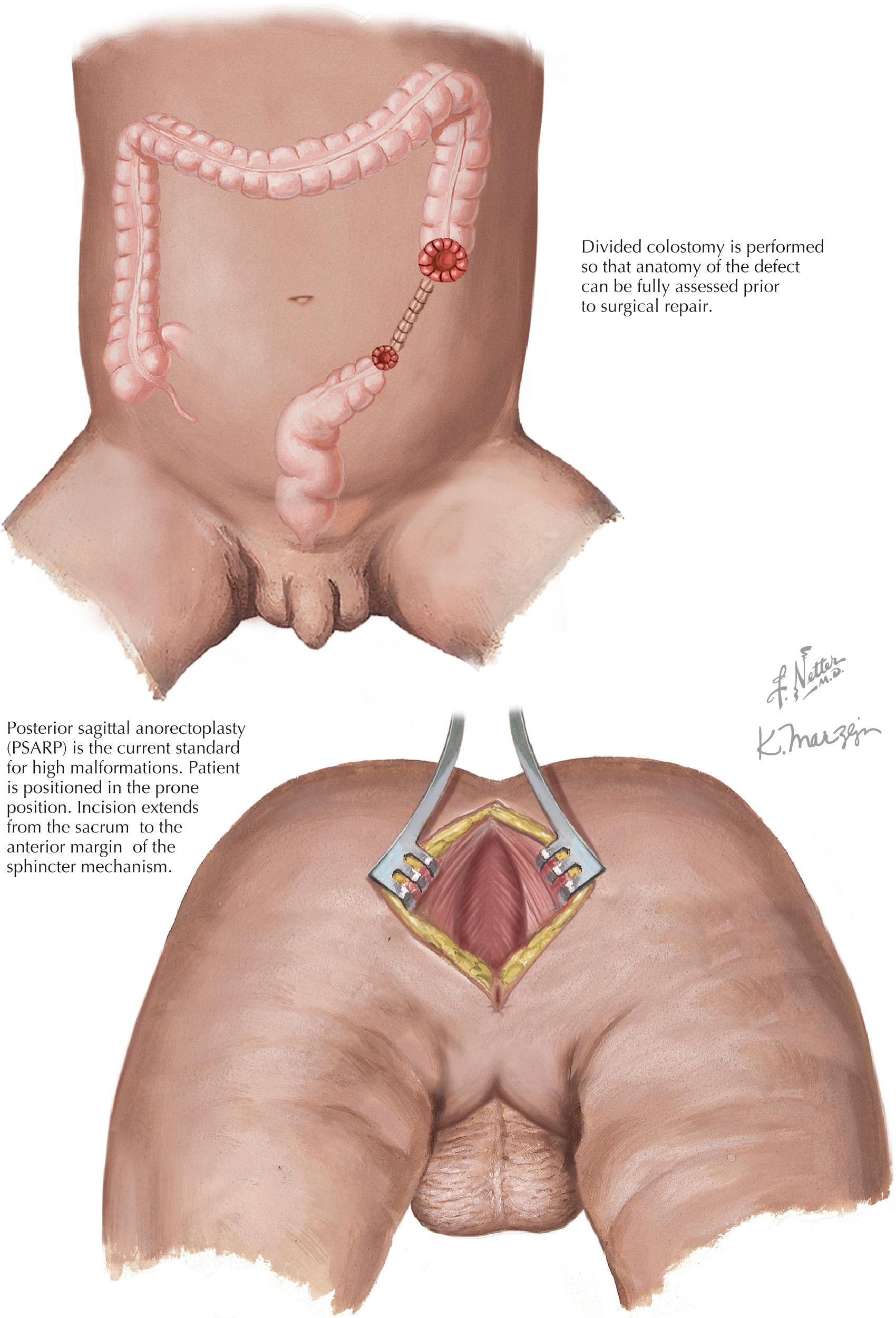
The goal of surgery to repair anorectal malformations has evolved from a primarily life-saving procedure to one that allows for as much preservation of gastrointestinal, urinary, and sexual function as possible. This is critical to allow affected children to have normal social interactions and to develop into healthy adults.
In the simplest case, an imperforate anus in which meconium can be seen behind a thin membrane over a properly located anus seldom needs major surgical management. Perforation of the membrane with a blunt instrument is simple, safe, and completely effective. For boys and girls with a low anorectal malformation, a definitive surgical repair can be undertaken using a perineal approach. The external sphincter is located using an electrical muscle stimulator. With the patient in the lithotomy position, any perineal fistula is dissected toward the rectum. A longitudinal incision in the perineum provides the best and safest exposure. Dissection in the operative area is kept close to the midline to avoid damaging the nerve and blood supply. The fibers of the external sphincter muscle appear as a rough horseshoe with the apex pointing posteriorly. The blind pouch of the rectum appears as a blue bulbous mass because it is filled with meconium. For the purpose of traction, the most distal portion of the rectal pouch is grasped (with a hemostat or silk sutures). Dissection is continued, keeping as close as possible to the bowel and avoiding disruption of adjacent structures, until sufficient length of colon has been mobilized to permit the apex of the pouch to be brought to the skin edge without tension. The pouch is opened and evacuated of meconium. A row of simple sutures approximates the full thickness of the open bowel with the skin of the opened anal dimple. The remaining anterior portion of the perineal incision is closed in layers.
In the case of intermediate and high anorectal malformations, the distance of the hindgut from the anus and the nature and location of a potential fistula may not be clear, necessitating additional anatomic studies. Because exploratory surgery from the perineum without knowledge of the anatomy carries the risk of iatrogenic injury, in such cases a decision may be made to create a divided stoma near the junction of the descending and sigmoid colon. The divided colostomy allows the passage of stool and is sufficiently proximal to allow further elucidation of the anatomy without impeding a subsequent surgical correction. Introduction of contrast dye through the mucous fistula with sufficient pressure can be used to delineate the location of a urinary fistula. Once the anatomy of the defect is fully appreciated, surgical repair can be undertaken.
The current standard for surgical reconstruction in these cases is posterior sagittal anorectoplasty, developed by Pena and colleagues. In this procedure, the patient is placed in a prone position with the pelvis elevated. A midline sagittal incision is made from the sacrum to the location of the anal dimple, and the underlying muscle is divided. Muscle stimulation is used throughout the procedure to identify muscle layers, including the sphincter complex, which is usually poorly formed in these patients, and the levator ani. The posterior approach allows the hindgut to be safely accessed and the fistula to be dissected from associated structures of the urinary tract or vagina, for example. A sufficiently mobilized length of rectum is positioned within the sphincteric muscles, which are reconstructed and sutured to the rectum. Certain lesions, such as rectovesicular and rectoprostatic malformations, are so high in the pelvis that they cannot safely be reached by posterior sagittal anorectoplasty alone. These cases may require a concurrent laparoscopy or even laparotomy for successful division of the fistular connection and repositioning of the rectum. For maintenance and voluntary control of fecal continence, both afferent and efferent nerves must be carefully preserved. Despite these precautions, a significant percentage of patients with high anorectal malformations suffer from an increased incidence of fecal incontinence.
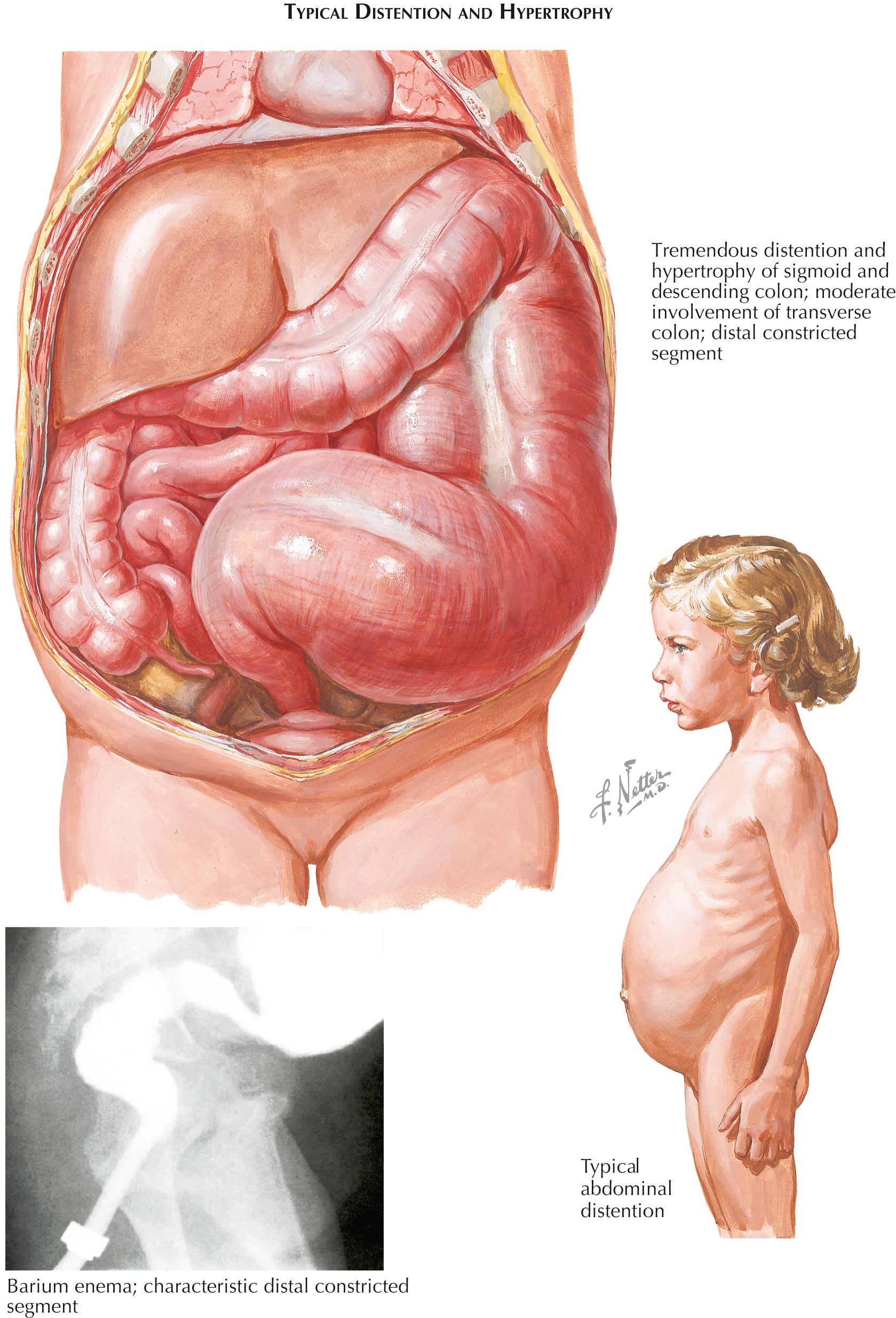
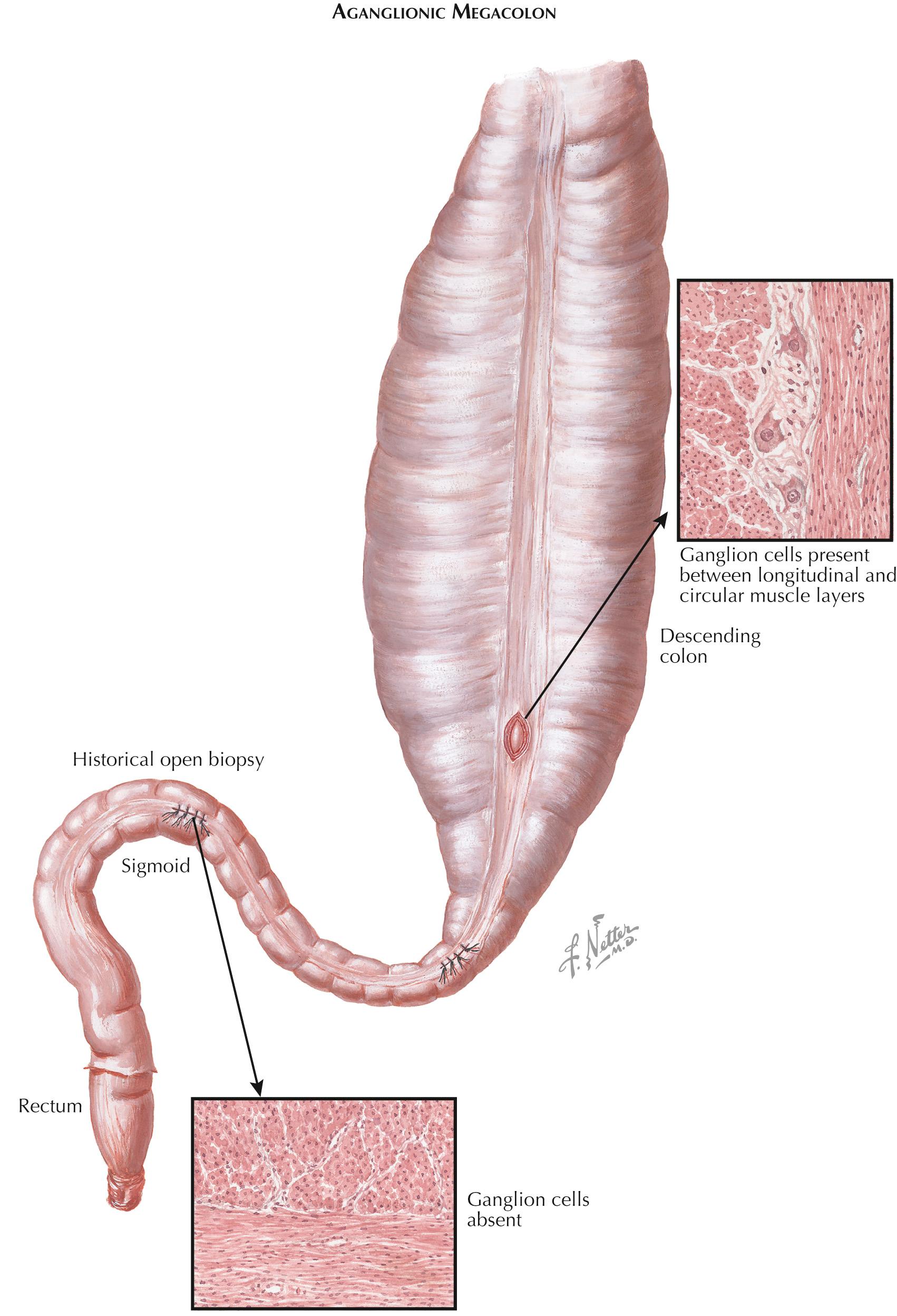
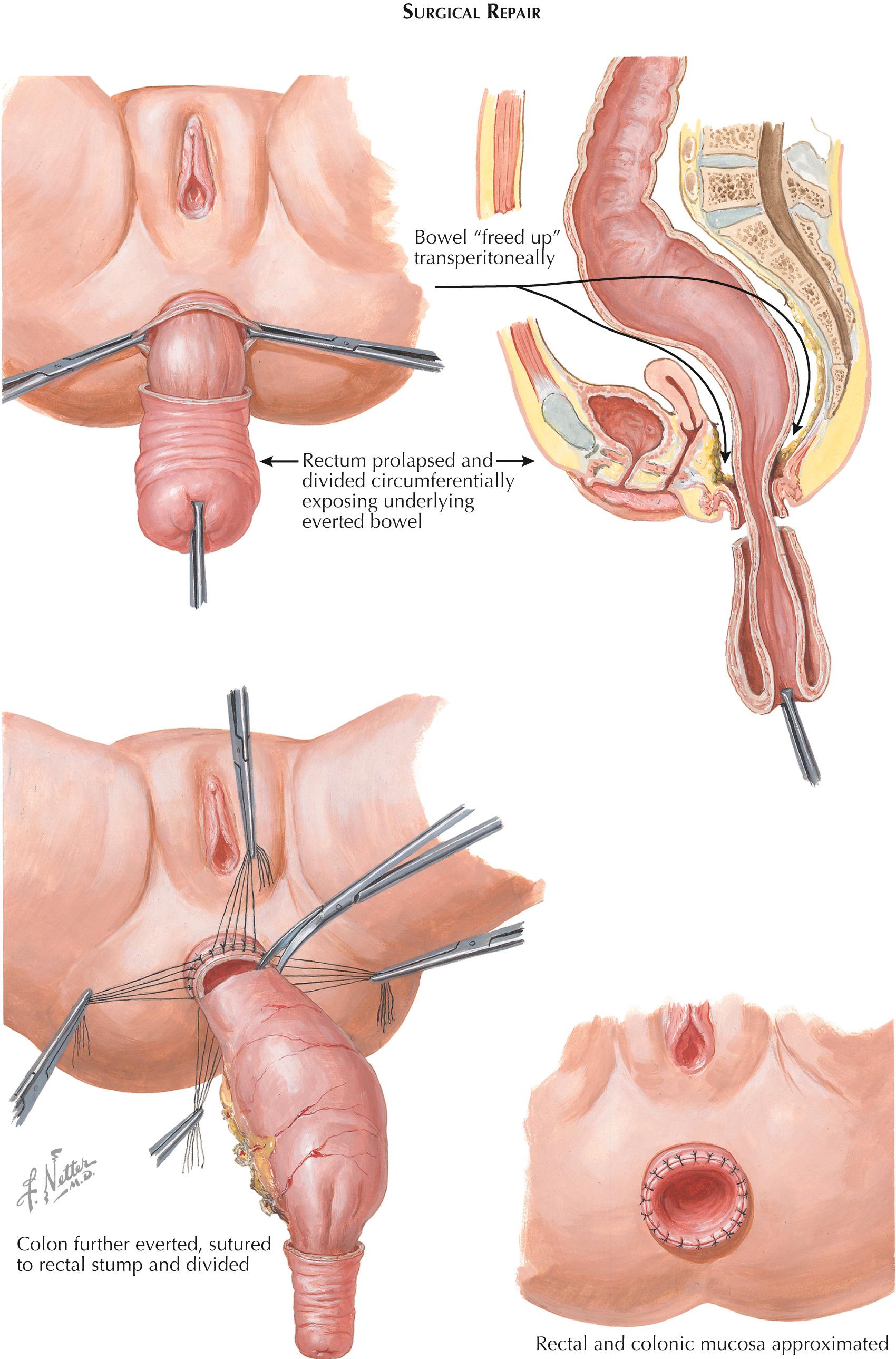
Megacolon is a descriptive term that has come to be used for a number of clinical entities in which the colon is dilated, hypertrophied, or redundant. It can be either a congenital or an acquired disorder. Hirschsprung disease (HD) is a congenital disorder caused by the absence of ganglion cells in the myenteric and submucosal plexuses of the colon. This disorder, with an incidence of 1 : 5000 live births, is more prevalent in boys. HD, which is sometimes called aganglionic megacolon, results from the failure of neural crest cells to reach their normal destination and differentiate into the ganglion cells of the enteric nervous system. This local neural circuitry plays a key role in regulating intestinal motility. In the absence of ganglion cells, the affected region of the colon becomes spastic, resulting in a pseudoobstruction that causes extreme dilatation of the colonic segment immediately proximal to the aganglionic region. The length of the affected segment can vary, but it always terminates at the dentate line of the rectum, allowing for minimally invasive biopsies to be performed.
Diagnoses of HD are usually made in the neonatal period (>80%) in a child presenting with bilious emesis, abdominal distention, and a failure to pass meconium during the first 48 hours. In older children, constipation is the symptom that drives the parent to seek medical advice. Severe functional constipation brings far more children to medical attention than does HD, and the differential diagnosis requires discrimination between these two conditions. Although great variations in clinical signs and symptoms are expected, the typical situations are readily categorized. The child with chronic functional constipation usually appears healthy and is reaching growth milestones, whereas the child with HD is more likely to be chronically ill, have a protuberant abdomen, and exhibit signs of malnutrition in growth and development. Children with HD often have a history of delayed passage of meconium (> 36 hours) after birth. Frequently, the history includes a statement that the child has “never had a normal bowel movement.” Enemas, laxatives, and other therapies are not effective. Occasionally, “diarrhea” has been noted, which is better described as liquid bowel content seeping around a fecal impaction. Unlike functional constipation, HD is never associated with passage of very large caliber stools.
On physical examination, the functionally constipated child has a relatively normal abdomen, in which firm fecal masses may be felt in the sigmoid colon. On rectal examination, the sphincter may be normal or loose, and feces are encountered at the sphincter or, if the bowel has recently been evacuated, the rectal ampulla may seem to have a large capacity. The child with HD, on the other hand, has a large abdomen, and its musculature is somewhat lacking in tone. Tremendous fecal impaction of the bowel is palpable. Rectal examination reveals a tight sphincter; the rectal canal is often empty and of normal caliber, and if feces can be felt at all, they are encountered more typically high up at the point of junction between the rectosigmoid and the rectal ampulla.
On the basis of the history, signs, and symptoms, the diagnostician can distinguish most HD from chronic constipation. Plain x-ray and barium enema may be helpful. Contrast enema examinations will be normal in the first 3 months of life and can be normal in appearance with total colonic disease. In HD, the barium enters a colon of normal caliber and flows a short or long distance to a point where a sudden transition to an enlarged colon occurs. This transition is abrupt and may occur at any point in the large bowel. In the typical case, the aganglionic segment is distal and does not extend proximal to the splenic flexure. On attempted evacuation in the patient with HD, most of the barium remains behind, and the transition is prominent because peristalsis is normal to that point but absent distal to it.
Anorectal manometry can be performed; in HD, there will be an absence of the rectoanal inhibitory reflex. This reflex normally represents relaxation of the internal anal sphincter with air insufflation. Biopsy is diagnostic, and in contrast to the historical approach shown in Plate 3-28 , should be performed at least 1.5 cm above the dentate line because the normal distal rectum may lack ganglion cells. This minimally invasive procedure can be performed without anesthesia because of the absence of somatic innervation in this region. The diagnosis of HD is confirmed by the absence of ganglion cells, the presence of thickened nerve fibers, and increased cholinesterase staining.
The only current treatment that alleviates the clinical syndrome of HD is surgery. There are several surgical approaches described in the literature. Recently, there has been a trend toward performing a single-stage surgical repair in the neonatal period without the need for a colostomy. There are now three variations of this basic surgical procedure. In the original Swenson procedure, the bowel is dissected to the distended portion, and biopsies are examined by frozen section to identify ganglionic colon proximal to the transitional zone. The aganglionic segment is then pulled through, and healthy colon is anastomosed above the dentate line, after which the aganglionic segment is resected. In the Soave procedure, dissection is done in the plane between the submucosa and muscularis layers of the colon, leaving a cuff of muscle around the pull-through segment. The muscular cuff is transected to prevent spastic contraction. Lastly, in the Duhamel procedure, the ganglionic segment is dropped down and anastomosed posterior to the aganglionic native rectum, creating a pouchlike structure. There remains controversy about the merits of each of these procedures. Proponents of the latter procedures believe that they are more likely to preserve sacral outflow and sphincter function, thereby preventing incontinence. Advocates of the Swenson procedure counter that there is little risk of iatrogenic injury if the plane of dissection is kept close to the rectum. Depending on the preference and experience of the surgeon, these procedures can either be performed with laparoscopic assistance or entirely via a transanal approach.
Although surgical repair of HD has markedly improved in recent years, there is still significant morbidity in these patients, depending on the length of the aganglionic segment and the surgical repair technique. These include fecal incontinence, constipation, and susceptibility to enterocolitis. As an alternative approach to surgery, there are a number of studies underway examining the ability of stem cells to reconstitute the enteric nervous system in an aganglionic segment of the colon. Sources of cells for transplant being studied include pluripotent stem cells derived from the CNS, neural crest, or enteric nervous system. Following transplantation, it has been demonstrated that stem cells can survive, proliferate, and differentiate into enteric neurons. Although considerable obstacles remain, these studies provide hope for the eventual development of stem cell therapies as a nonsurgical alternative in the treatment of HD.
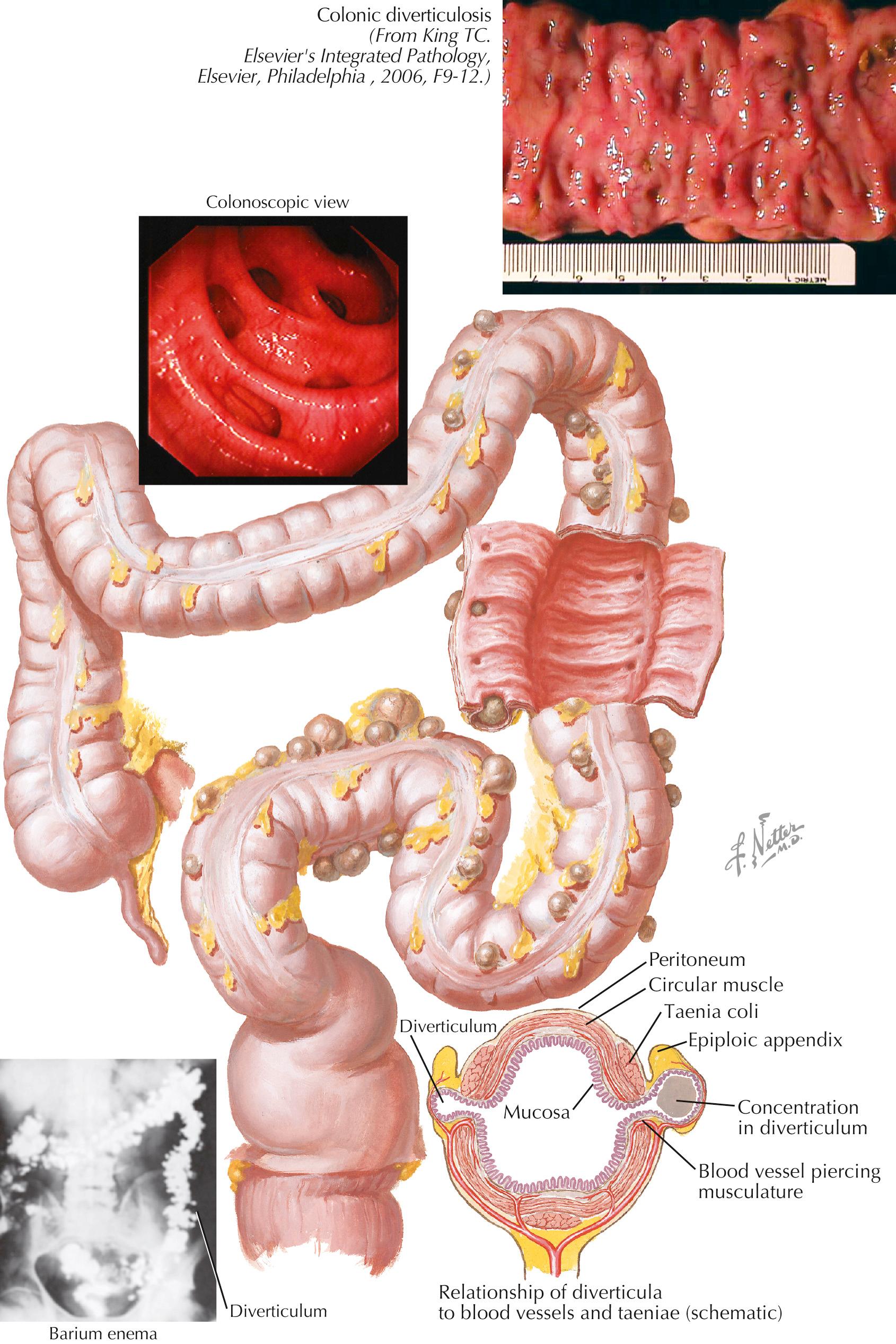
Diverticulosis of the colon is an acquired condition that results from herniation of the mucosa through defects in the muscle coats. The defects are usually located at sites where the blood vessels pierce the muscular wall to gain access to the submucous plane. These vessels, the long circular arteries, enter at a very constant position just on the mesenteric side of the two lateral taeniae coli, so diverticula commonly occur in two parallel rows along the bowel. The appendices epiploicae are also situated in this part of the circumference; thus diverticula frequently enter the base of the appendices epiploicae.
Diverticula are thought to arise from weak areas in the wall of the colon and a differential in pressure between the lumen and the serosa. Localized areas of high pressure may be susceptible to their formation. A defect in cholinergic innervation may contribute as well. Obesity and constipation may be aggravating factors but are not the primary causes.
Diverticula do not occur in the rectum but may be found throughout the whole length of the colon. They are, however, much more common on the left side and most frequently affect the sigmoid colon. Diverticulosis is rare before age 40 years, but its incidence increases with age, and it occurs in about 10% of persons of middle age, being more common in males. After age 40 years, diverticula become more prevalent in females.
Diverticula of the colon are flask shaped, with a narrow neck through the muscle wall and a wider body. Because the wall lacks a muscular layer, diverticula are actually “pseudodiverticula”; they are unable to expel any fecal material that enters them, and the material tends to harden within the sacs into firm concretions. The mucosa of the diverticulum may become ulcerated or devascularized by the hard fecalith, and organisms may enter the tissues and cause infection, which leads to the various forms of diverticulitis.
The diagnosis of diverticulosis is commonly made by colonoscopy but may be demonstrated on CT scan or contrast study. Contrast studies are most useful in cases without active inflammation to identify the distribution of diverticula and resolution of inflammation. Clinically, diverticulosis is a symptomless condition, with symptoms arising in about 10% to 20% of cases. No active treatment is usually recommended for the patient with incidentally discovered diverticulosis.
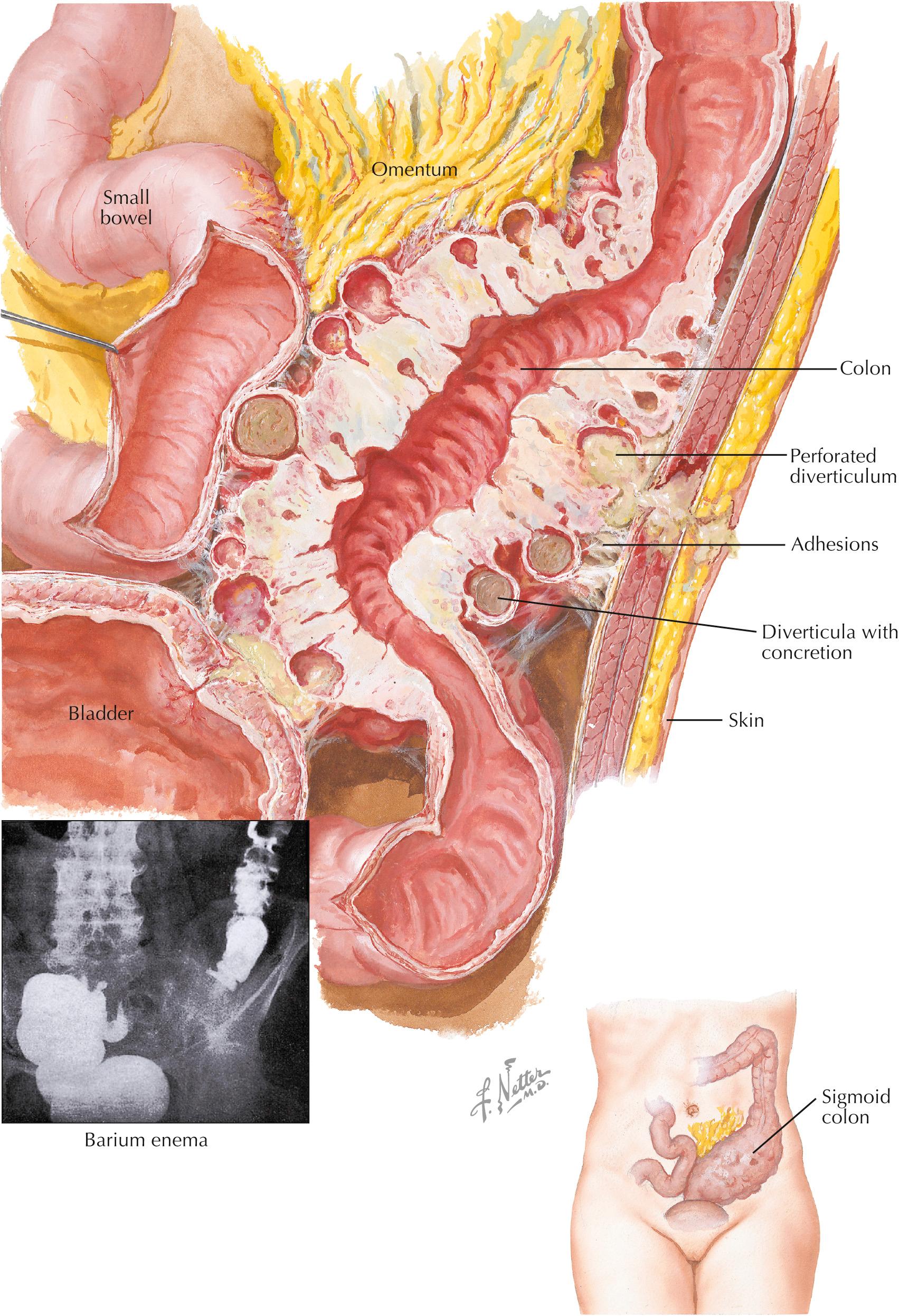
Inflammation in and around the diverticula occurs in only a small percentage of patients with diverticulosis. The manner in which infection may arise has been discussed on Plate 3-30 . Once infection occurs around one or more diverticula, the subsequent course varies according to the virulence of the organism and the resistance of the patient. Acute inflammation, in which all structures of the intestinal wall participate, may follow and terminate in perforation, leading to general peritonitis; more commonly, a localized abscess forms, sealed off by the abdominal wall, omentum, and other viscera. A more usual course is that of a low-grade inflammatory process (peridiverticulitis), which leads to the formation of fibrofatty tissue around the affected part of the bowel, resulting in narrowing of its lumen, shortening of the loop, and adherence of the loop to nearby structures. This thickening may extend over several inches of bowel, giving rise to a firm, tender mass along the line of the colon. Within this thickened tissue, infection persists, and recurrent activity of inflammation may lead to the further extension of small abscesses, which may open into the organs walling off the infection. In this way, fistulae may form on the anterior abdominal wall, or in the bladder , small bowel , or female pelvic organs.
The complications that may follow diverticulitis are, therefore, obstruction of the colon, more usually partial and chronic than complete; free perforation and general peritonitis; abscess formation; and the occurrence of internal or external fistulae. The most common is the formation of a vesicocolic fistula, which gives rise to persistent infection of the urinary tract; it rarely occurs in women, owing to the interposition of the uterus.
Clinically, acute diverticulitis presents with pyrexia and pain in the left lower quadrant of the abdomen, and examination will reveal a tender mass in that area, the lower edge of which may also be palpable per rectum. Patients with chronic diverticulitis usually complain of dull or recurrent pain in the same region, often associated with some alteration of bowel habits, a sense of distention, and dyspepsia. Bleeding is unusual but is said to occur in about 10% of patients. Examination may reveal some tender enlargement of the sigmoid colon, and sigmoidoscopy may show rigidity and edema of the bowel above the rectosigmoid junction. Should a vesicocolic fistula form, the classic symptom is pneumaturia, often associated with pain on micturition and with frequency of urination. An enterocolic fistula may give rise to severe diarrhea.
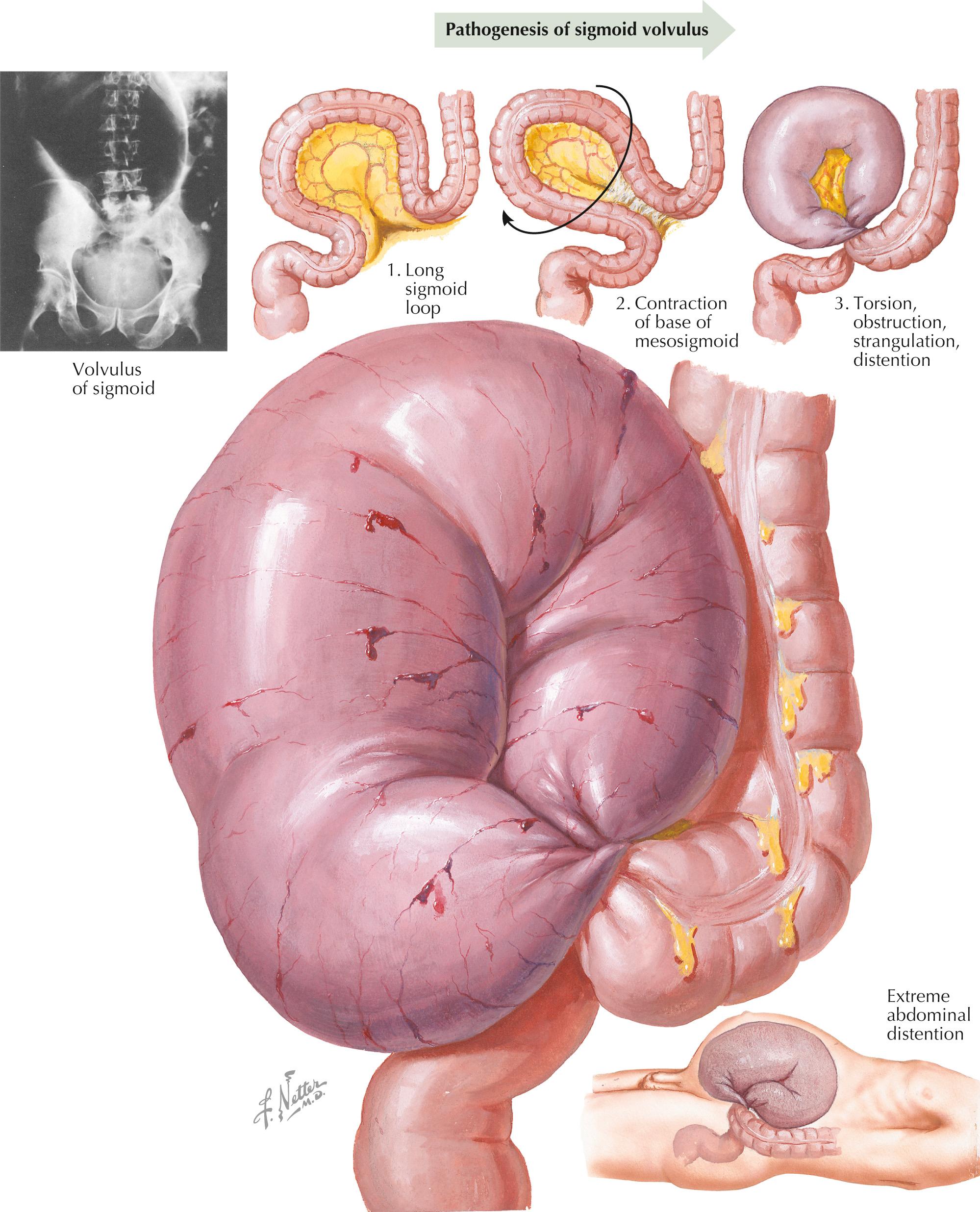
Primary volvulus of the colon occurs only in the sigmoid colon and in the cecum, because the other parts of the large bowel are well fixed to the posterior abdominal wall. Volvulus is a comparatively rare form of intestinal obstruction in the Western world, usually occurring in elderly or institutionalized patients, commonly with neuropsychiatric disorders. It is more common in Eastern Europe and Asia, and it is probable that the difference in incidence is due mainly to different dietary habits. A bulky vegetable diet is more common in less-developed and poorer parts of the world, and this diet results in a bigger fecal residue, which leads to a persistently loaded colon. In time, the loaded sigmoid colon may become chronically distended and elongated, and, as it elongates, its two ends tend to approximate, resulting in a narrower mesenteric attachment. Some fibrosis often occurs in the base of the mesosigmoid, accentuating the narrow base. These are the essential predisposing features of a volvulus, and, once they exist, the actual precipitating cause is often trivial, such as straining or coughing.
In its early stages a volvulus produces a “check-valve” effect, allowing flatus and some fluid feces to enter the loop but not allowing them to leave it. In this way, great and rapid distention is produced. If the twist becomes tighter, a complete “closed-loop” obstruction develops, and pressure on the vessels in the mesentery may lead to impairment of blood supply and gangrene of the bowel.
Clinically, the onset of the symptoms and signs of a sigmoid volvulus is usually sudden, with lower abdominal pain; constipation is absolute, but sometimes tenesmus with passage of a little mucus may occur. Vomiting is unusual. The general condition is commonly well maintained unless infarction and gangrene of the loop have started, in which case blood and fluid loss soon lead to shock. Distention occurs early, progresses rapidly, and is always a dominant part of the clinical picture; within a few hours it may be extreme, and no other features may be observed on abdominal examination.
The most valuable aid to diagnosis is plain x-ray of the abdomen, with the patient in both the erect and supine positions. A single, enormous, gas-filled loop containing a little fluid is usually revealed, giving a characteristic picture known as the coffee bean sign. Contrast enema may reveal a bird's beak deformity at the point of the volvulus, and may also be therapeutic. CT scan may demonstrate a mesenteric whorl.
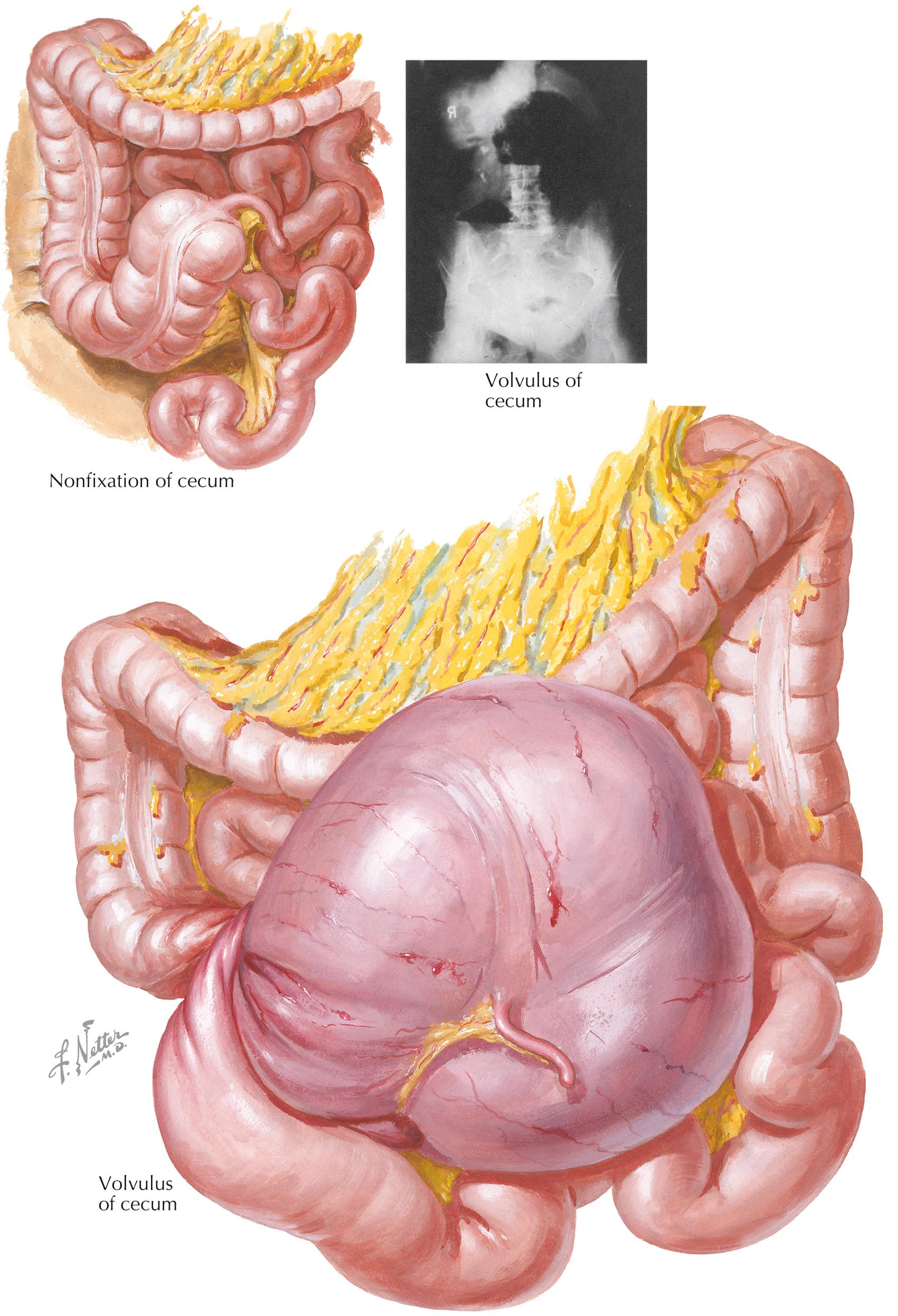
Volvulus of the cecum is an infrequent condition in the Western part of the world, accounting for only about 1% of the cases of intestinal obstruction. Like volvulus of the sigmoid colon, it appears to be more common in those parts of the world in which vegetables and roughage form a greater part of the diet, and it is thought that persistent loading of the bowel with a big fecal residue may also play a part in causing this condition. Cecal volvulus is also seen more commonly in patients with a history of chronic constipation, use of cathartics, pregnancy, or prior surgery. This problem occurs more commonly in females but can occur in any age group, with a mean age of presentation in the fourth decade.
The predisposing factor is inadequate fixation of the cecum and ascending colon to the posterior abdominal wall. Normally, in the third stage of intestinal rotation, the cecum descends from the subhepatic region to lie in the right iliac fossa, and the ascending colon and most of the cecum become fixed to the posterior abdominal wall. If this last process is not fully completed, the cecum, a few inches of ascending colon, and a few inches of terminal ileum may be attached by a mesentery with a relatively short base and may then be free to rotate around this axis. Should a twist occur, all these parts of the intestine are involved, and the condition should really be called volvulus of the ileocecal segment.
As in volvulus of the sigmoid, the twist may not be tight at first and may untwist spontaneously. At this stage, the check-valve effect will tend to lead to rapid distention of the cecum. If the twist becomes tighter, complete closed-loop obstruction is produced, and, finally, strangulation of the vessels will result in gangrene of the bowel, which is likely to occur more rapidly with a volvulus of the cecum than with that of the sigmoid.
The onset is sudden, with severe central abdominal pain, and vomiting soon follows. The pain is constant, but intermittent “griping” pains also occur. Examination reveals some general abdominal distention as a result of an obstruction in the lower part of the small intestine, and in most cases the distended cecum may be distinguished as a palpable tympanitic swelling in the central part of the abdomen. On palpation a feeling of emptiness in the right iliac fossa may be encountered. The most valuable aid to diagnosis is the plain x-ray film. If the x-ray study has been made with the patient in an erect position, the greatly distended kidney bean–shaped area, with perhaps a fluid level within it, is very conspicuous; distention of loops of ileum above the point of obstruction may also be recognizable. CT scan may show a whorl of the mesentery as in sigmoid volvulus. In the case of cecal volvulus, contrast enema can be performed to rule out a distal obstructing lesion, but is contraindicated for reduction.
Nonoperative management of cecal volvulus is much less successful than sigmoid volvulus. Less than 30% of patients have successful colonoscopic decompression. There should also be concern about insufflating gas into the obstructed segment, which may cause the ischemia to worsen. As soon as the diagnosis of cecal volvulus is made, a laparotomy is typically indicated. If possible, the bowel should be untwisted. If the bowel is viable after untwisting, and if the patient's condition permits, it is advisable to try to fix the cecum in its correct position with a few carefully placed sutures; the recurrence rate is 30% to 40%, and this procedure may be technically difficult to perform because the cecal wall has become thinned out as a result of distention. If the bowel is not viable or viability is doubtful, performing immediate resection and anastomosis is the wiser course.
Cases of partial volvulus with spontaneous untwisting occur, giving rise to recurrent attacks of lower abdominal pain. In such instances, the diagnosis may be difficult, but the cause of the repeated attacks usually becomes apparent if laparotomy is undertaken; fixation of the cecum will prevent further attacks.
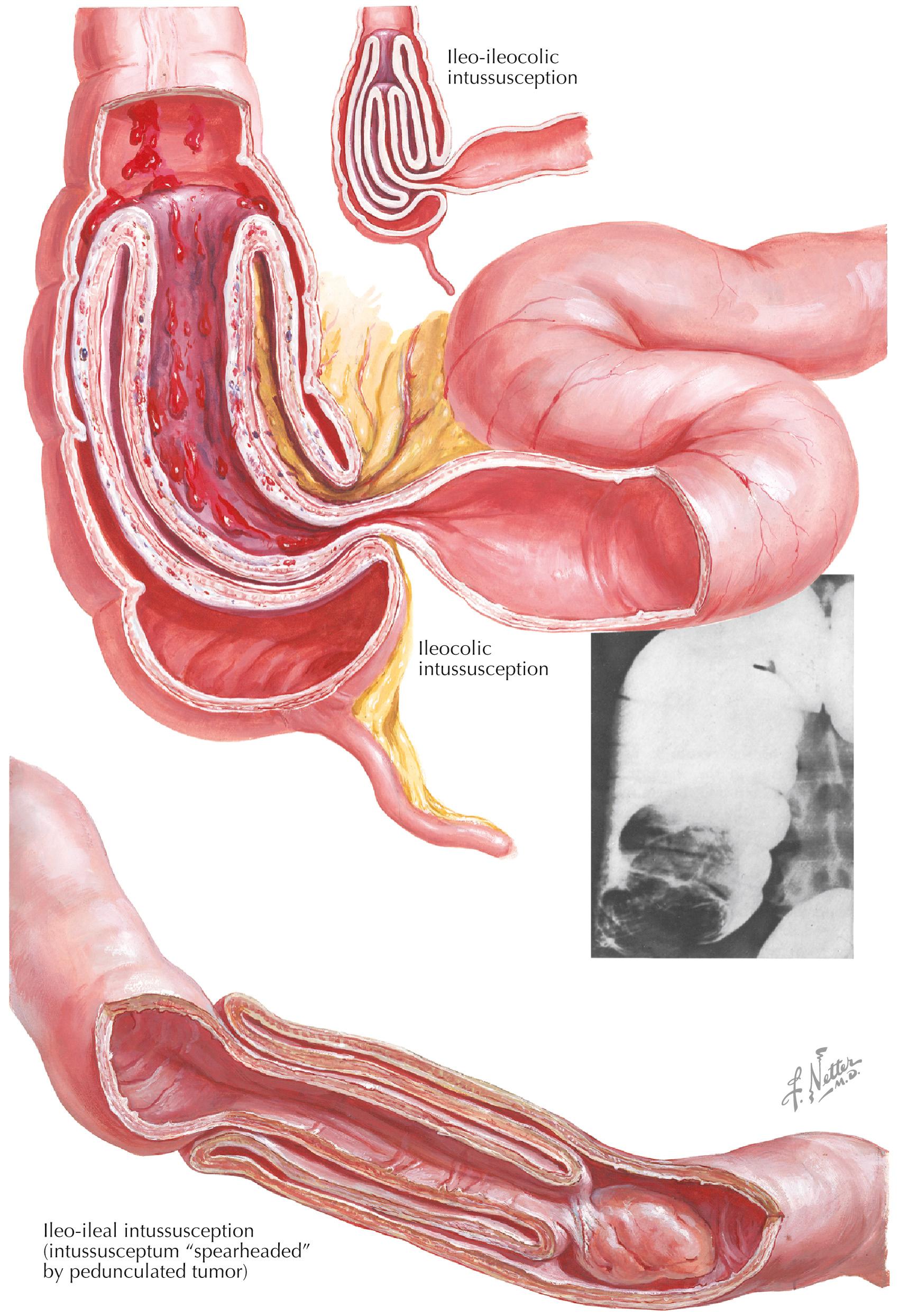
Intussusception is, by definition, the invagination of a portion of the intestine into the contiguous distal segment of the enteric tube. Much has been speculated about the cause of this condition. The fact that intussusception occurs more frequently at 4 to 10 months of age suggests that the change from a pure milk diet to a more solid one plays a role by altering intestinal peristalsis in such a way that the intussusception is initiated. Acute enteritis, allergic reactions, and intestinal spasms—in short, any condition with hypermotility—may result in an invagination. In older individuals it may be a polyp, an enlarged Peyer patch, or a diverticulum of Meckel that may mark the site at which the wall of the proximal segment turns and intrudes into its neighboring distal part. Whatever the etiologic factor may be, it remains undiscovered in more than 90% of cases.
Intussusceptions are classified according to the part of the digestive tube that telescopes, the intussusceptum, into the intussuscipiens, that is, the receiving part. Thus, one may encounter an ileoileal invagination, jejunoileal invagination, and so on. The most frequent of them is the ileocolic (ileocecal) intussusception. A kind of double invagination or an intussusception within an intussusception (e.g., ileoileocolic intussusception ) may also occur. How far the intussusceptum enters the intussuscipiens depends upon the length and motility of its mesentery, which, furthermore, is easily compressed and then causes the development of edema, peritoneal exudation, vascular strangulation, and, finally, intestinal gangrene.
The clinical manifestations of the disease are almost always alarming and usually begin rather suddenly in children who are generally normal, well developed, and well nourished. Colicky abdominal pains recur, as a rule, at intervals of 15 to 20 minutes and are accompanied by signs of acute shock, the child becoming extremely pallid. During the intervals, the patient seems to recover, relaxes, and behaves as if nothing had happened. In about 85% of cases, a movable mass may be palpated in the abdomen, which can always be confirmed by rectal examination. In the more advanced stage of the disease, bloody stools are found, the sudden appearance of which may be considered pathognomonic. In children, diagnosis can be made with air contrast enema, which can also be therapeutic. No further intervention is required if the condition resolves.
In adults, the presentation is variable, and the classic signs seen in children of bloody diarrhea, mass, and pain are not seen. Many will present with symptoms of a partial bowel obstruction, often with recurrent attacks. Barium enema may show a lesion, but CT scan is the most accurate method of diagnosis. The classic target sign or sausagelike mass is characteristically seen. Surgical resection is necessary given the concern for a malignant tumor acting as the lead point. Primary anastomosis is typically feasible with minimal complications. Resection is typically performed in those patients who have a spontaneous reduction of their intussusception preoperatively. Intraoperative reduction may facilitate a limited resection, particularly when the lesion is known to be benign preoperatively.
In general, the prognosis of this disease is favorable. The mortality rates after laparotomy and resection have decreased significantly in recent decades and will improve further with the ability to arrive at an early diagnosis and with increasing knowledge of supportive therapy.
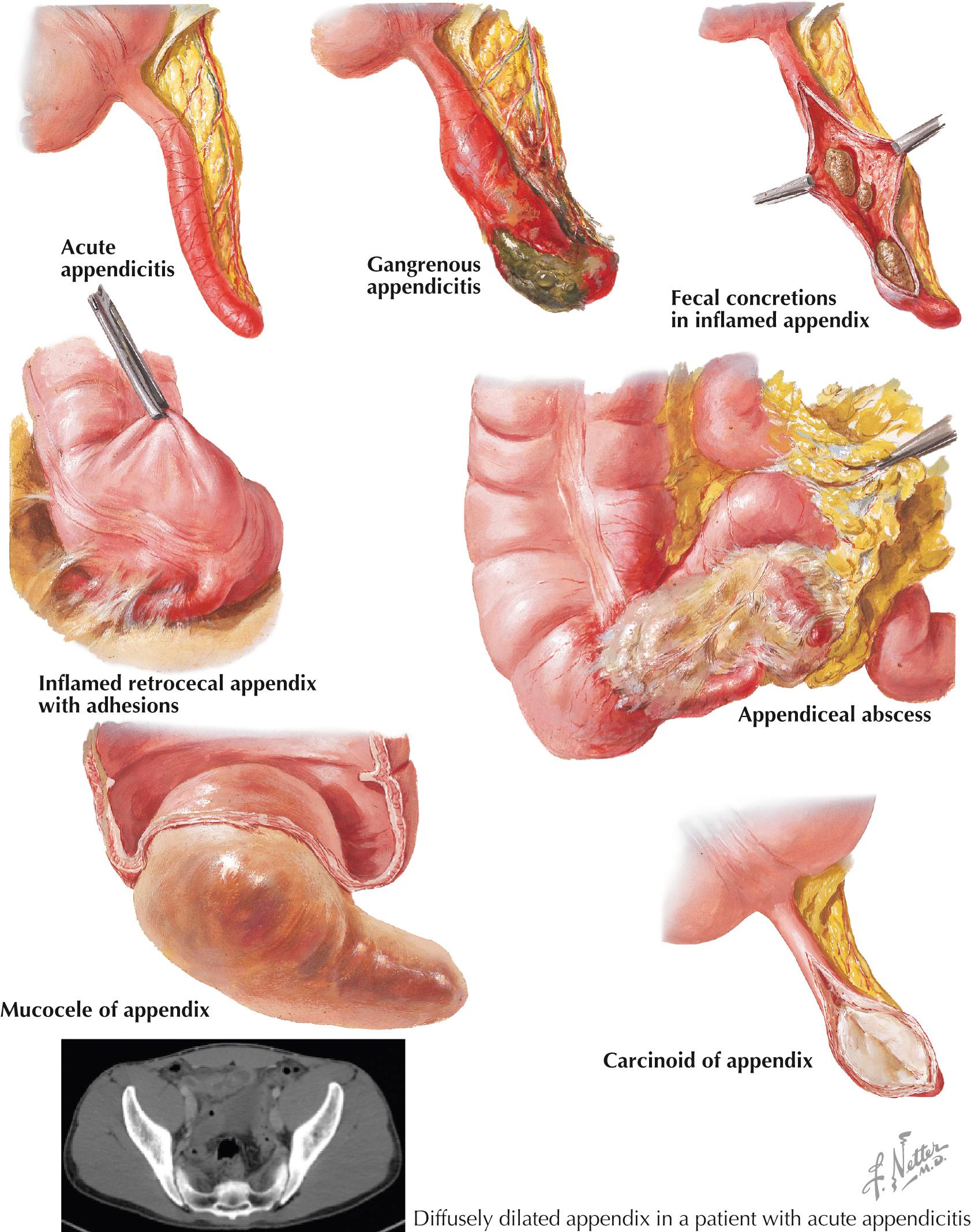
Acute appendicitis is a common surgical emergency and a frequent cause of an acute abdomen.
The vermiform appendix is located near the ileocecal valve and at the base of the cecum. Although the base of the appendix is always attached to the cecum, its tip may migrate to different positions. These variations can complicate the clinical presentation of appendicitis with regard to pain location.
Acute appendicitis starts with inflammation of the lining of the vermiform appendix and can progress with inflammation of the submucosa and the other layers. The appendix appears thickened and enlarged, and the lumen is filled with mucopurulent material. Abscess formation and perforation with peritonitis may follow.
The incidence is highest in the second and third decades of life. It is also higher in men than women.
Infection and obstruction are the most important exciting factors. Obstruction of the appendiceal lumen has been proposed as the initial step in the pathogenesis of appendicitis. This can increase the intraluminal pressure, with subsequent occlusion of the small vessels, leading to ischemia and necrosis of the appendix. Inflammation, followed by ischemia, perforation with subsequent development of an abscess, or generalized peritonitis, may follow.
The classic presentation consists of anorexia, periumbilical abdominal pain that subsequently migrates to the right lower quadrant (pain location may vary), nausea, and vomiting. A change in bowel habits can be seen in some patients. Loss of appetite is considered one of the classic presentations. Fever, abdominal tenderness, rebound tenderness; guarding, and rigidity are some of the physical examination findings.
Although there is no specific laboratory test for appendicitis, the following can help confirm the diagnosis or exclude other possible diagnoses: complete blood count, C-reactive protein, urinalysis (to differentiate from urinary tract infection), and liver and pancreas chemistry tests. In women of child-bearing age, a pregnancy test should be considered, with recognition that acute appendicitis is one of the most common surgical emergencies in pregnancy.
Imaging studies play a major role in the diagnosis of acute appendicitis. Ultrasonography is a safe imaging modality to confirm the diagnosis of appendicitis. A healthy appendix cannot usually be seen with ultrasound, and an appendiceal diameter of more than 6 mm is an accurate finding for acute appendicitis. If ultrasound imaging is negative or inconclusive, a CT scan is usually obtained. CT scanning is the most important imaging test in the evaluation of patients with atypical presentations.
Urologic and gynecologic conditions, Crohn disease, acute infectious ileitis, and diverticulitis should be considered in the differential diagnosis of patients presenting with the symptoms of acute appendicitis.
Patients should be given nothing by mouth while receiving intravenous hydration. Analgesics and antiemetics should be administered as needed.
The only cure for appendicitis is appendectomy, which can be performed either by laparoscopy or open laparotomy, based on the surgeon's experience, patient's body habitus and age, and severity of the disease, among other factors. Percutaneous drainage followed by appendectomy in a few weeks is needed in some cases.
Patients with chronic appendicitis have prolonged (> 7 days) symptoms. The white blood cell count is usually normal. Appendectomy resolves the pain in most patients.
The incidence of appendiceal tumors in appendectomy specimens is approximately 1%. The most common tumors include carcinoid tumors, cystic neoplasms, and adenocarcinoma, but rarely, nonepithelial tumors (neuroma, lipoma, leiomyoma, lymphoma, and others) can be seen in the appendix.
Carcinoid tumors, which are neuroendocrine tumors, are the most common appendiceal tumors. Some secrete serotonin or other vasoactive substances, which can play a role in the associated clinical symptoms. Appendectomy is the standard treatment in most cases; hemicolectomy is indicated if the lesion is larger than 2 cm or in cases of nodal involvement.
Mucoceles are characterized by a mucus-filled, distended appendix and can be benign or malignant. Surgical resection should be considered because of the possibility of harboring cystadenocarcinoma. Pseudomyxoma peritonei is a clinical syndrome resulting from mucin deposits within the peritoneal cavity. Repeated debulking surgeries are the standard treatment in most symptomatic patients.
Although a minority of patients with acute appendicitis have adenocarcinoma, the majority of patients with adenocarcinoma present with acute appendicitis. Right hemicolectomy is usually the standard of care.
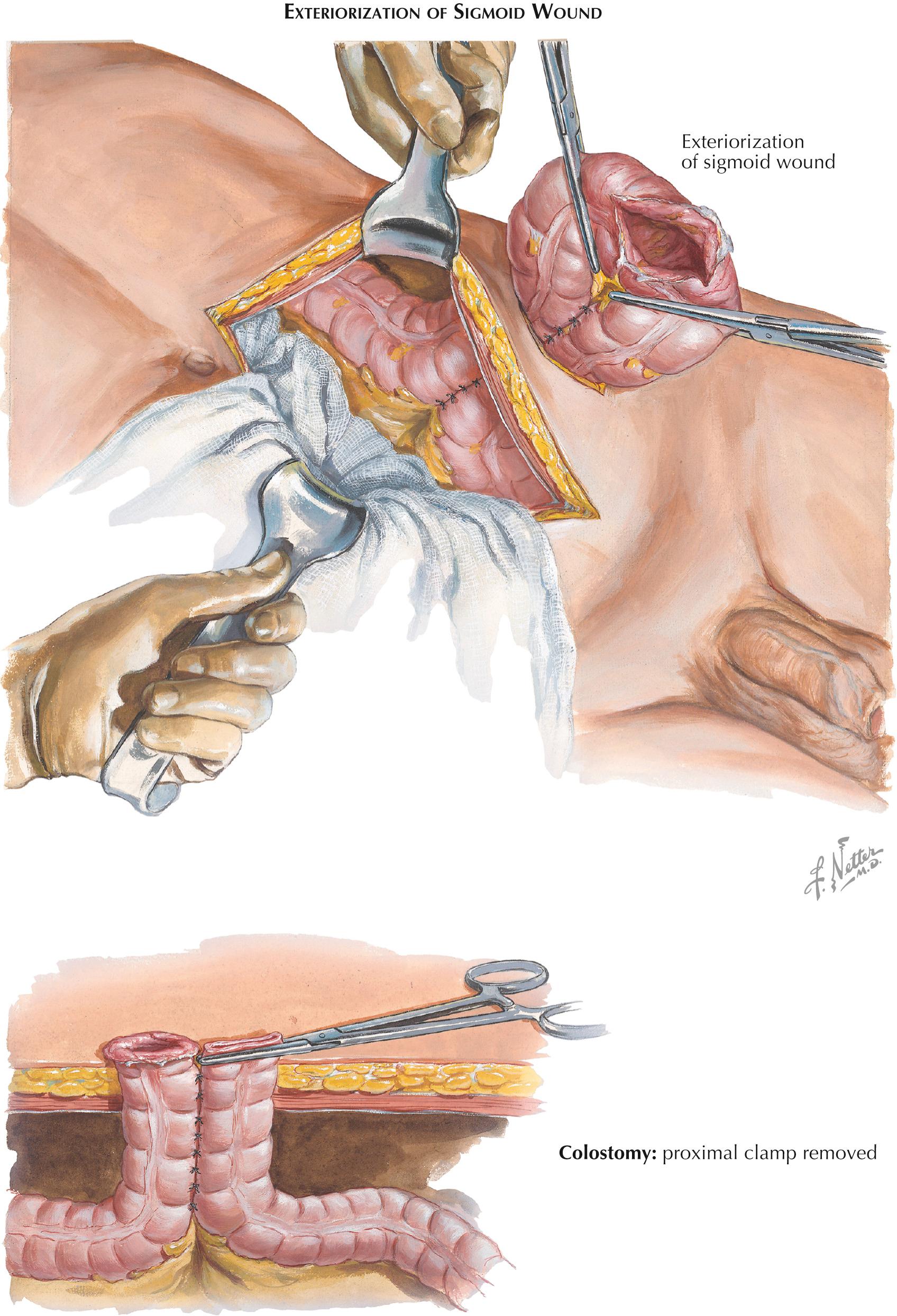
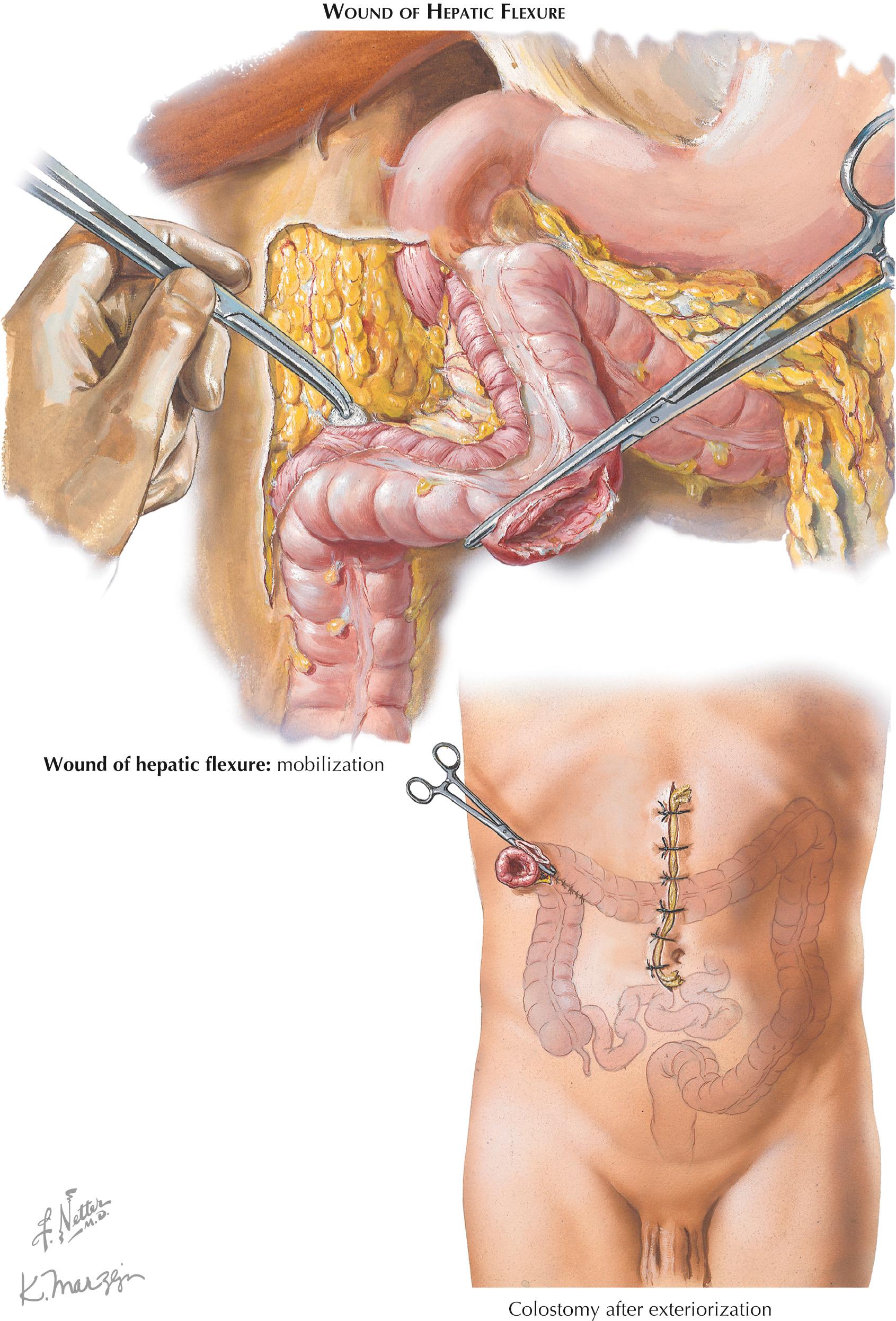
Injuries to the colon are commonly iatrogenic or traumatic. Patients receiving certain medications may be more susceptible to spontaneous perforations of the colon. Other procedures, such as endoscopy, may be potential causes of perforation.
Chronic steroid therapy has been shown to be complicated by acute perforation of the gastrointestinal tract since the 1950s. The perforations typically occur in unusual locations in an otherwise normal length of colon. Because of a lack of overt symptoms early and a resulting delay in treatment, mortality rates range from 85% to 100%. Higher mortality rates have been associated with prednisone given in higher doses. Many of the natural defenses are impaired with chronic steroid use. Free perforation without an inflammatory response to wall off the area of soilage may occur. Steroids also may impair mucosal regeneration, which may cause the lymphoid elements to atrophy and the bowel wall to become thin and more susceptible to perforation.
Colonoscopic polypectomy has a 10% rate of associated complications, with about 75% of these being minor in severity. Over 90% can be managed nonoperatively. Perforation of the colon may occur due to maneuvering the colonoscope or from polypectomy. Often these perforations will become sealed off and can be managed nonoperatively in stable patients owing to the fact that these injuries occur in a mechanically clean bowel. Patients are initially managed with bowel rest, systemic antibiotics, and fluid resuscitation and are monitored clinically. If they have continued symptoms that do not respond to these measures, they will require surgical intervention. Typically, simple closure can be performed, but occasionally, segmental resection with primary anastomosis, with or without fecal diversion, is needed. Outcomes are best when the perforation is recognized within 24 hours. Overall, the mortality rate ranges from 2.9% to 25% in these cases. Laparoscopic and endoscopic repairs have also been performed for these complications.
Injuries to the abdomen may be seen as a result of combat and war. In some reports, mortality rates related to abdominal war wounds dropped from 53% during World War I to 18% to 36% in World War II, with a further drop to nearly 10% during the Vietnam War in some limited hospital series. Other data collected from the Vietnam War showed that the mortality rate for 476 abdominal casualties reached 42%.
In patients who are victims of penetrating or blunt trauma with unrecognized colorectal injuries, the injuries can be significant causes of death. Being able to quickly identify an acute abdomen or pathologic condition that requires operative intervention is key to reducing the mortality rate in this patient population. Even in intubated patients, physical examination findings such as guarding or rebound should be apparent. Injuries of the colon vary from isolated bruised areas to large perforations or extensive, ragged tears, with infarction. In contrast to the small bowel, wounds of the colon are less likely to be multiple. Isolated bruised areas are occasionally found remote from the tract of the inflicting agent, and in some cases, the outer layer of the bowel wall will be found ruptured and stripped back from the intact mucosal layer. Multiple lesions, when present, usually involve the flexures and pelvic colon. Small lesions involving the ascending and descending portions of the colon may be intraperitoneal or extraperitoneal and are particularly grave, because they may be easily overlooked and because of the vulnerability of the retroperitoneal tissues to anaerobic infection. Wounds of the colon are frequently associated with injuries to other viscera in the injured region.
The clinical symptoms of wounds of the colon and those of the small bowel are practically the same. Uncomplicated wounds and small perforations, especially if they are extraperitoneal, may cause few early symptoms, so that thorough exploration of a suspected area is essential. Shock is usually apparent if the wound is a large one.
In small, uncomplicated wounds involving the more distal part of the bowel, the prognosis is more favorable if spillage of semisolid fecal material is slight and if surgery is performed early.
If there is concern for an intraabdominal injury, broad-spectrum antibiotics should be given. Patients found to have pelvic fractures should elicit concern for associated colorectal injury. A digital rectal examination is essential for every trauma patient to assess for a colorectal injury as well. For hemodynamically stable patients, CT scanning will provide a thorough assessment of the abdomen. Focused abdominal sonogram for trauma examination is a reliable assessment for patients who cannot undergo CT scanning because of instability, or it may be used in conjunction with CT scanning for a thorough evaluation. The incidence of a colorectal injury with blunt trauma is approximately 0.3%. Diagnosis is often made at laparotomy for another cause.
Damage control techniques for dealing with traumatic injuries have significantly improved the mortality rates after laparotomy. In these procedures, packing is performed for nonsurgical bleeding, with selective ligation of vessels and bowel resection without anastomosis or stoma formation to terminate a procedure quickly. Once coagulopathy begins, the procedure should be terminated with the intent to return after resuscitation and control of the coagulopathy.
Operative intervention should be performed via a midline laparotomy. The primary intent should be to stabilize or stop ongoing blood loss. Then attention can be turned to detection and management of other injuries. Treatment options for colonic injury include proximal diversion and repair, exteriorization of the wound as a colostomy, simple suture repair, or resection with anastomosis. Judgment must be exercised to determine the best course of action given the mechanism of injury.
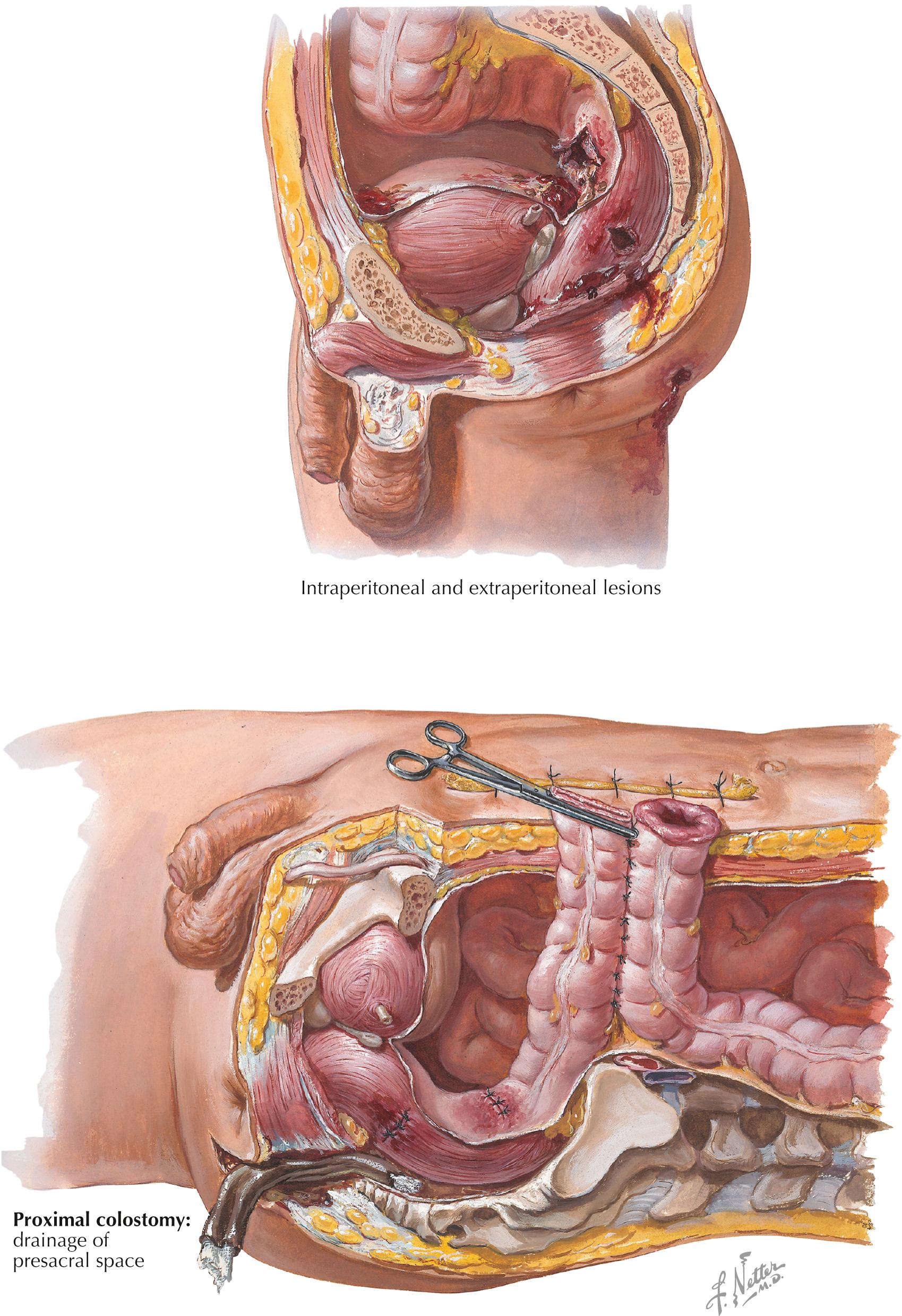
Injuries of the rectum occur less frequently than those of other abdominal viscera but are particularly important because of their gravity. In World War I they made up 2.4% of all abdominal injuries. In World War II the incidence of rectal injuries among abdominal injuries was 3.7%. Rectal trauma is often associated with lesions of the bladder, the pelvic colon, and the small intestine. Other causes of penetrating rectal trauma include stab wounds, accidental (e.g., all-terrain vehicle accident) or intentional impalement, foreign bodies, or iatrogenic causes.
Wounds of the rectum vary in type and extent. They may be extraperitoneal or intraperitoneal, or both. The lesion often consists of a small perforation, produced by a small missile or a fragment of pelvic bone, or an extensive laceration produced by shell fragments of high explosives or land mines. The entrance wound in such injuries frequently is located posteriorly or posterolaterally in the thigh or buttocks and may deceptively suggest that the bowel has been missed. In some cases, damage to tissues externally is extensive, with tearing and laceration of the gluteal region and destruction of the anus and lower rectum. In others, the anal region remains intact, the injury being limited to the lower portion of the rectum. These cases are particularly dangerous because of infection in the extraperitoneal perirectal region. Rectal injuries are especially prone to anaerobic infection. The intraperitoneal portion of the rectum can also be injured in cases in which the missile has entered from behind or from the side. Such wounds are not infrequently associated with fracture of the bones of the pelvis. These cases are commonly accompanied by injury of the bladder or small bowel. In addition to peritonitis, danger of infection in the presacral areolar tissue is associated.
Intraperitoneal rectal injuries are diagnosed and treated in a fashion similar to colonic injuries. If an injury is in the extraperitoneal rectum, it may be difficult to diagnose. Such injuries usually become apparent after signs of infection develop, typically over the next 24 hours. Patients should be managed with intravenous broad-spectrum antibiotics, and diagnosis confirmed with an examination or imaging. Sigmoidoscopy should be used if there is blood in the rectum on digital rectal examination or if there is a bladder, urethral, vaginal, or pelvic injury that causes concern for an associated rectal injury.
The mortality rate in World War I for wounds of the rectum was 45%, but in World War II this figure was reduced to 23%. During the Vietnam War, distal rectal washout was employed, resulting in reduced mortality rates. Shock, fulminating infection in the retroperitoneal space, and peritonitis are the most common causes of death.
The treatment of rectal injuries consists essentially of débridement of the external wound, repairing the bowel, providing adequate drainage of the retrorectal space whenever needed, and diverting the fecal stream by temporary colostomy. In cases where there is a delay in diagnosis, diversion is preferred with a washout of the perirectal area.
The opening in the bowel should be closed by suture whenever possible. Drainage of the retroperitoneal tissues is necessary. Exploratory laparotomy should be done in practically all cases, and injuries to other viscera should be properly treated. Openings in the intraperitoneal portion of the rectum should be closed by suture.
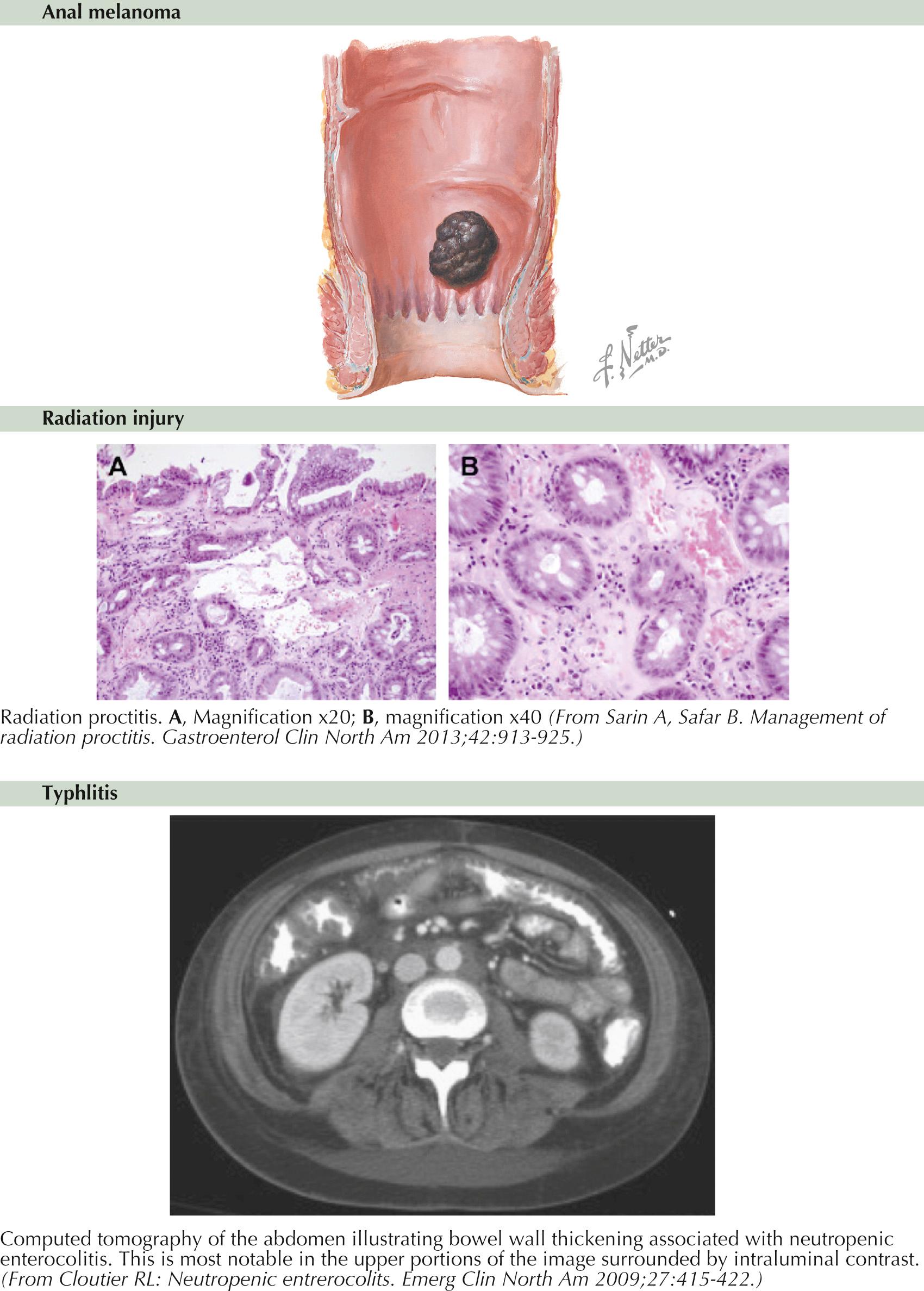
Melanoma of the anal canal is rare. Its varied presentations may involve a mass, pain, or bleeding. It may be incidentally discovered on resection of another lesion such as a hemorrhoid, particularly if it is the amelanotic type, which occurs in approximately 25% of cases. Only 256 new cases were documented between 1985 and 1994 in the National Cancer Database. The median age at diagnosis is 60 years, and the disease is more commonly seen in women, with metastatic disease often present at the time of diagnosis.
The overall prognosis is poor, with 5-year survival rates ranging from 0% to 32% if the disease is metastatic or locally contained. Treatment requires an R0 resection (complete removal of the tumor, with microscopic evaluation of the margins showing no tumor cells), which often will require an abdominoperineal resection, but local excision may be adequate for many patients. Better 5-year survival rates are seen if negative margins are obtained with surgery. Sentinel lymph node biopsy has not been shown to be effective in the staging of anal melanoma. Use of adjuvant chemotherapy and irradiation is unproven, but case reports have shown greater regional control after radiation therapy when complete excision can be performed.
Given the rapid turnover of intestinal epithelia, the colon and small intestine are at significant risk for radiation injury. Radiation therapy results in mucosal atrophy, with decreased crypt height in the colon and rectum. Mucosal injury also occurs in the areas that lie within the field of radiation. Diarrhea and hematochezia often occur because of resultant colitis or proctitis.
Effects of irradiation can be delayed in onset, and occur months or years after exposure. Fibrosis, strictures, fistulas, and telangiectasias may occur. Imaging with barium enema may help identify the extent of strictures. Bacterial overgrowth may occur, necessitating the use of antibiotics. Dilation of strictures may also be necessary. Surgery should be reserved for refractory strictures or fistulas because the associated morbidity is significant; it may lead to difficulty in healing due to impaired blood supply.
Typhlitis, also known as neutropenic enterocolitis, is a complication that occurs in patients receiving cytotoxic chemotherapy; it may be life-threatening. It may also occur in patients with aplastic anemia, cyclic neutropenia, or after autologous stem cell transplantation, but it is felt to be most commonly associated with treatment for leukemia and lymphoma. Typically, it occurs in the cecum, ascending colon, and terminal ileum. A spectrum of mucosal and submucosal necrosis with hemorrhage and ulceration may be seen.
Clinically, patients present with fever, abdominal pain, and diarrhea in the presence of neutropenia. Patients may also experience nausea, vomiting, hematochezia, and abdominal distention. Symptoms typically begin about 7 to 9 days after the onset of neutropenia. Other diagnoses that need to be considered in the differential diagnosis include any other cause of acute abdominal pain, including appendicitis, diverticulitis, and ischemic colitis.
Laboratory studies are typically not helpful in making the diagnosis, but polymicrobial infection may be revealed on blood culture. A paucity of gas may be seen in the right lower quadrant on abdominal x-ray, with dilated small bowel loops, thumbprinting, pneumatosis intestinalis, and free air, or the films may appear normal. Ultrasound and CT scan are typically more sensitive and may show bowel wall thickening, a fluid-filled, dilated cecum, ascites, phlegmon, pericolic fluid, or pneumatosis or free air in severe cases.
Treatment usually consists of aggressive medical therapy, including bowel rest, hydration, nasogastric suction, and broad-spectrum antibiotic coverage. Patients should be observed closely for clinical signs of deterioration. Surgery is recommended for patients who have perforation, persistent bleeding, or clinical deterioration suggestive of uncontrolled sepsis. Typically, resection with proximal ostomy is performed. Often, clinical improvement is not seen until there is recovery of the neutrophil count. This can be hastened with the use of recombinant granulocyte colony-stimulating factor. Chemotherapy can be resumed when patients have completely recovered.
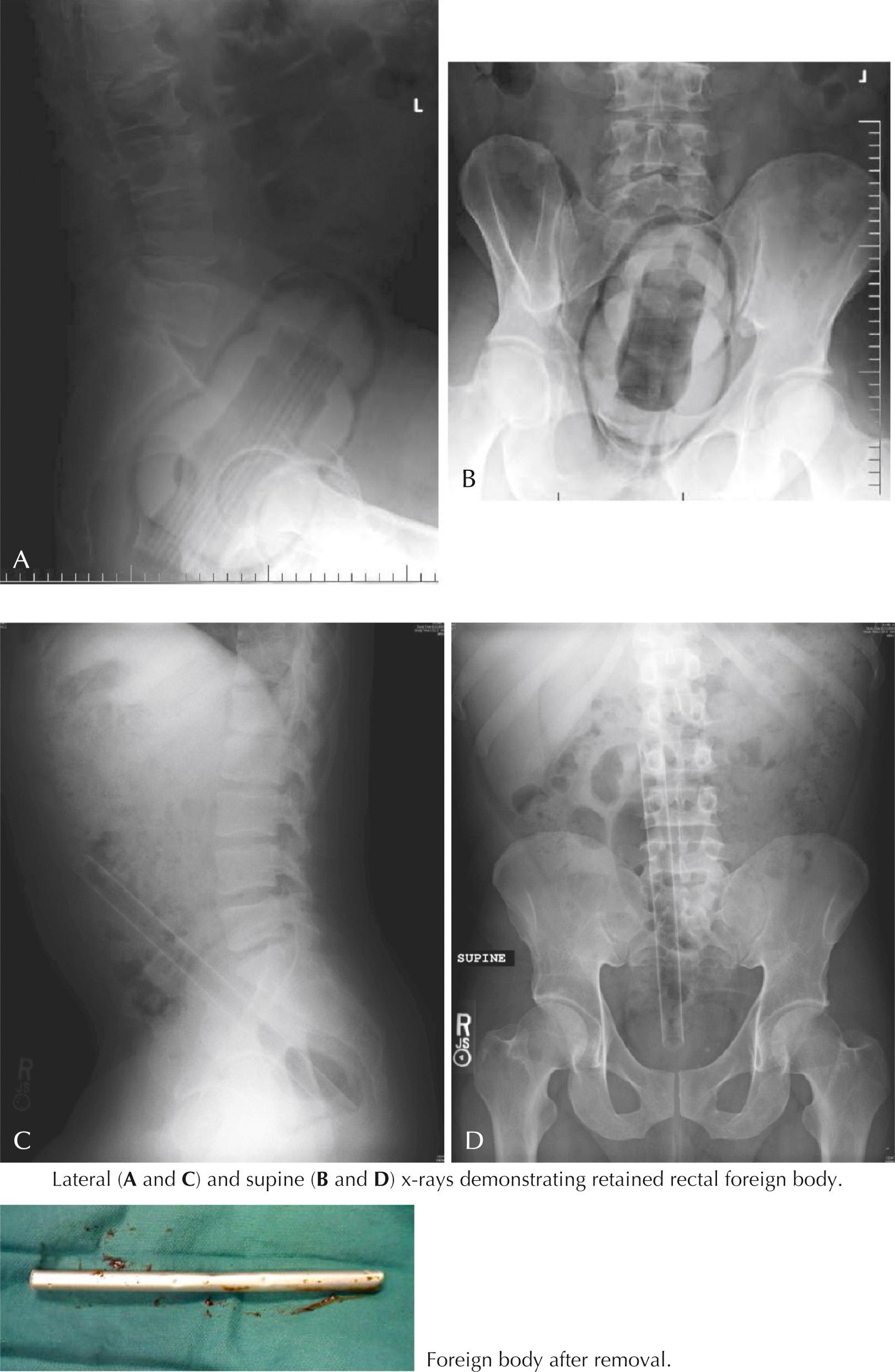
Patients with anorectal foreign bodies are often reluctant to present to known physicians and so will present to the emergency room after some delay. These foreign bodies may have been placed transanally for therapeutic or for sexual purposes. Rectal foreign bodies can also be a result of oral ingestion as seen in body packing. The most commonly reported items are cylindrically shaped, but items such as balls, vibrators, foods (fruits and vegetables), and bottles have been removed. Rarely, rectal thermometers have accidentally broken with a retained portion beyond the anal canal. Patients will usually have tried to remove the object prior to presentation to the emergency room and may fabricate stories to explain what happened. Suspicion for abuse or assault should be triggered. A systematic approach to diagnosis and management is essential due to the varied nature of foreign bodies and outcomes. Concern should remain for delayed perforation or significant bleeding even after extraction. The majority of patients are males 30 to 40 years of age.
First, determination should be made as to whether perforation has occurred. If a patient is unstable, resuscitation and broad-spectrum antibiotics should be immediately initiated prior to surgical exploration. If the patient is stable, a CT scan can be performed to determine whether a perforation has been sustained. Perforations may occur into the extraperitoneal space below the peritoneal reflection, and so care should be taken to make the diagnosis.
For extraction, patient relaxation with a perianal nerve block, spinal anesthetic, and/or conscious sedation should be undertaken. With the patient in the lithotomy position, a rectal examination can be performed with downward abdominal pressure to facilitate extraction if needed. A plain film should be taken after the extraction to ensure that no perforation developed as a result. Proctosigmoidoscopy should be performed after removal to determine whether there is any damage to the mucosa of the colon or rectum.
If transanal extraction is not possible even with general anesthesia, exploration via laparotomy is indicated. Attempts may be made to push the object distally and extract it transanally. If this is unsuccessful, a colostomy can be performed to remove the object with a primary closure. If there is a perforation identified, proximal diversion may be necessary. Traumatic disruption to the anal sphincter may result in fecal incontinence. Surgical intervention for this should be delayed until adequate time has passed to allow a full evaluation of clinical symptoms.
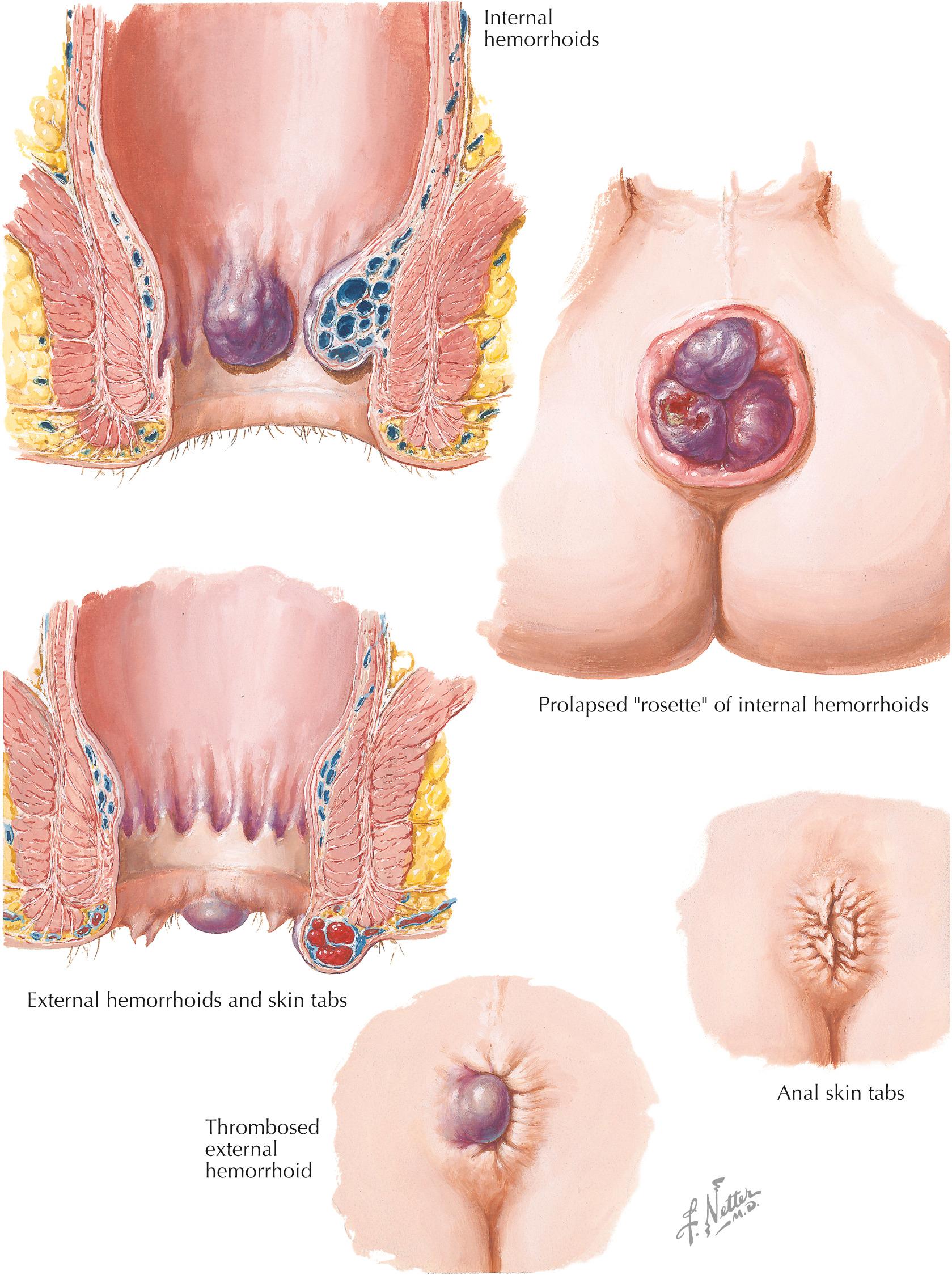
Hemorrhoids are varicose dilatations of the radicles of the hemorrhoidal (rectal) veins, in either the superior or the inferior plexuses, or both, accompanied in varying degrees by hypertrophy and round cell infiltration of the perivascular connective tissue. Hemorrhoids are present in about 35% of the population. They usually occur between the ages of 25 and 55 years, and only seldom under the age of 15 years. Both sexes are affected equally.
To explain the formation of hemorrhoids, a great variety of factors have been considered. A hereditary predisposition seems to play a role in some individuals. Erect posture, the absence of valves in the portal venous system, the arrangement of the collecting veins in the rectal submucosal space with the veins being susceptible to compression in passing through the anorectal musculature, and other biologic and anatomic conditions are contributory elements. More direct causes are all the various events that produce transient or constant increased pressure or stasis within the rectal venous plexuses, such as straining at stools because of constipation or diarrhea, tumors or strictures of the rectum, pregnancy, tumors and retroversion of the uterus, hypertrophy and tumors of the prostate, and portal hypertension.
External and internal hemorrhoids must be differentiated by anatomic location. Varicosities of the inferior hemorrhoidal plexus present as external hemorrhoids, situated below the pectinate line and covered by the modified skin of the anus. Thrombotic external hemorrhoids are an acute variety of external hemorrhoids, resulting from the formation of a thrombus within a vein or, more frequently, from the rupture of a vein with extravasation of blood into the cellular tissue, constituting, strictly speaking, a hematoma. The thrombotic variety occurs usually as the result of strain. The patient complains of a sudden painful lump at the anus, and inspection reveals a rounded, bluish, tender swelling. Thrombosed external hemorrhoids finally result in so-called skin tags, consisting of one or more folds of the anal skin and composed of connective tissue and a few blood vessels. Skin tags may form also by imperfect healing of the skin after hemorrhoidectomy or as a consequence of an inflammatory process in the anal region.
Internal hemorrhoids are varicose enlargements of the veins of the superior hemorrhoidal plexus. In the early stage (first degree), they do not protrude through the anal canal and can be detected only by proctoscopy, where they appear as globular, reddish swellings. The superior rectal veins being fairly constantly distributed, internal hemorrhoids are usually located in the right and left posterior and right anterior quadrants. Histologically, the walls of the dilated veins are atrophic and surrounded by a perivascular inflammatory infiltrate. In a later stage, internal hemorrhoids may protrude through the anal canal. Initially, the protrusion may occur only at defecation, receding afterward spontaneously (second degree); in time, the protrusion becomes more pronounced, occurring with exertion and receding only by manual reduction (third degree). Finally, the hemorrhoids may become permanently prolapsed, in which case the mucosal surface of the hemorrhoids is constantly subjected to trauma and may become ulcerated. Increased mucoid discharge may also cause irritation of the perianal skin, producing burning and itching.
The earliest symptom of internal hemorrhoids is usually intermittent bleeding, occurring during or following defecation. Pain is not a characteristic symptom, being present only in cases with complications (thrombosis, strangulation) or other concomitant conditions (fissure, abscess).
The so-called strangulated hemorrhoids constitute the most common and also the most painful complication of internal hemorrhoids. This complication occurs when the prolapsed hemorrhoids cannot be reduced because of sphincteric contractions and because of the blockage of the thrombosed internal varices by the simultaneously or subsequently thrombosed inferior hemorrhoidal veins.
Patients should be examined with anoscopy and proctosigmoidoscopy to determine the extent of hemorrhoidal tissue. The degree of prolapse can be evaluated by asking the patient to strain on the toilet. More proximal evaluation may be deemed necessary with further endoscopy.
For most, conservative management with fiber supplementation is the first-line treatment, to relieve constipation and the need for straining. Various over-the-counter ointments can be used as well to help with symptoms. Patients with advanced disease that does not respond to this conservative management may benefit from other interventions such as sclerotherapy, diathermy, or band ligation. Excisional hemorrhoidectomy should be reserved for patients who have failed more conservative measures and have significant symptoms, or have difficulty with anal hygiene. For some patients with prolapsing hemorrhoids, a pexy procedure using a device to place a purse-string suture transanally may be an alternative to surgical hemorrhoidectomy.
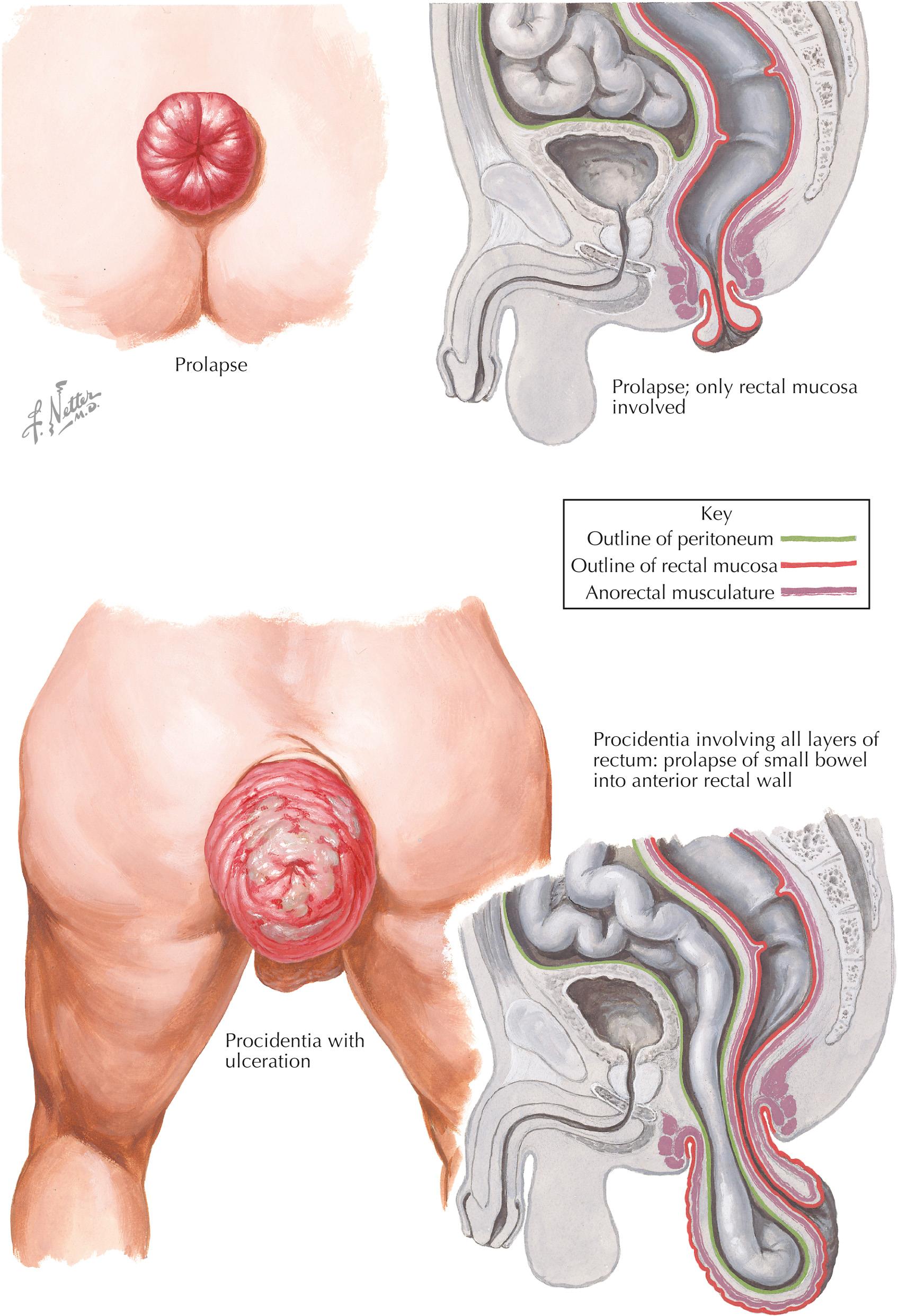
Prolapse of the rectum, as ordinarily understood, is a condition in which one or more layers of the rectum and/or the anal canal protrude through the anal orifice. A prolapse can be partial or complete. In partial prolapse (usually called simply prolapse ), only the mucosa is involved; it extends usually not more than
![]() to 1 inch. In total prolapse (called procidentia ), all the layers of the rectum are involved; it presents as a larger, bulbous mass, which may eventually contain a hernia sac of peritoneum with a segment of bowel in its interior.
to 1 inch. In total prolapse (called procidentia ), all the layers of the rectum are involved; it presents as a larger, bulbous mass, which may eventually contain a hernia sac of peritoneum with a segment of bowel in its interior.
In procidentia, in addition to the descent of the rectal tissues, an eversion of the lining of the anal canal takes place, so that the covering of the displaced tissues becomes continuous at approximately a right angle with the perianal skin. When only the rectal tissues descend while the anal structures remain in their normal position, a sulcus will surround the protruded rectum.
Sigmoidorectal intussusception (concealed or protruded) has been previously described as a procidentia, but this is, in fact, a different entity. The confusion arises when the intussusception protrudes through the anal orifice. However, digital examination will easily differentiate this condition from rectal procidentia. In the former the finger will pass into the rectal ampulla. In the latter the finger will meet a blind end in the anal canal, or the displaced tissue is continuous with the perianal skin.
The cause of prolapse and procidentia is unknown. A defect in one or more of the supporting structures of the anorectum seems to be the chief predisposing factor; it is not likely that increased abdominal pressure, in the absence of alterations in the supporting structures of the anorectum, will result in prolapse or procidentia.
Prolapse occurs most frequently in childhood and in old age. In children the majority of cases occur at 1 to 4 years of age, and a shallow sacral curve and reduction of the supporting fat, as may occur in wasting diseases, are the chief predisposing causes. In old or debilitated subjects, the prolapse is usually due to the loss of sphincter tone. It is obvious that some lesions within the bowel that drag down the mucosa, such as polyps, hemorrhoids, and tumors, and anatomic or neurologic disturbances of the sphincters may favor the occurrence of prolapse.
Procidentia may occur at any age, but it is uncommon in children. It is now commonly accepted that the disorder is, in reality, a sliding hernia of the pouch of Douglas through a weakened or damaged pelvic fascia and levator muscles, the occurrence of which is possibly favored by an abnormally mobile rectum. Attention has been called to the importance of some neurologic and rectal sensory factors related to the defecation mechanism. Faulty rectal sensation either as a result of poor interpretation of the normal stimulus or as a result of a neuromuscular abnormality with associated hypoexcitability may lead to a lack of coordination between the appreciation of the full-rectum stimulus and defecation.
The most common complaint in patients with prolapse or procidentia is the protrusion of a mass from the anus, during defecation or walking, which will become more and more difficult to reduce. Other symptoms are a sensation of fullness, soiling, incontinence, diarrhea, and bleeding.
The examination is best carried out with the patient in a standing or squatting position; the patient should be asked to strain so that the full extent of the protrusion can be observed. In prolapse the inspection reveals a relatively small mass with radially arranged folds. In procidentia the protruded mass is bulky, showing a congested, eventually ulcerated mucosa with folds arranged in a concentric pattern.
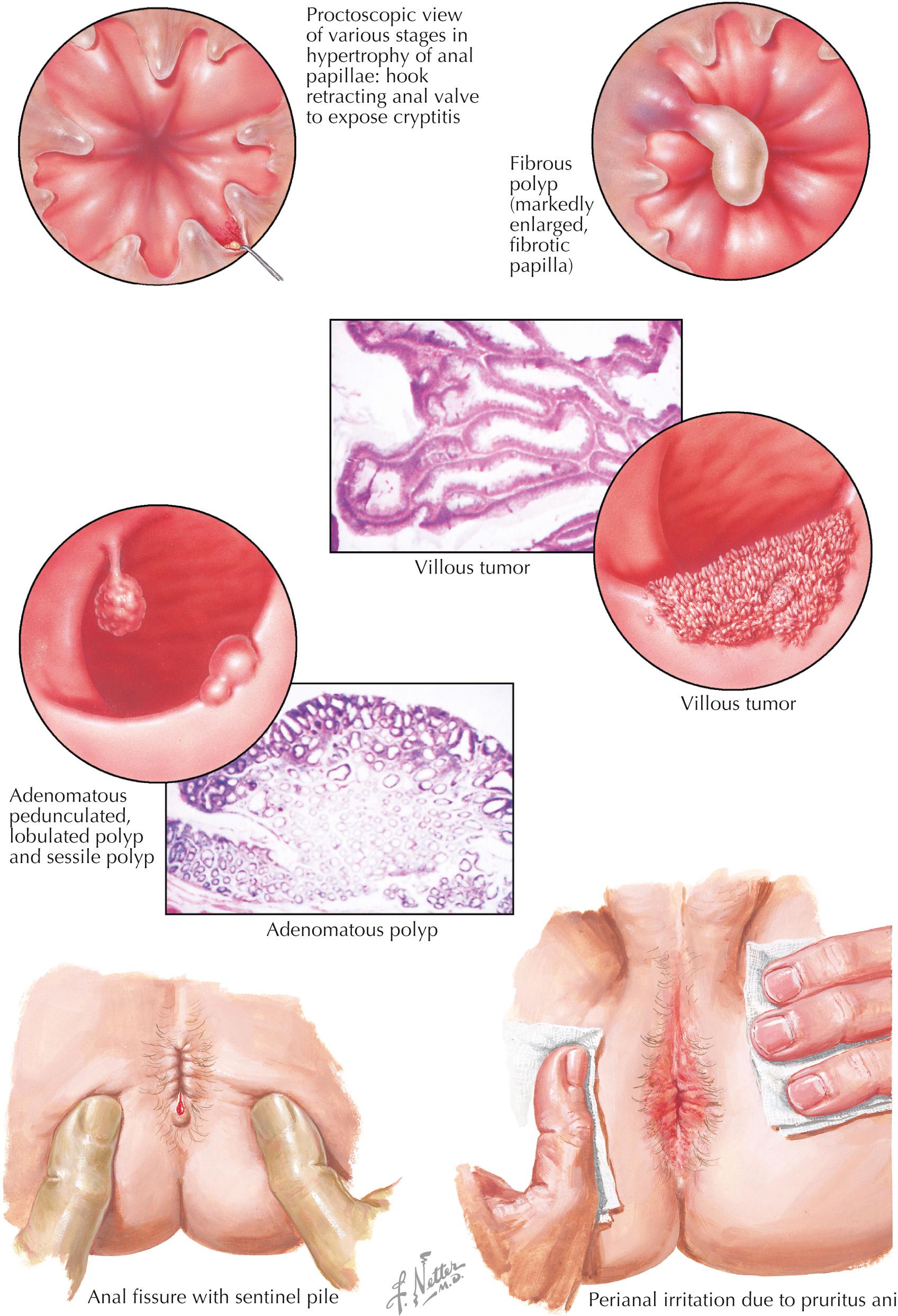
Inflammatory processes of the papillae, which usually start in one of the crypts, give rise to extreme pain (and tenesmus) out of all proportion to the size and severity of the lesion. In acute papillitis, the structure is swollen, edematous, and congested, becoming later, in the chronic stage of the papillitis, fibrosed and hypertrophied. Gradually, the hypertrophic papilla may develop a stalk and may change into a so-called fibrous polyp, which may produce the sensation of a foreign body in the anal canal, a dissatisfied feeling after defecation, itching, and objective signs of irritation.
The crypts of Morgagni, in which fecal material can collect and which are continuously exposed to trauma, become easily involved in infectious inflammatory processes. The cryptitis may remain restricted to circumscribed reactions in and around the crypts or may spread to the surrounding tissues, inducing the formation of abscesses and fistulae. The symptoms of cryptitis (sometimes resembling those of a fissure [ phantom fissure ]) are anal formication, itching, and radiating pain, which are aggravated by defecation and ambulation. Anoscopy, under anesthesia, permits recognition of the affected crypt, a purulent discharge or granulation tissue, and enlargement of the related papilla.
Benign tumors of epithelial origin occur in the rectum in two varieties, the simple adenomatous polyp and the villous tumor (also termed papilloma, papillary tumor, papillary adenoma, papillary polyp, villous polyp, and villoma). The usually lobulated adenomatous polyps may be sessile or pedunculated; they may vary in size from a few millimeters up to about 2 cm in diameter, only rarely becoming larger. The less common villous tumor is mostly attached to the mucosa by means of numerous papillary stalks and is soft and velvety to the touch. Both of these benign epithelial tumors tend to undergo malignant degeneration and may manifest themselves by bleeding, mucous discharge, diarrhea, tenesmus, and protrusion through the anal canal.
An anal fissure is a crack or splitlike ulcer of the anal canal lining below the pectinate line, extending often as far as the anal verge. It starts rather suddenly, and the lesion is usually associated with severe pain. If untreated, it tends to run a course of exacerbations and remissions. Fissures occur at all ages, particularly in middle life, and somewhat more frequently in women. When single, an anal fissure is most commonly located at the posterior commissure. Multiple fissures, also more frequent in women, usually involve the anterior and posterior commissures and only rarely the lateral margins. Mechanical traumatic factors (overdistention of the anal canal at defecation) and anal infection are the most frequent pathogenic causes. The typical anal fissure is racket shaped and has sharply defined edges; at the lower, wider, rounded end, the skin frequently forms an edematous tab (sentinel pile); the upper end, quite close to the anal valves, is often guarded by one or two hypertrophied papillae. Pain related to defecation is the main symptom; occurring during passage of the stools or shortly thereafter, it may be extremely severe and may persist for some time. The diagnosis can be made by simple inspection of the anus.
Pruritus ani is a symptom that may accompany every known anorectal disease, as well as other organic or systemic affections. Most commonly, however, no evident primary cause is found. Perianal itching without any apparent cause (by some authors believed to be a neurodermatitis, by others simply designated as “cryptogenetic”) is usually more intense at night in bed and during warm weather. The perianal skin is hyperemic and will show superficial abrasions from scratching. In more chronic cases, a whitish discoloration of the skin, accentuation of the folds, rhagades, lichenification, hyperkeratosis, and patchy parakeratosis are characteristic.
Become a Clinical Tree membership for Full access and enjoy Unlimited articles
If you are a member. Log in here